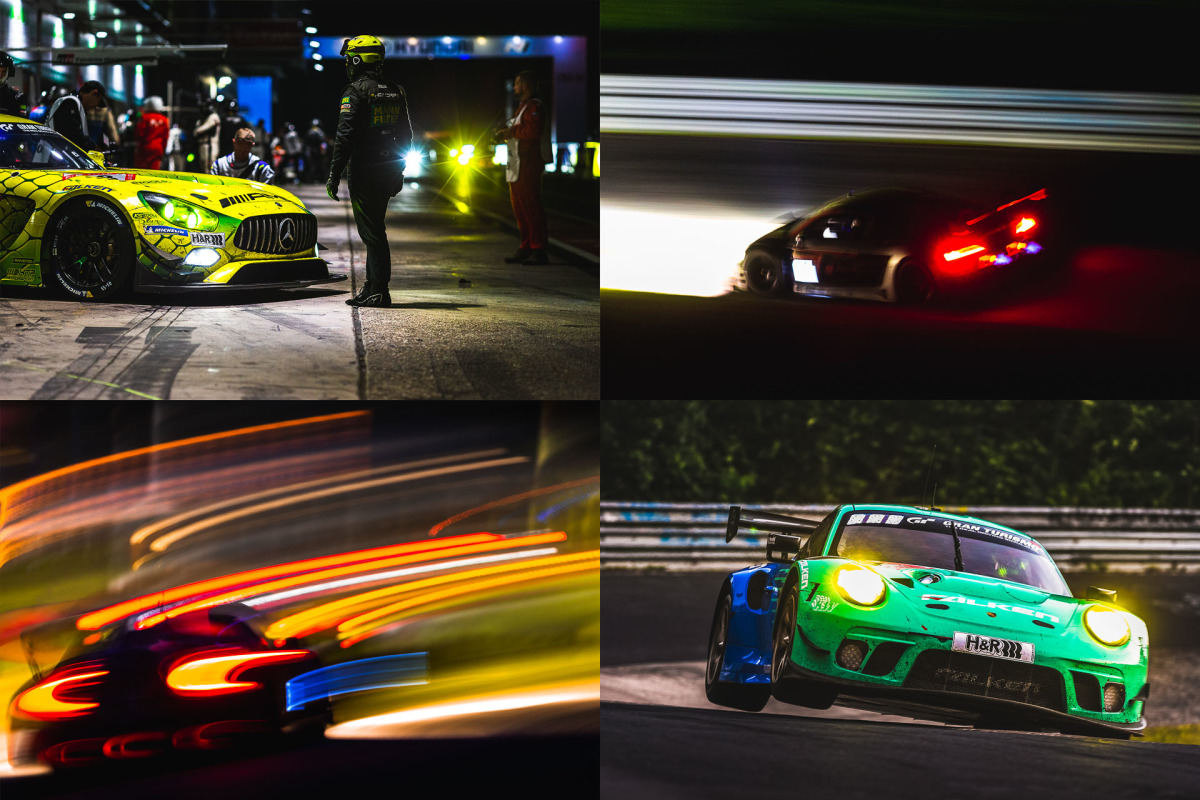
Shooting the 24 Hours of Nürburgring has been the highlight of my year behind the camera thus far, there’s no two ways about that.
In the aftermath of the event, I’ve been really encouraged by the overwhelming amount of positive feedback I’ve received, which, for once, didn’t come from my own mother. For better or worse, I’ve really acclimated myself to the abrasive nature of the internet in the roughly two years since my first story here published. Still, I’d be lying if I said it doesn’t feel good to be complimented in bulk every once in a while.
With the many kind words I’ve been sent since posting my work from the 24-hour race here and on my Instagram, I’ve also encountered an unusually large number of questions. These questions tend to follow a relative theme regarding my gear, how I edit images, how to get better photos, and so on. Now that the dust has settled on the race itself, I’ve given these things a bit of thought and would like to cover them in some detail here.
But let me be forthright: I’m certainly no expert, and I am by no means the most qualified on the team to be giving you this advice.
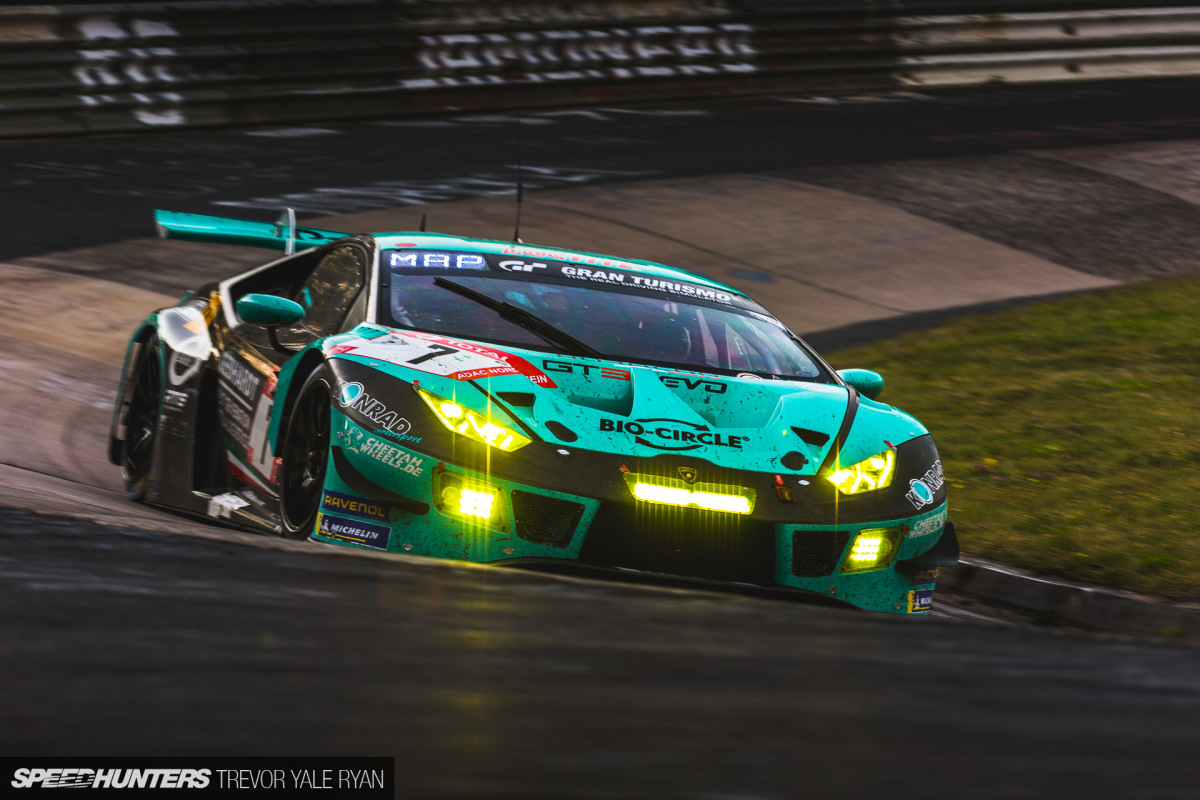
Just by raw experience I’ve been shooting for less than most around here, and as such I’m still very much learning what I’m actually doing. All this means is that there’s hope for anyone, so if you have some interest in shooting (and no idea what you’re doing), listen up.
Otherwise, skip straight to the comments and tell me why you hate me.
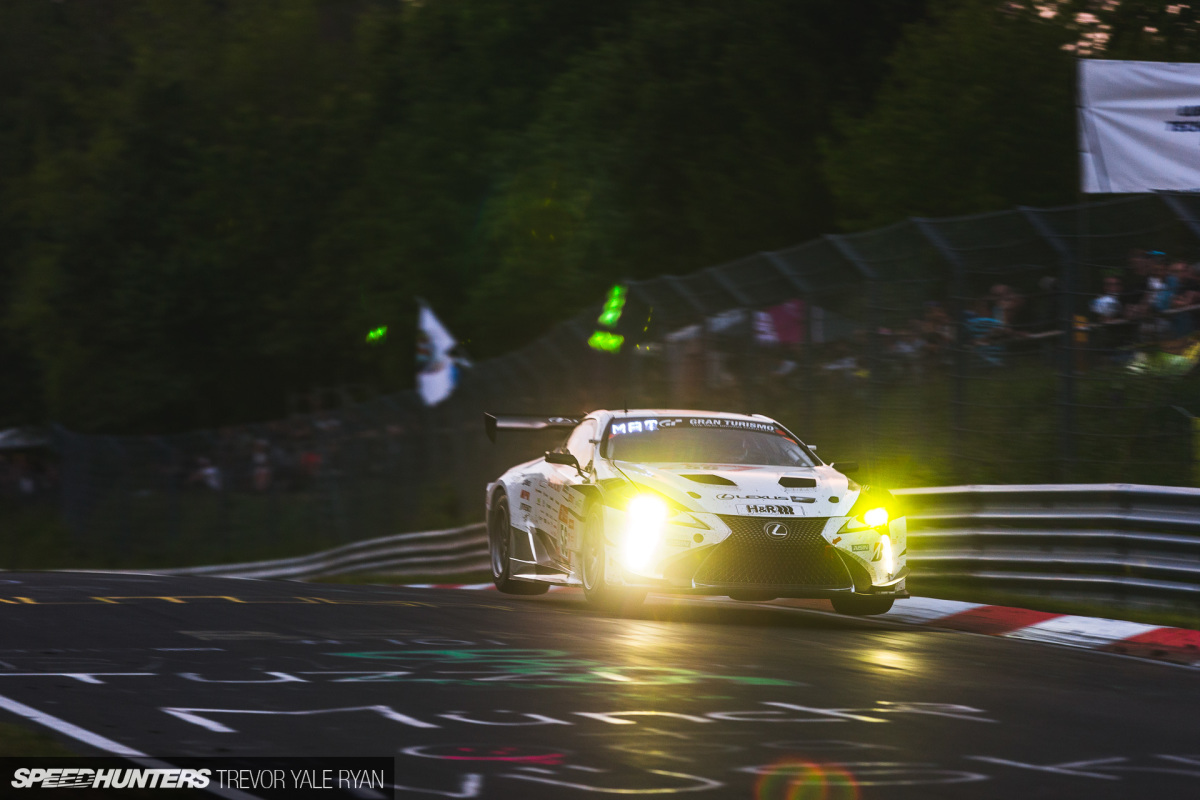
Just kidding, don’t do that — unless you really want to. Anyway, there’s one thing I’m sure of regardless of your level of experience: Every event spent behind the camera should be educational. If it isn’t, you’re doing something wrong.
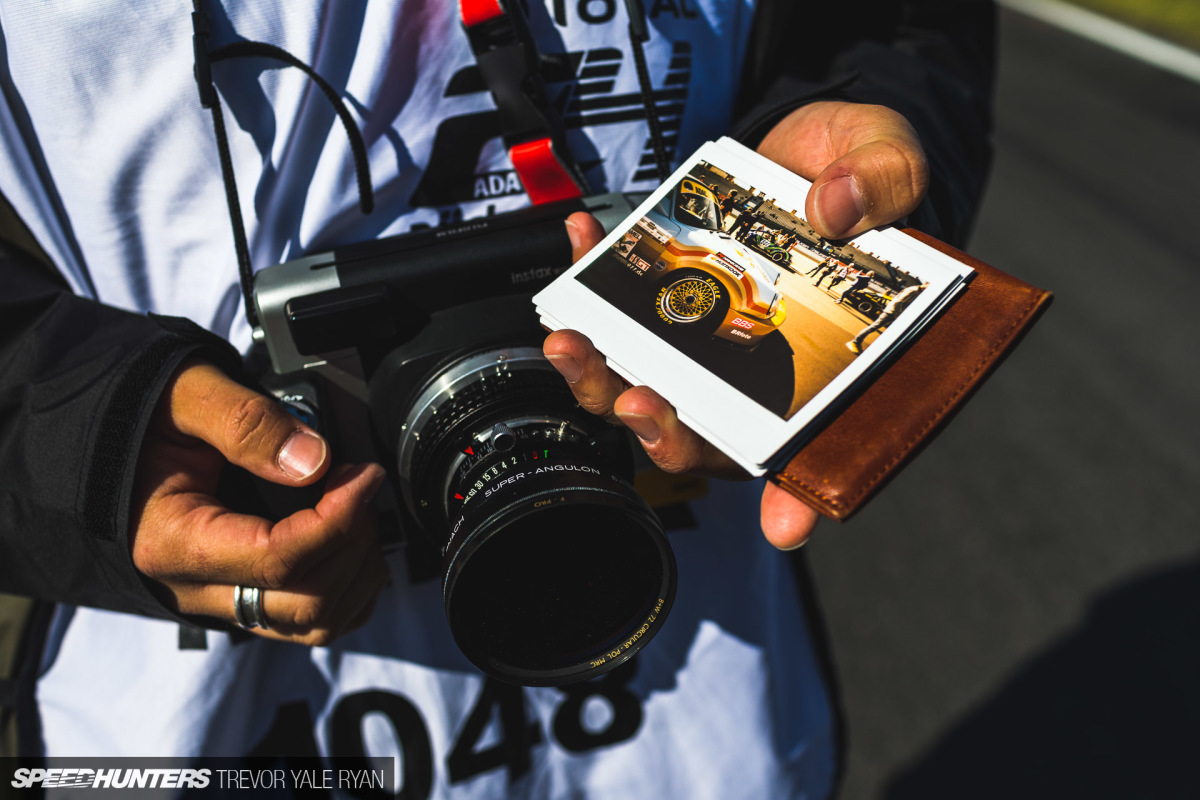
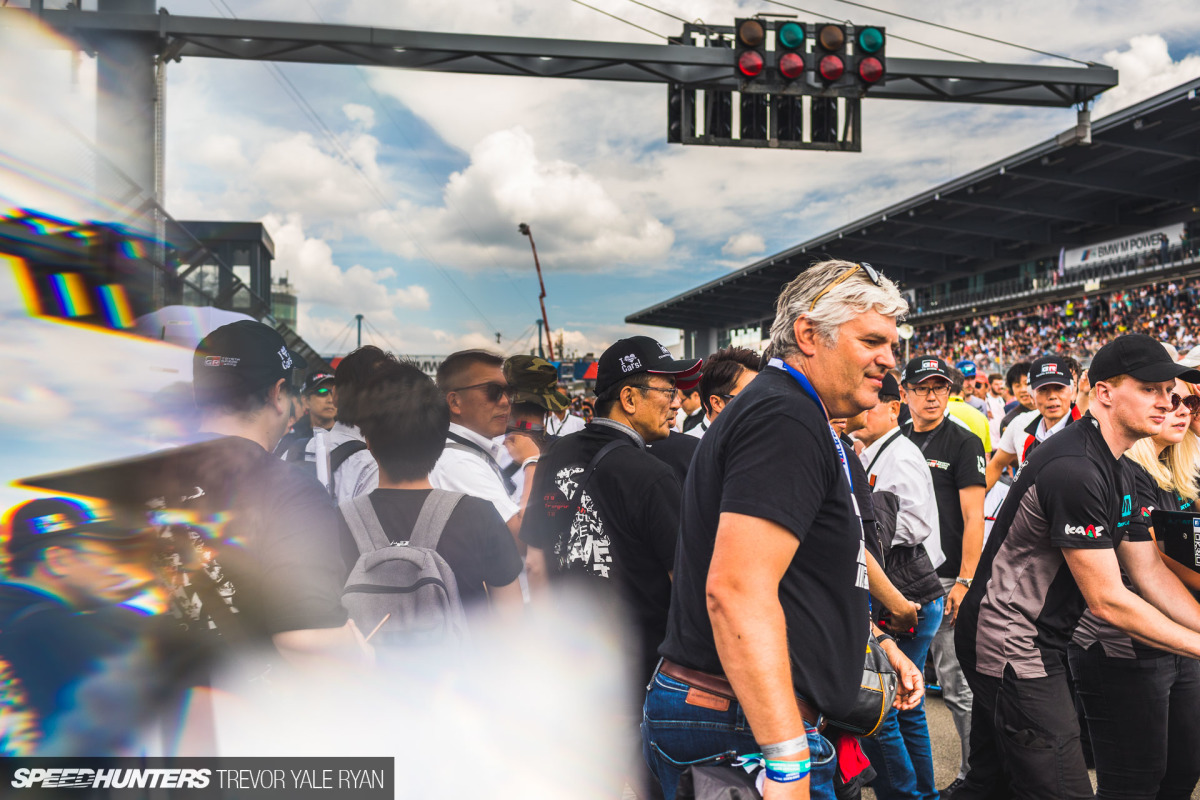
For example, this weekend I was lucky to run into my friends Nate Hassler and Lisa Linke, who took me around to a couple of their favorite corners on the track during the N24 Classic race. These two are always up to something new, and it just goes to show you need to constantly be pushing yourself.
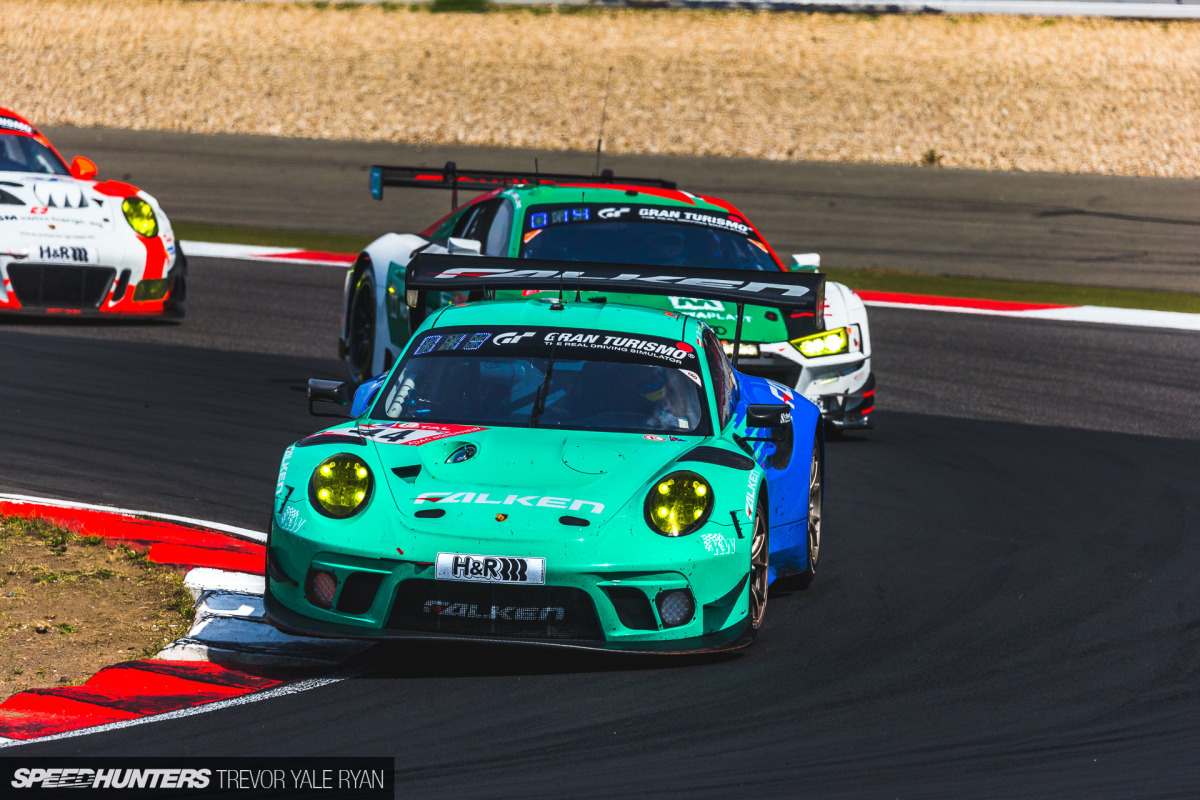
No race in the world can teach you as much as the Nürburgring 24 Hour and — whether you’re an automotive photographer, casual reader, race enthusiast, or my own mom — I hope you can come out the other side of this article having learned something as well.
Gearing Up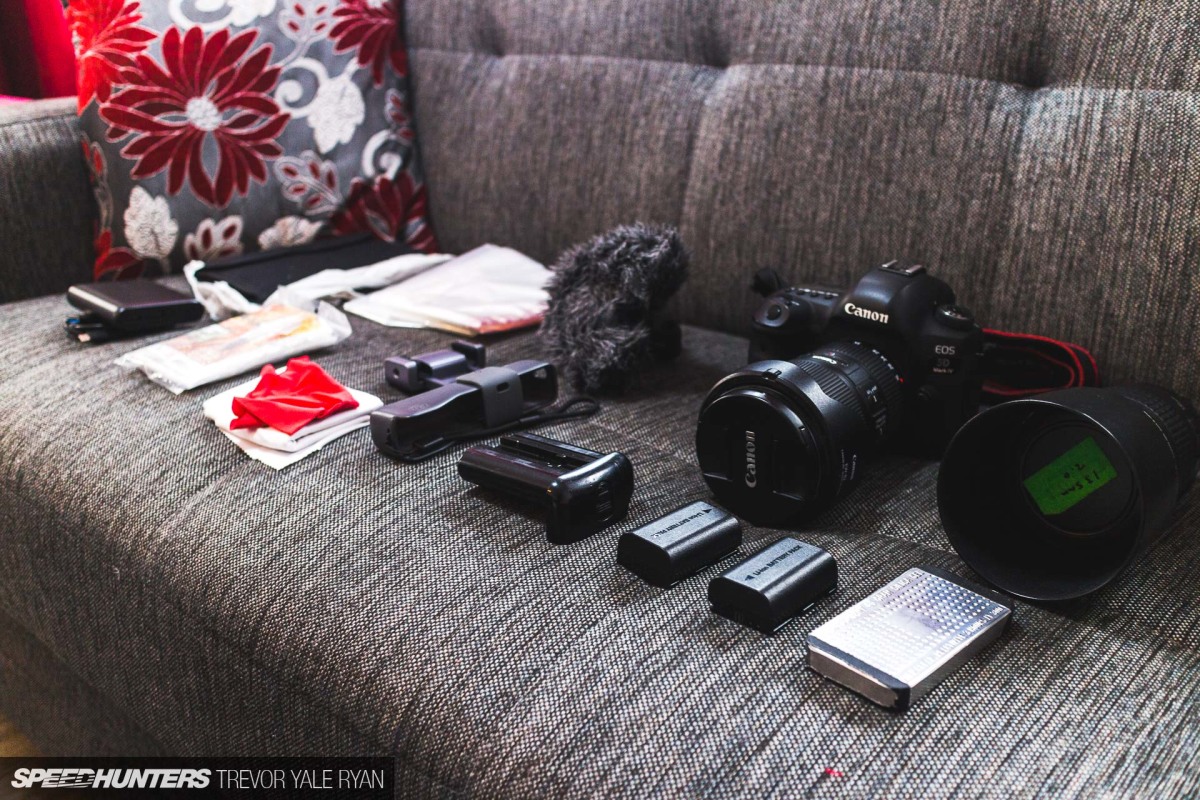
Far and away the most common question I am asked is: ‘What do you shoot with?’ The simple answer is a camera, and the best one is the one you have. It’s a tired yarn, but it’s 100% true — you shouldn’t upgrade your gear until you’re consistently out-performing it.
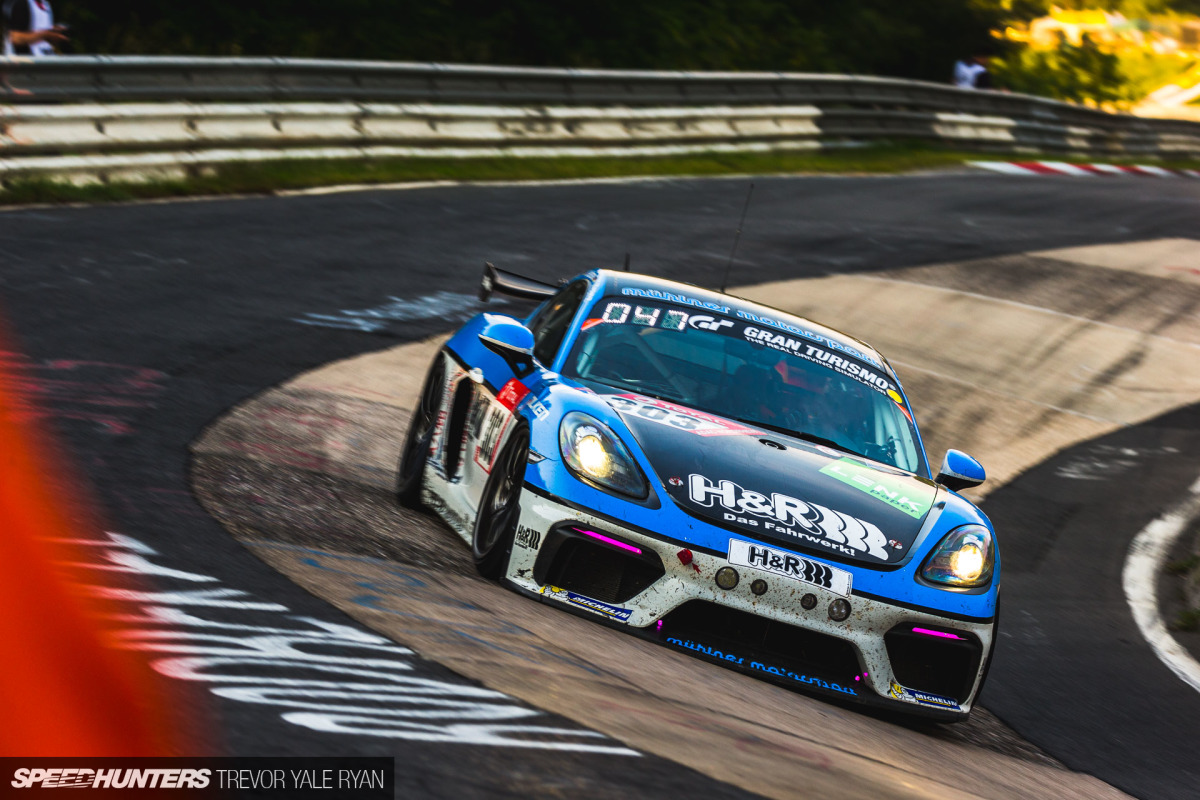
On that note, I’ll be the first to say that your equipment makes a massive difference in the quality and consistency of your shots. At the end of the day you’ll capture more photos that are up to snuff if you have the latest, most expensive gear, and that’s a fact.
This isn’t to say that you can’t get the shot on a few-generations-old consumer-grade body with a kit lens, but it’ll certainly take more time and dedication.
That’s okay, though, because you’ll learn a great deal in the process.
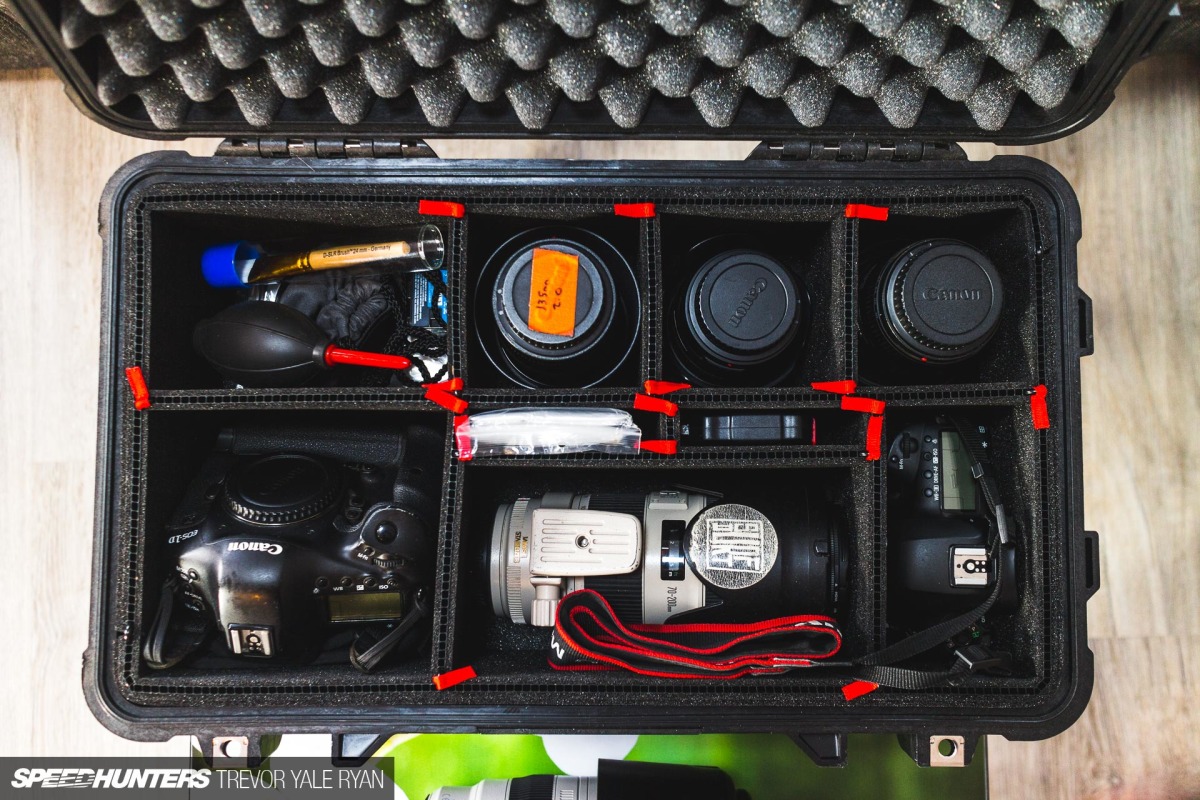
Over the years I’ve acquired a sort of mid-level prosumer setup with a dozen or so lenses and four bodies that Sara and I frequently use. For this specific trip I packed the following Canon bodies and lenses: My old EOS 1Dx for action, my 5D Mark IV as an all-rounder, a 16-35mm f/4L IS for wide-angle shots in the camps, an old 35mm f/1.4 for portraits and detail shots of the cars, a 135mm f/2.0 and 70-200mm f/2.8 II for everything, and the 100-400mm II for motaspotsu.
I would have really liked to bring my 500mm 4.5, but given how heavy and large it is – not to mention the very specific use case it offers – I begrudgingly left it at home at the advice of Paddy, Ben, Mark, and pretty much anyone I harassed about it.
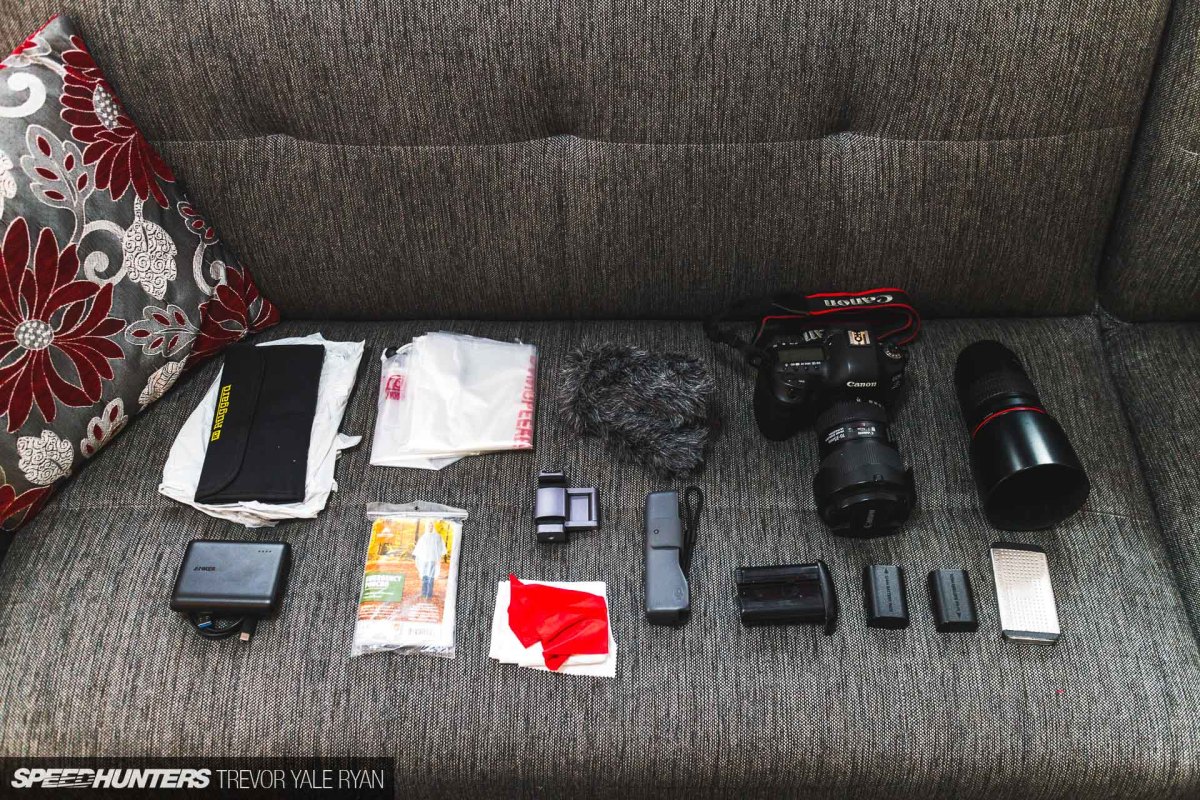
As for my walk-around kit, the first day all I brought with me in my messenger bag was my 5D Mark IV, 16-35mm, and 135mm. I say that, but there’s an awful lot of other crap here, mostly waterproofing gear which Jordan said I’d need, but didn’t. I reckon he’ll be refunding me on PayPal for all that shortly.
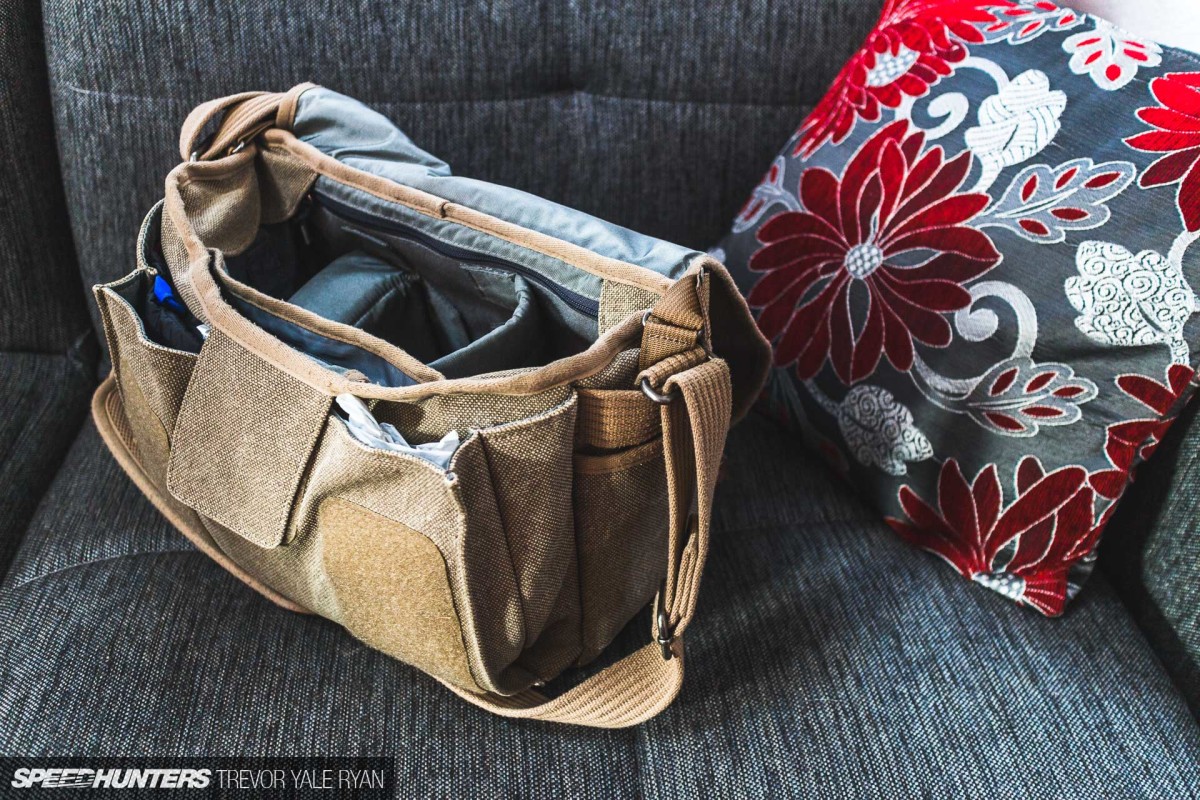
Of course, I had the usual extras as well, including a trash bag (the only rain protection I always have with me), batteries, and polarizing filters. I also packed a very tiny video camera to capture some personal clips from my time driving through the countryside and hanging out in the various campsites surrounding the circuit.
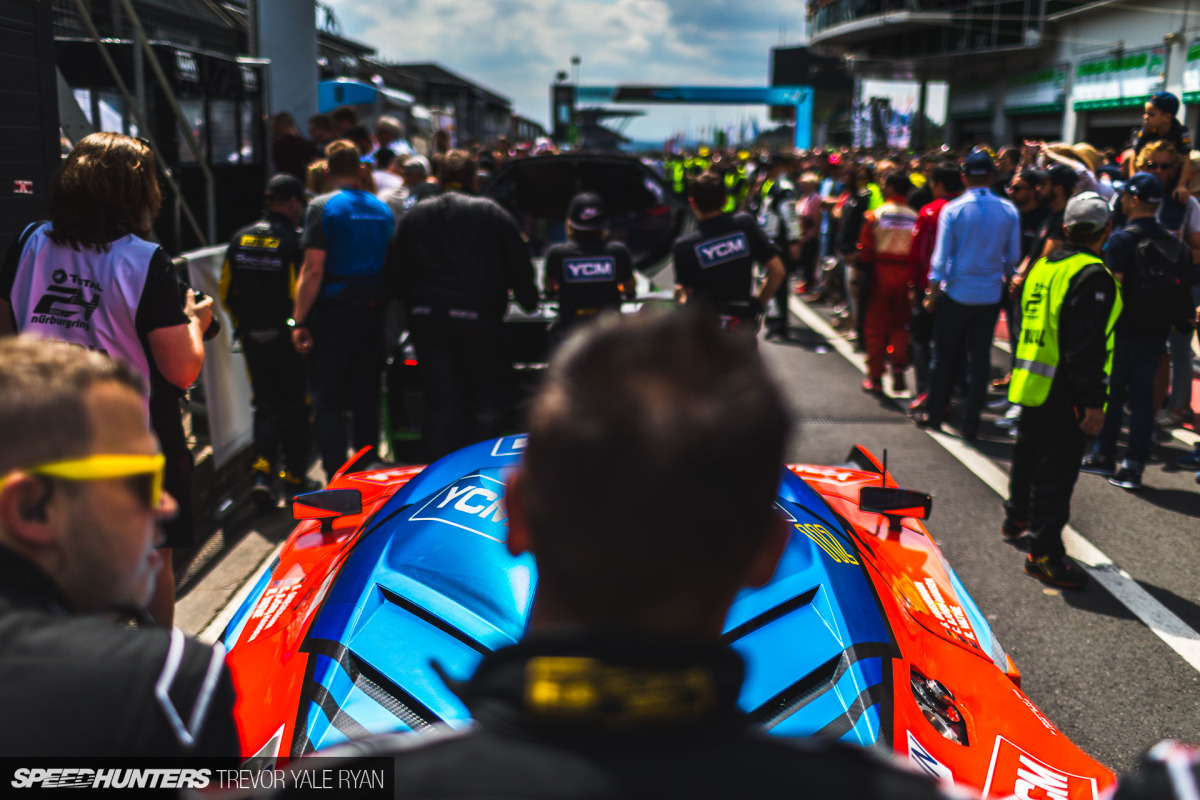
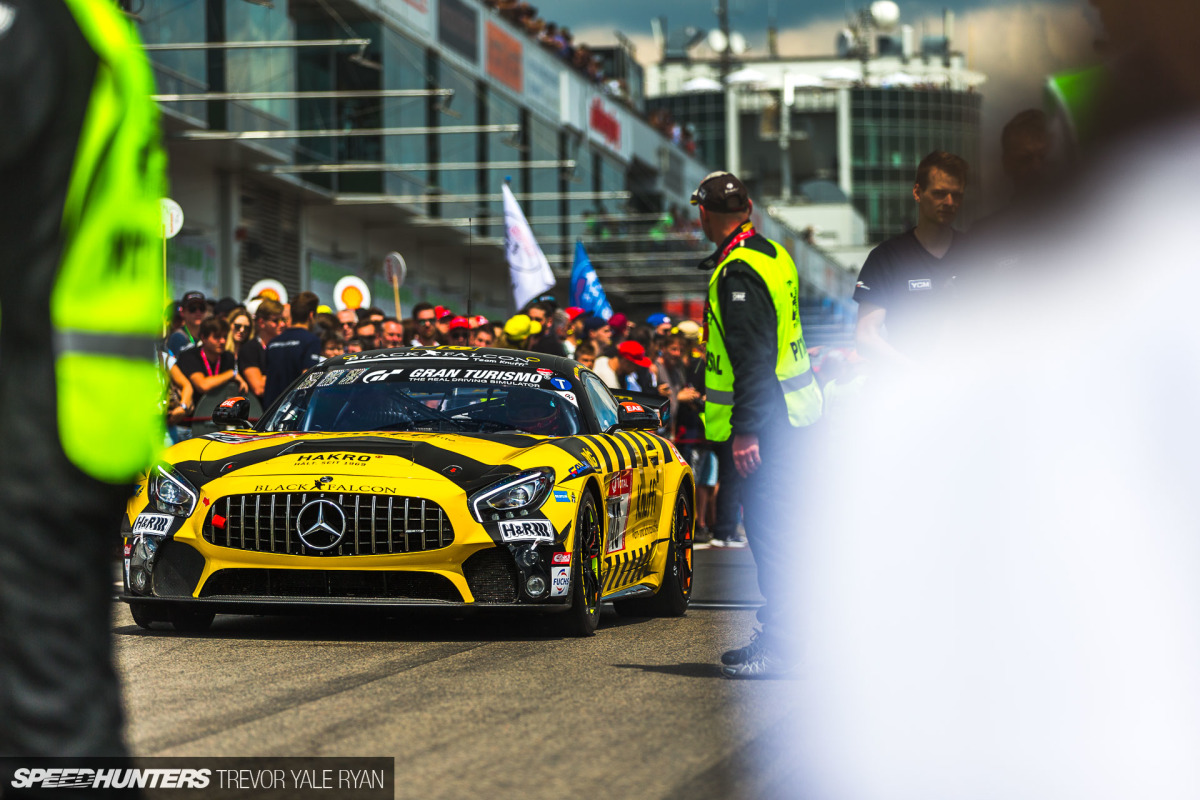
That’s the gear, but take it with a grain of salt. It really doesn’t matter that much what you’re shooting with; if you’re having a good time you’re going to produce good images sooner or later. Although, as much as I might wax lyrical about the journey, there’s no doubt I wouldn’t jump at moving to 1Dx Mark IIs across the board — don’t get me wrong.
Just keep in mind, the gains by moving to exponentially more expensive gear tend to become more and more microscopic.
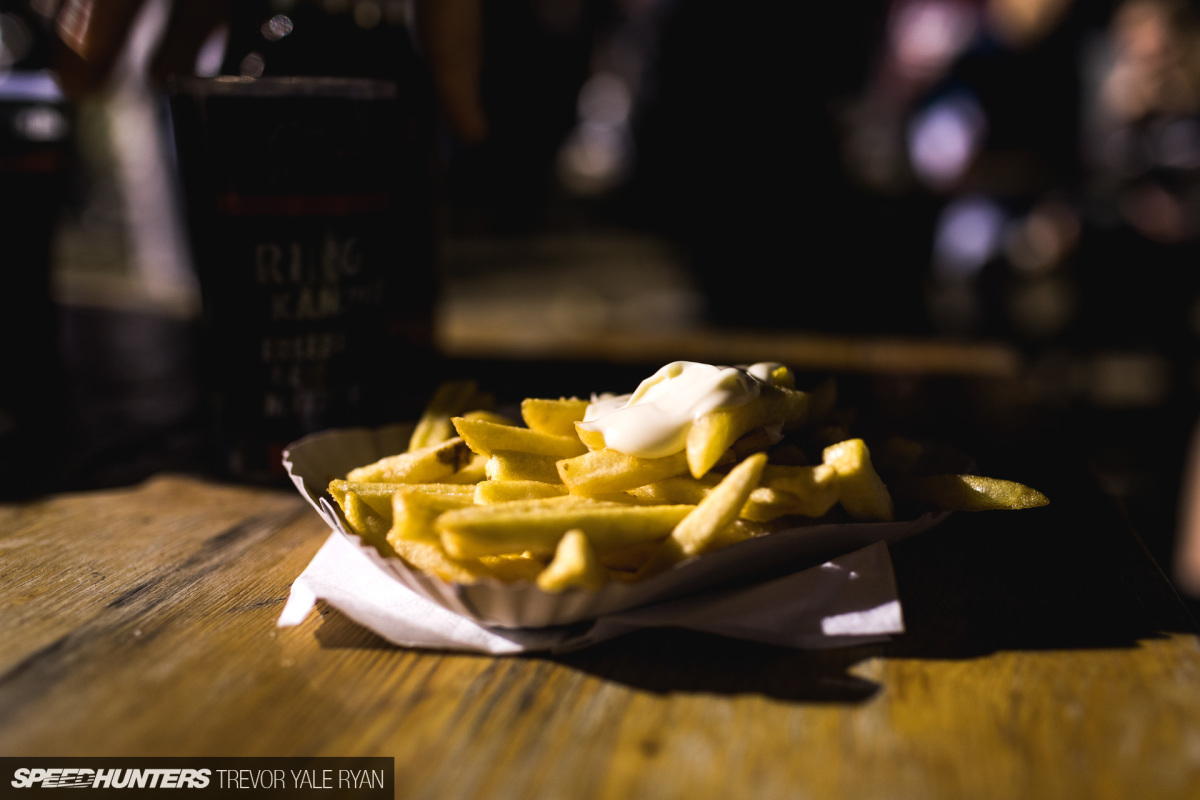
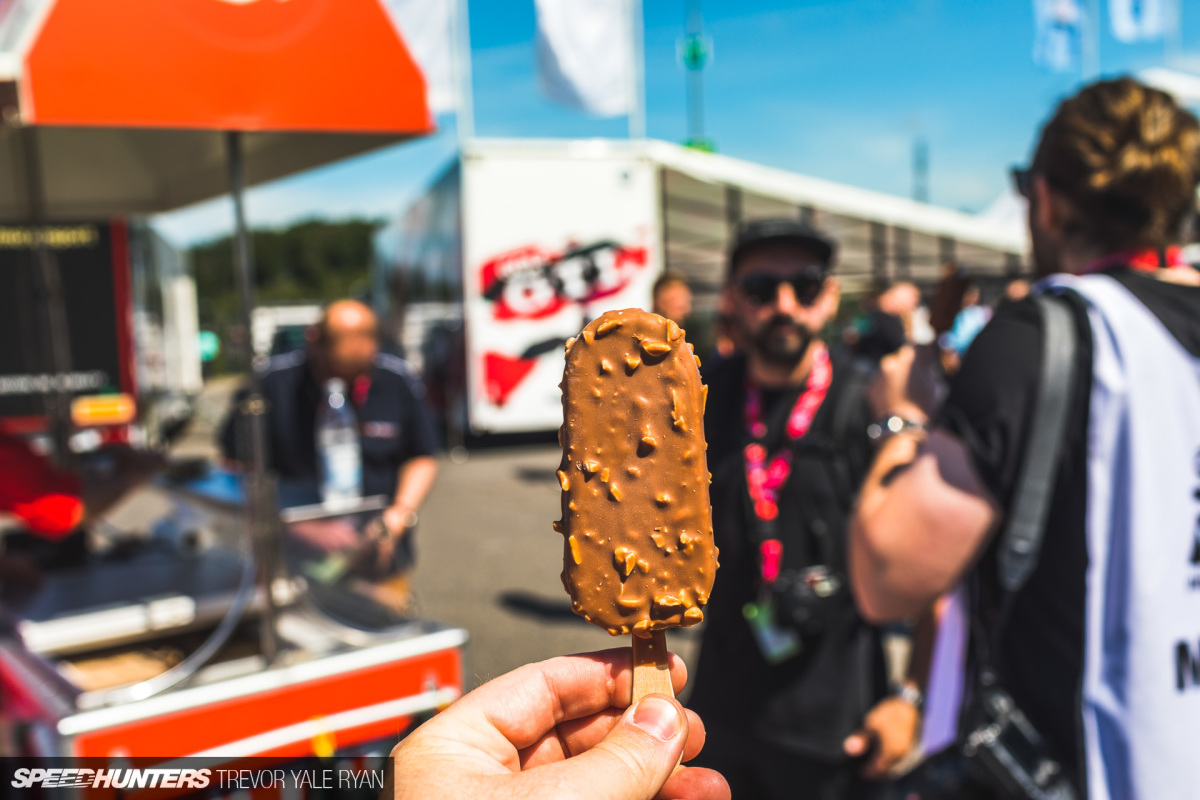
One other note in terms of preparation, and one I often overlooked when I got started: Keep yourself hydrated and well fed. If you’re uncomfortable (especially for a 24-hour race) you just won’t be able to focus completely on shooting, which is key. In other words, if I was with Ben I was eating ice cream and french fries, and when left to my own devices I was eating funny sandwiches I made from my hotel’s breakfast buffet and smuggled out in my camera bag.
Better safe than sorry when it comes to hunger — just stay away from the mayo.
Secret Sauce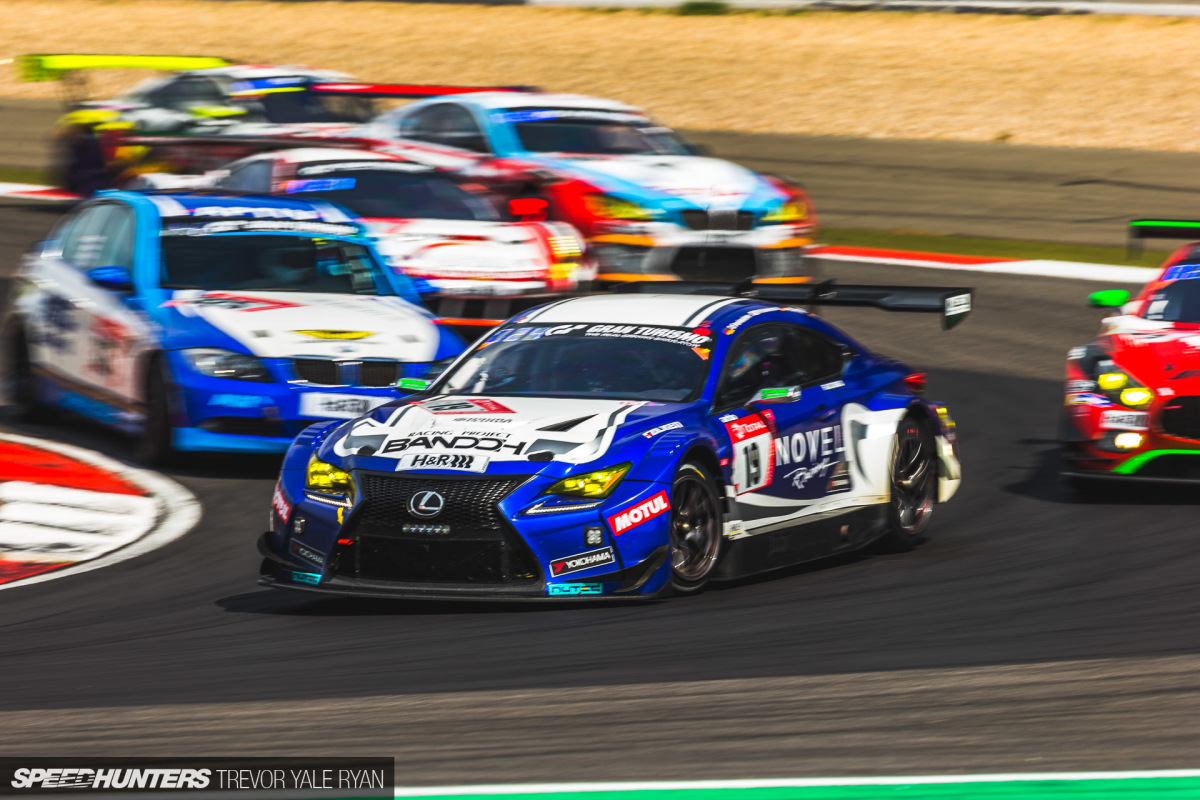
The next most common question I’ve come across is a request for specific camera settings and the lens used for a given photo. This information is entirely subjective (i.e. mostly useless) given a thousand details like the distance to your subject, the time of day, the angle and source of the light, the temperature, how fast your target is moving, and on and on and on.
Still, to show there really is no secret sauce when it comes to shooting, here are a few photos and their corresponding settings in all their glory.
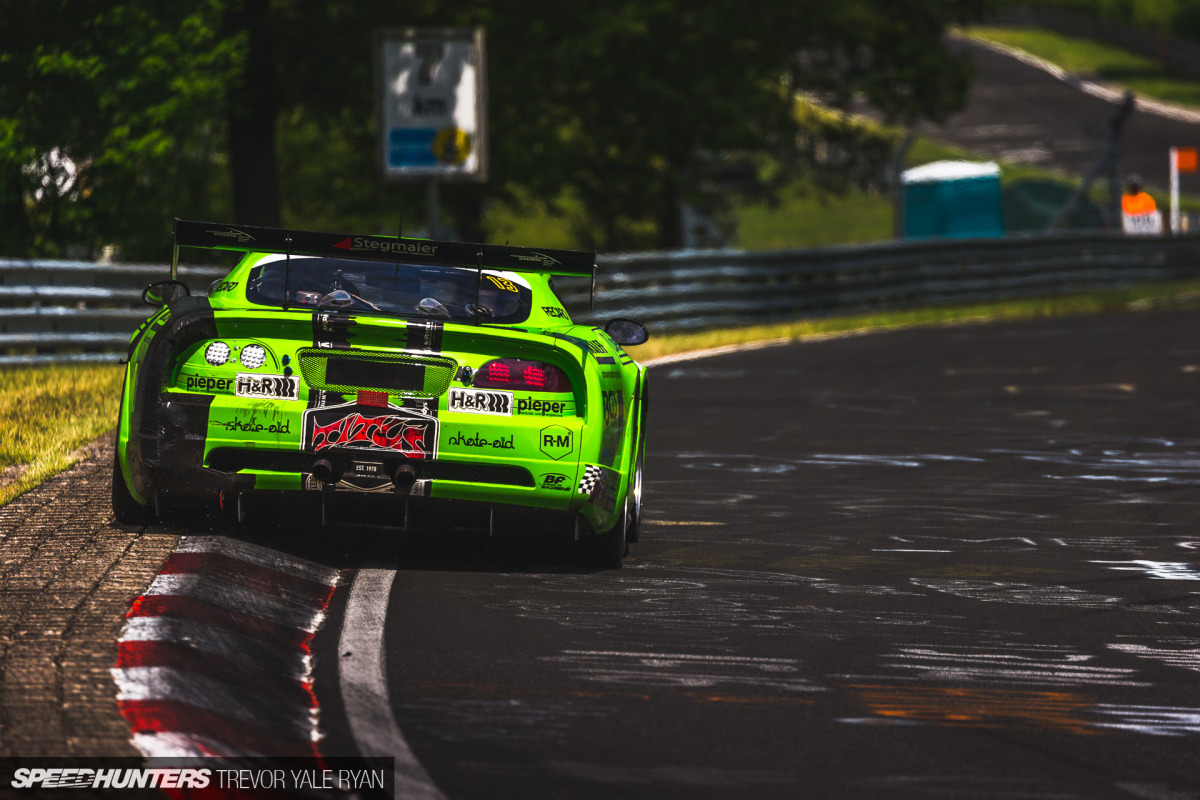
Canon 1Dx, 100-400mm, f/5.6, 1/640s, ISO 100
This is a straightforward shot during the day, although I’ll mention I bumped my AF microadjustment to compensate for the cars driving away from me at high speed through the kink in Adenau Forest.
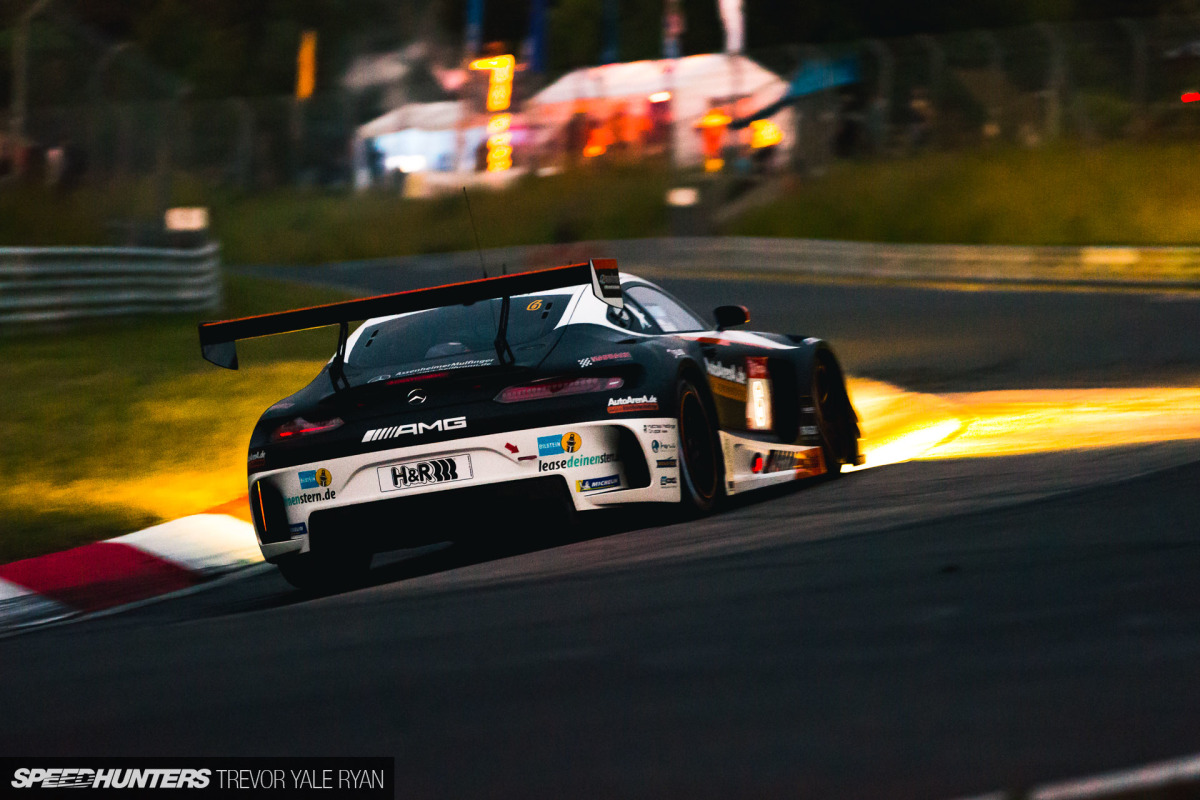
Canon 1Dx, 70-200mm, f/2.8, 1/160s, ISO 20000
Here, as night fell, I was still shooting in Aperture Priority. To get a reasonable exposure my camera cranked the ISO way, way up. Most of these shots were completely unusable due to the noise.
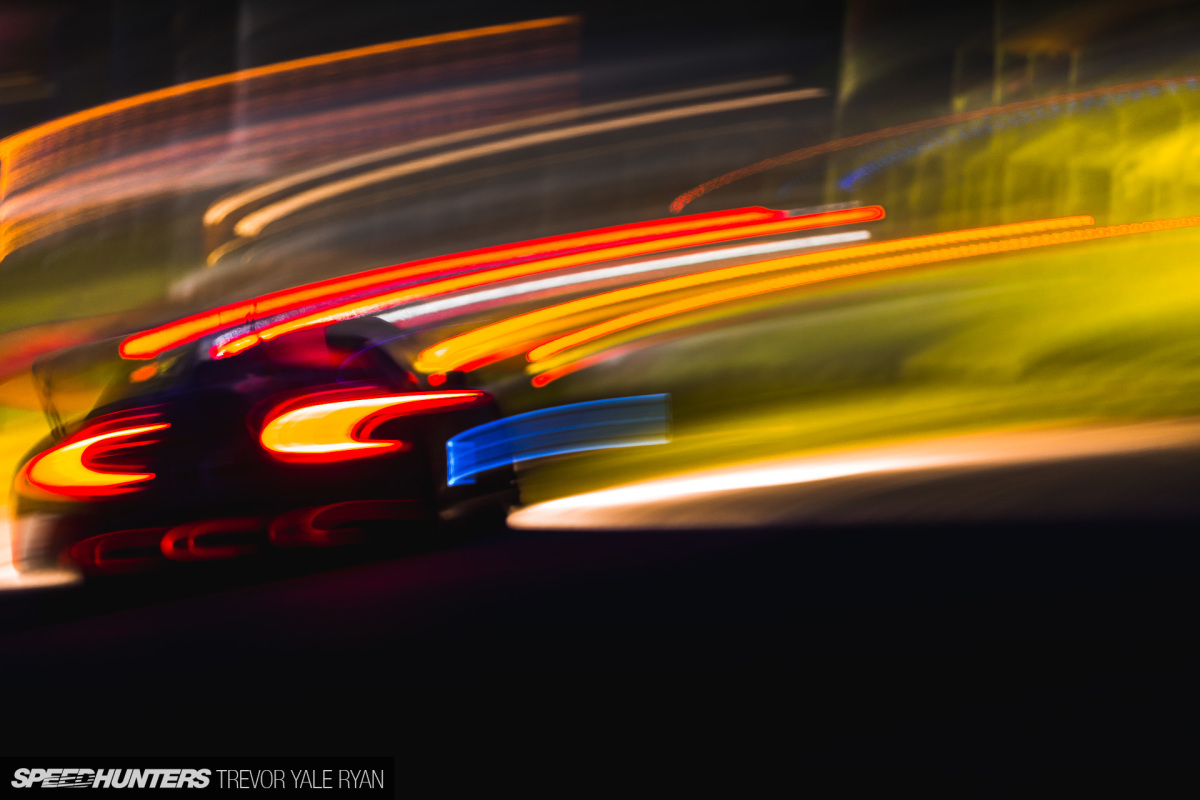
Canon 1Dx, 70-200mm, f/2.8, 1/4s, ISO 1000
This is the same corner and a very similar angle as the above shot, with settings and results worlds apart.
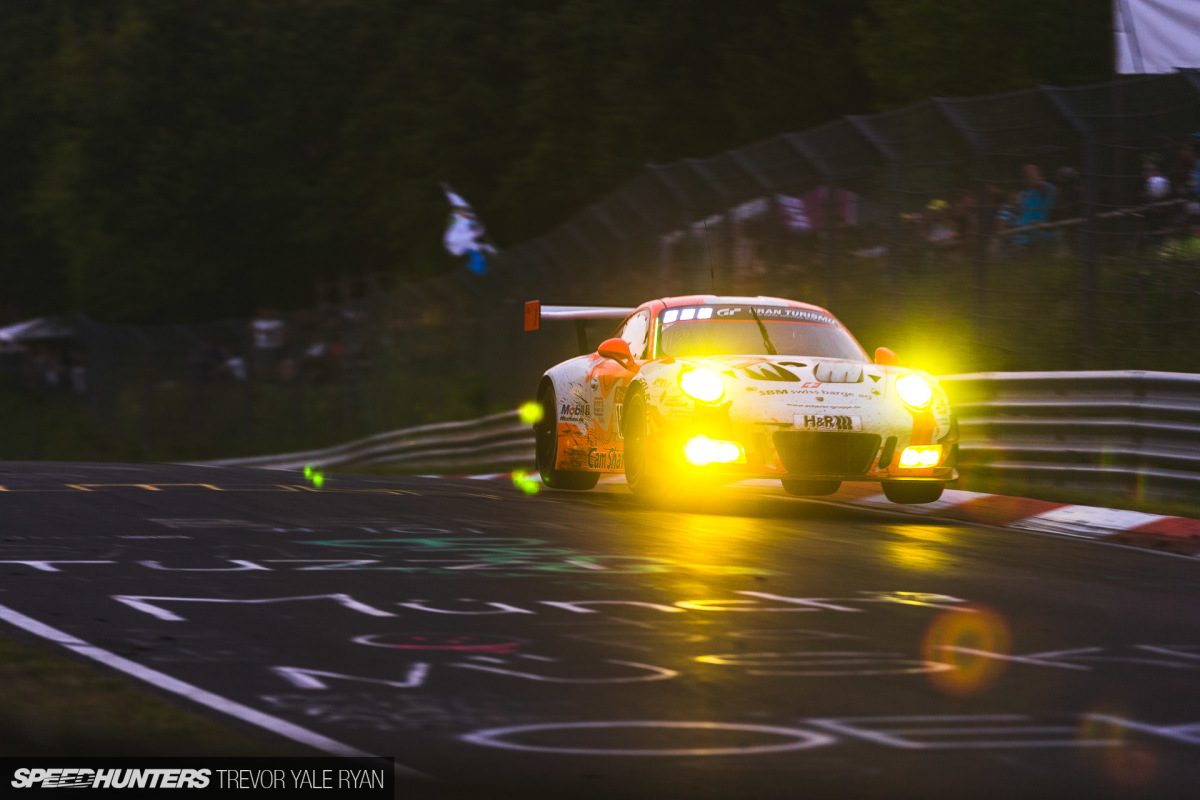
Canon 1Dx, 70-200mm, f/2.8, 1/200, ISO 320
The golden hour and immediately after is always the best time to be shooting. The reflections on the track are a nice bonus, and while the drivers and most photographers might have prefered the dry race I would have loved to see some rain.
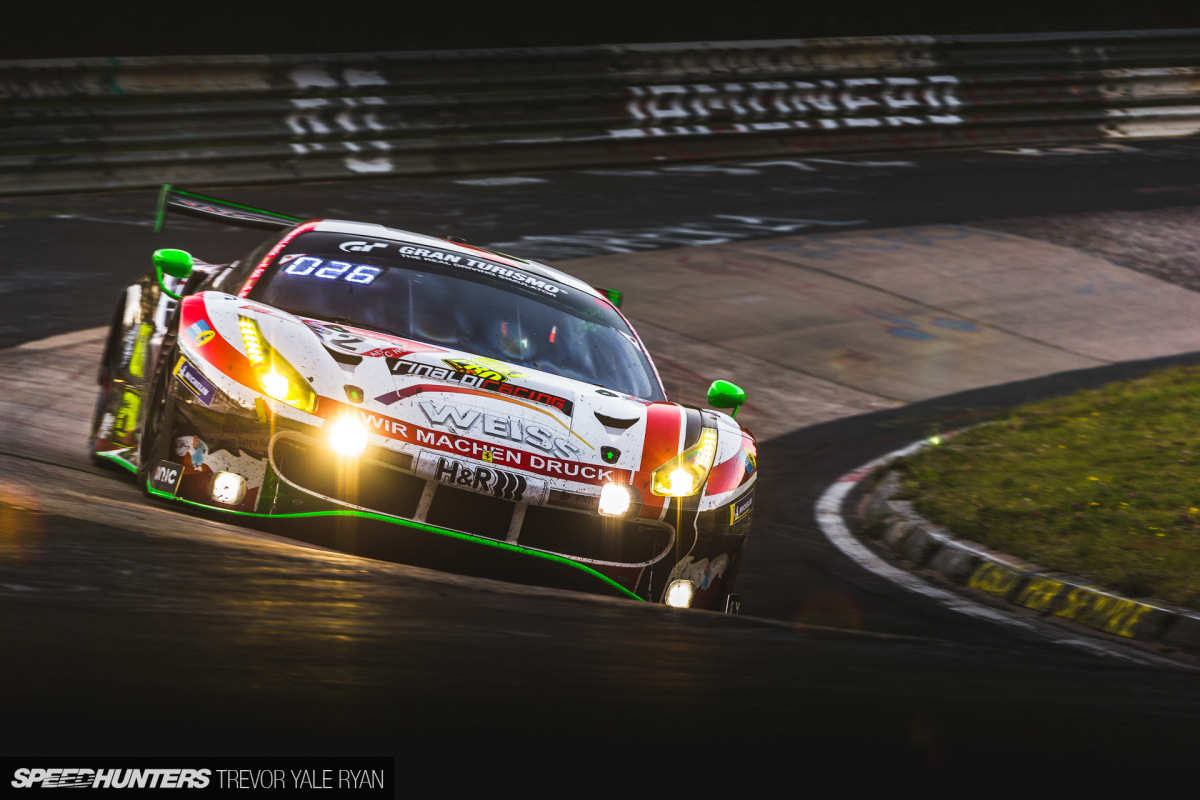
Canon 1Dx, 70-200mm, f/3.2, 1/200s, ISO 200
Another shot at dusk, this time at the Karussell.
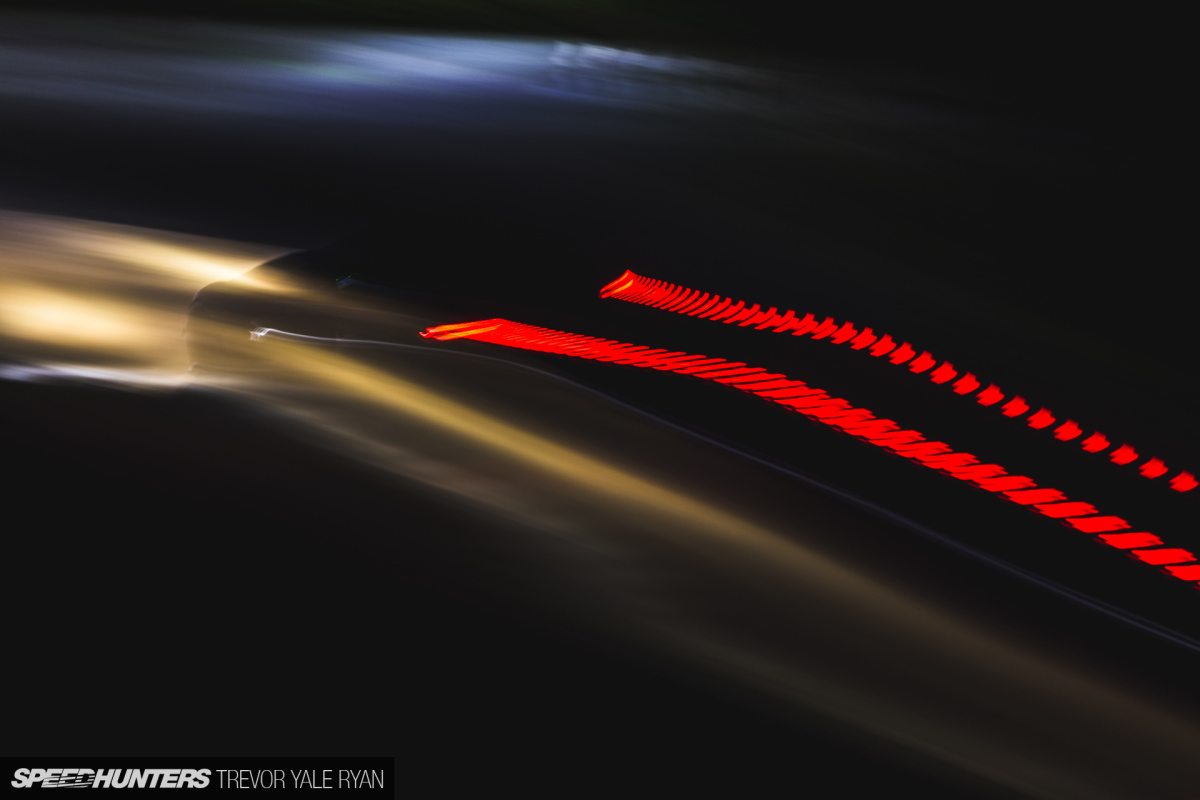
Canon 1Dx, 70-200mm, f/3.5, 1.0s, ISO 100
Same corner as above with my eye on the exit just two hours later.
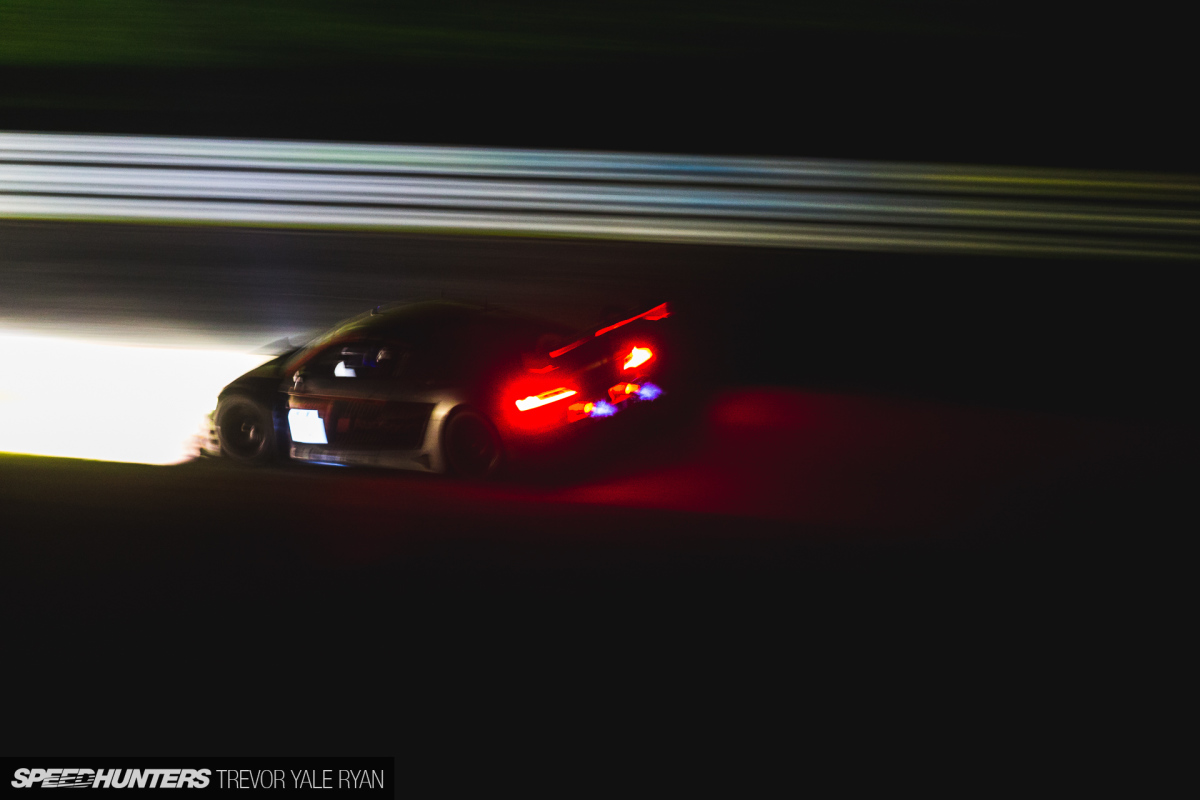
As you can see your settings are really entirely dependent on the case, but hopefully that gives you an idea of the range you might find yourself in for different situations. When in doubt, your camera usually has some idea, so unless conditions are pretty constant or I want a very specific shot I’ll use Aperture or Shutter Priority and just compensate by cranking my preferred exposure up or (usually) down.
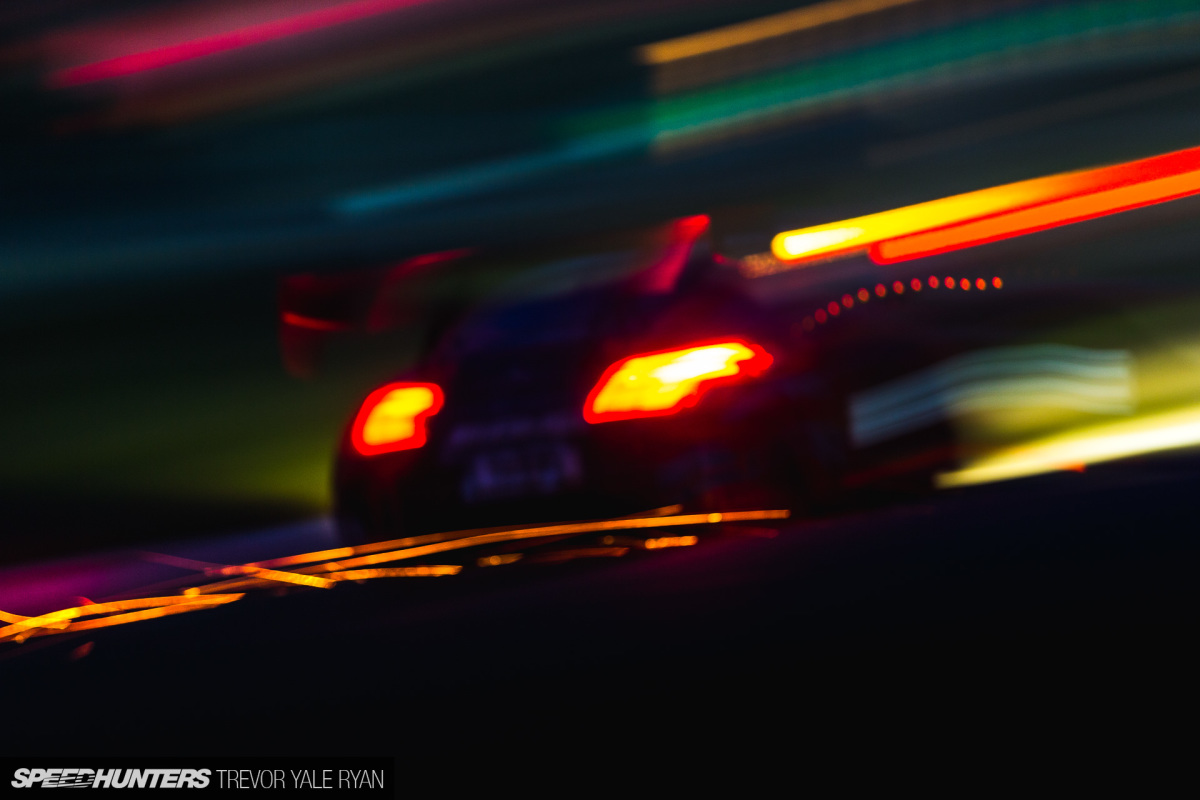
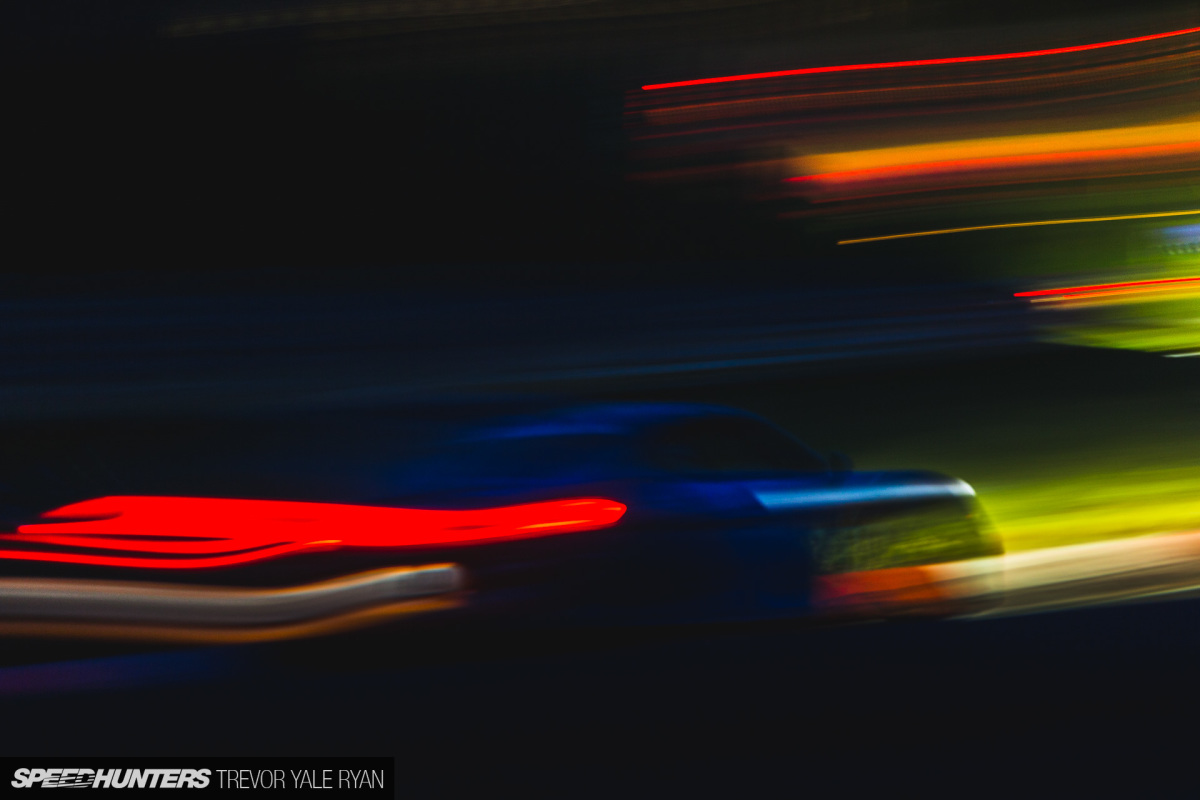
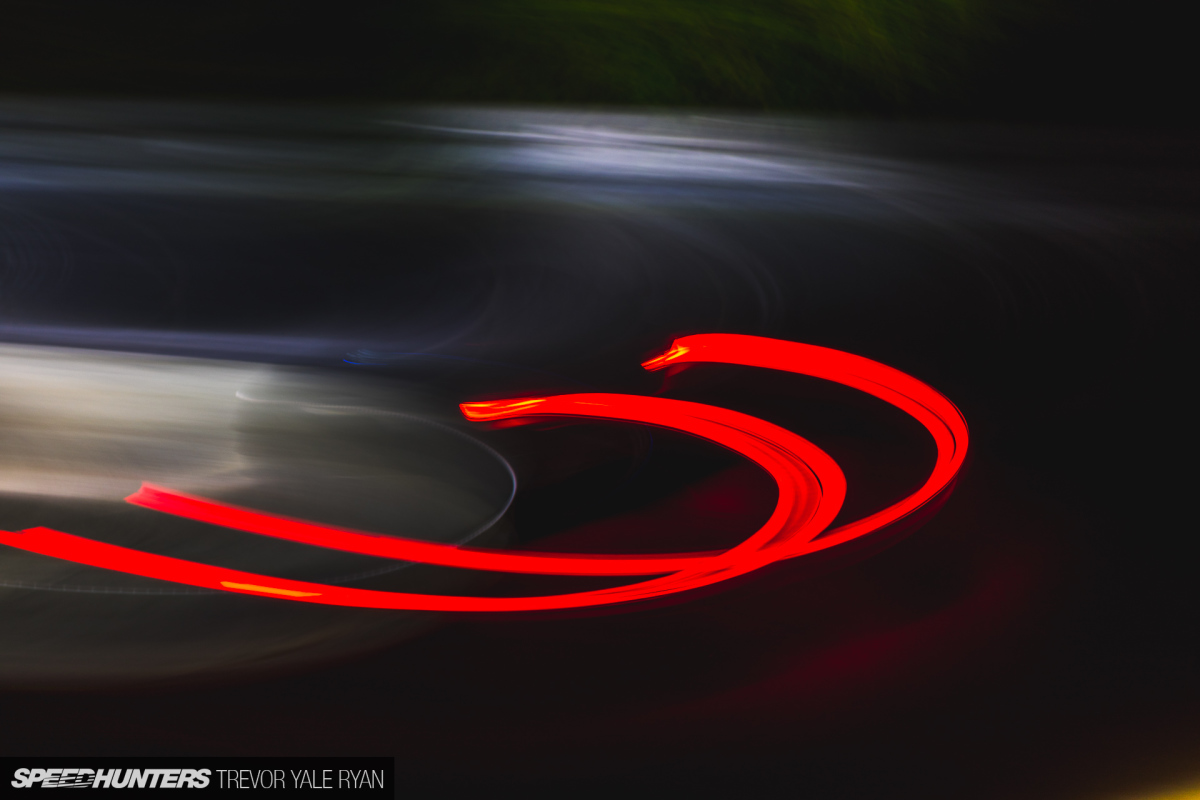
Once the dark of night really hits you often have no option but to push your shutter speed. Your camera will also struggle to focus, so you’ll probably take about 2,000 photos and come away with three which are barely semi-useable depending on your audience.
Oh well.
Extra Sauce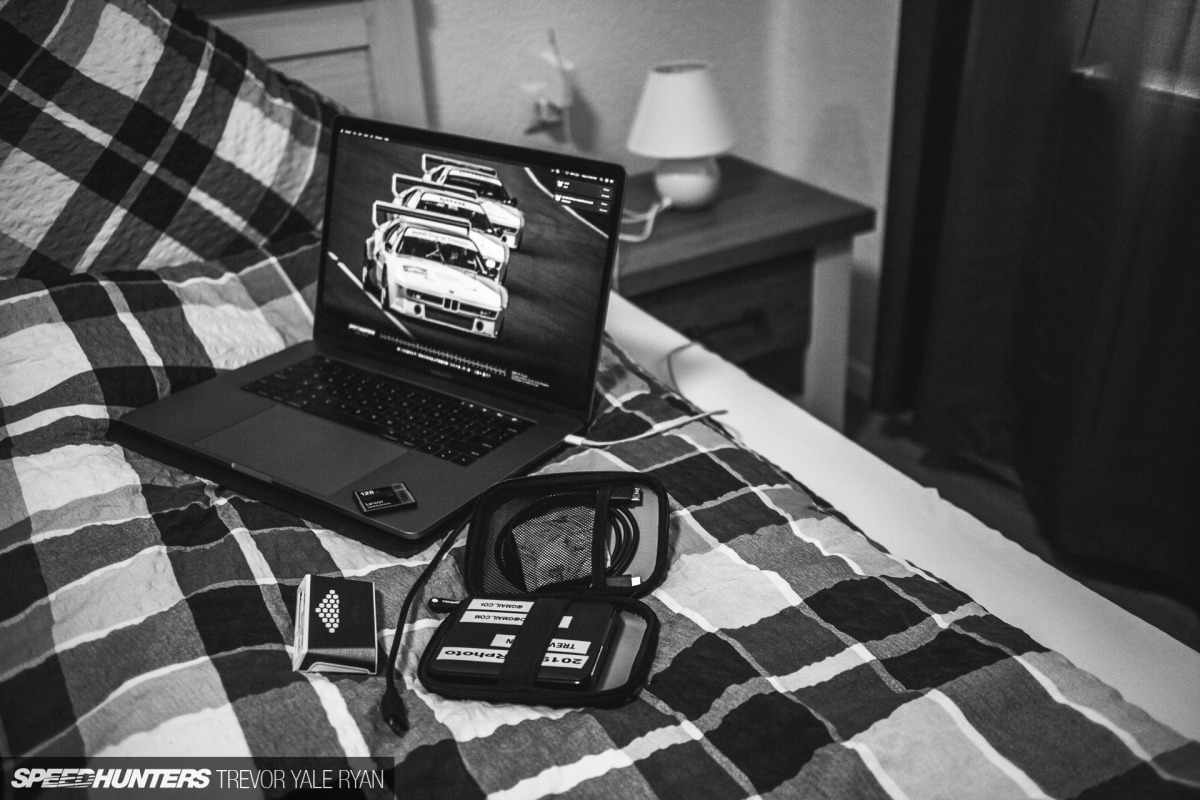
Then, the big question: ‘How did you edit this?’ Or: ‘My photos look bland out of the camera, what’s wrong?’
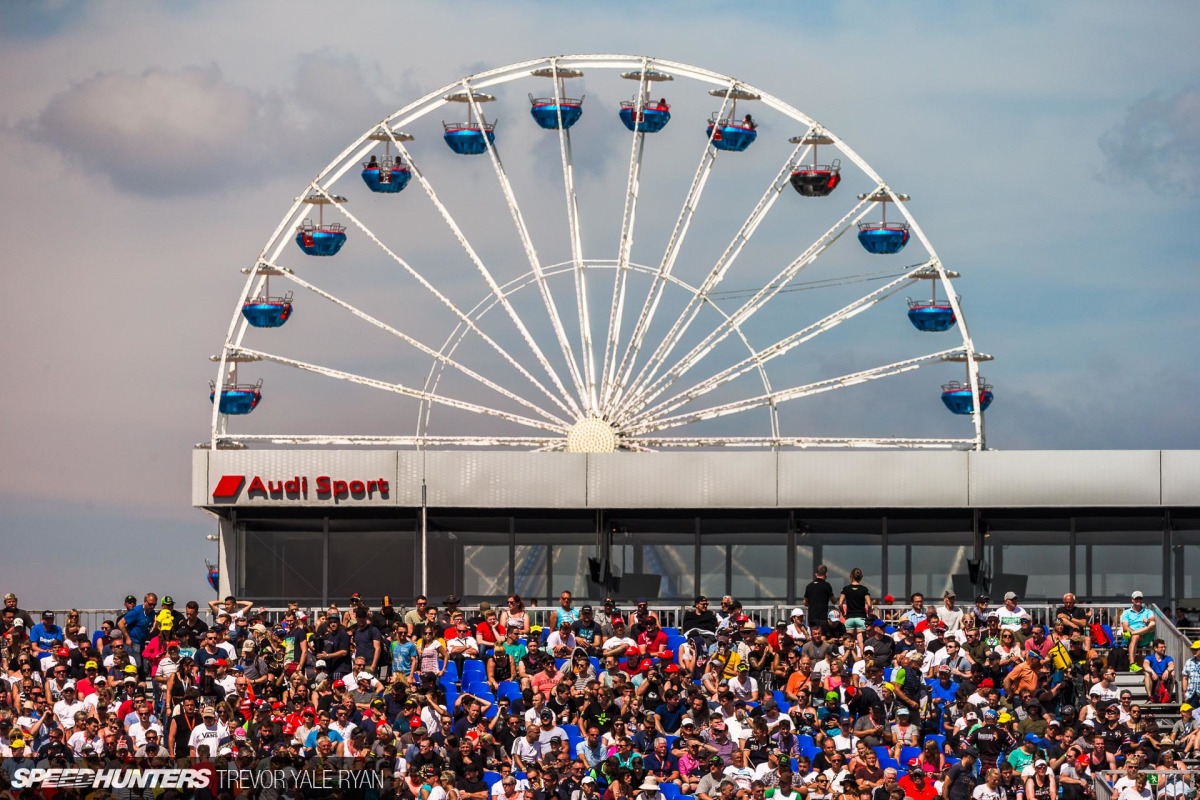
The short answer is that nothing is wrong at all, and that’s how most everyone’s shots look before post-processing. If you’re shooting JPEG you can usually alter this in camera with some basic saturation and sharpness options which will look halfway decent, but shooting RAW is the way.
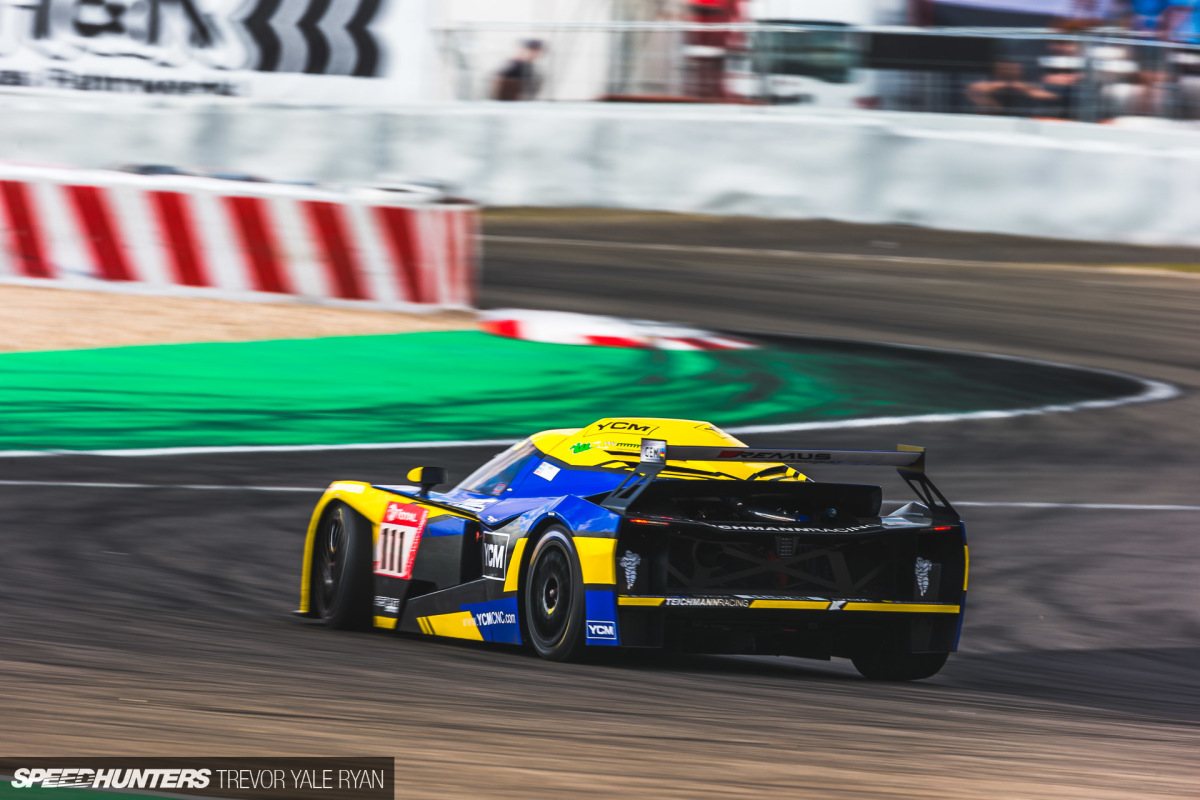
And therein lies the very unglamorous part of the whole ordeal of taking photos. Moving your shots over, backing them up, sorting through and tagging them has to be the worst part of it all. It’s tedious, time consuming, and entirely necessary.
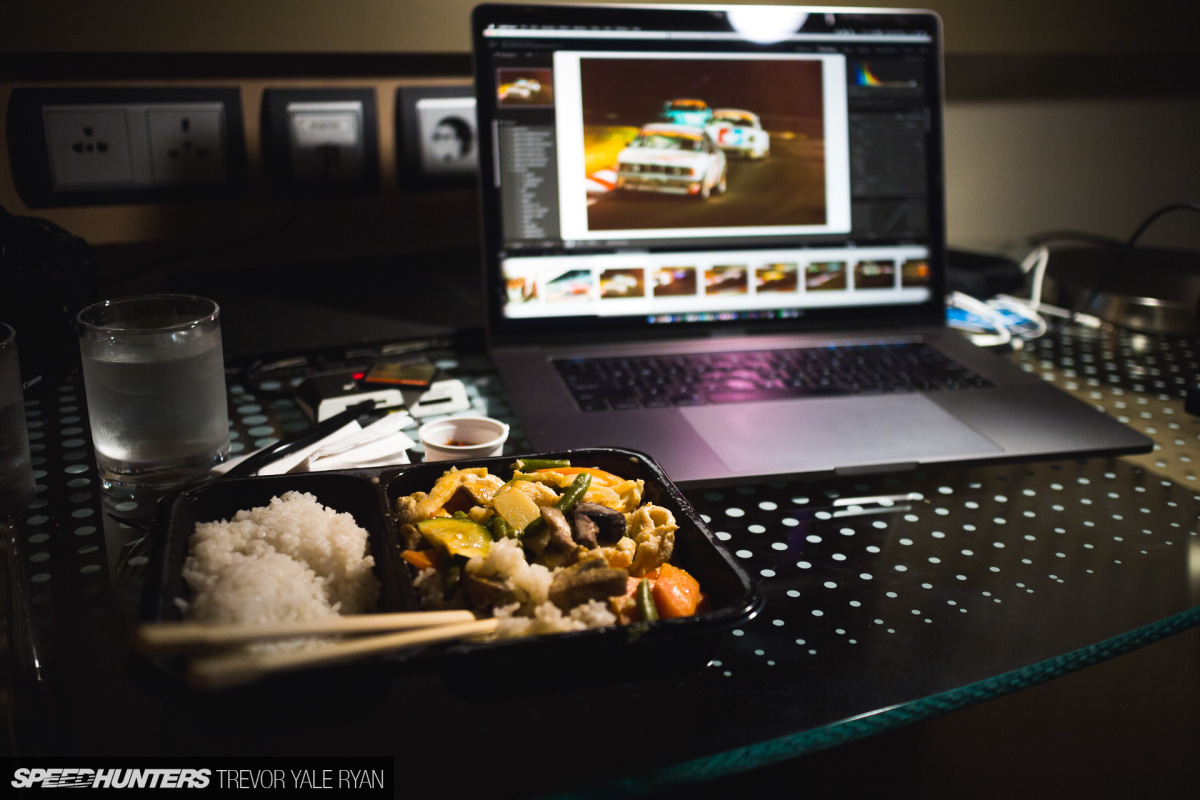
And then, after that, you have to edit them. To me, this has always been equally important as getting the shot in the first place. Once you get things right in the camera this becomes a lot easier and more straightforward, but RAW shots are designed to capture as much information as possible and require editing.
To give you a better idea as well as to assure you there’s nothing wrong with your camera — and perhaps against by better judgment — here are a few before and afters.
It totally depends on the shot, but lately as a general rule I bump up the saturation a bit (five to 10 clicks in Adobe Lightroom) as well as apply a fairly standard S-shaped tone curve. The extra contrast from the tone curve tends to add a great deal of color, too, so I’ll often tone down certain hues or the entire photo after applying some more specific adjustments.
It just takes time and practice, and I won’t act like I really know what I’m on about when it comes to post-processing; my self-made base presets change almost entirely every few months.
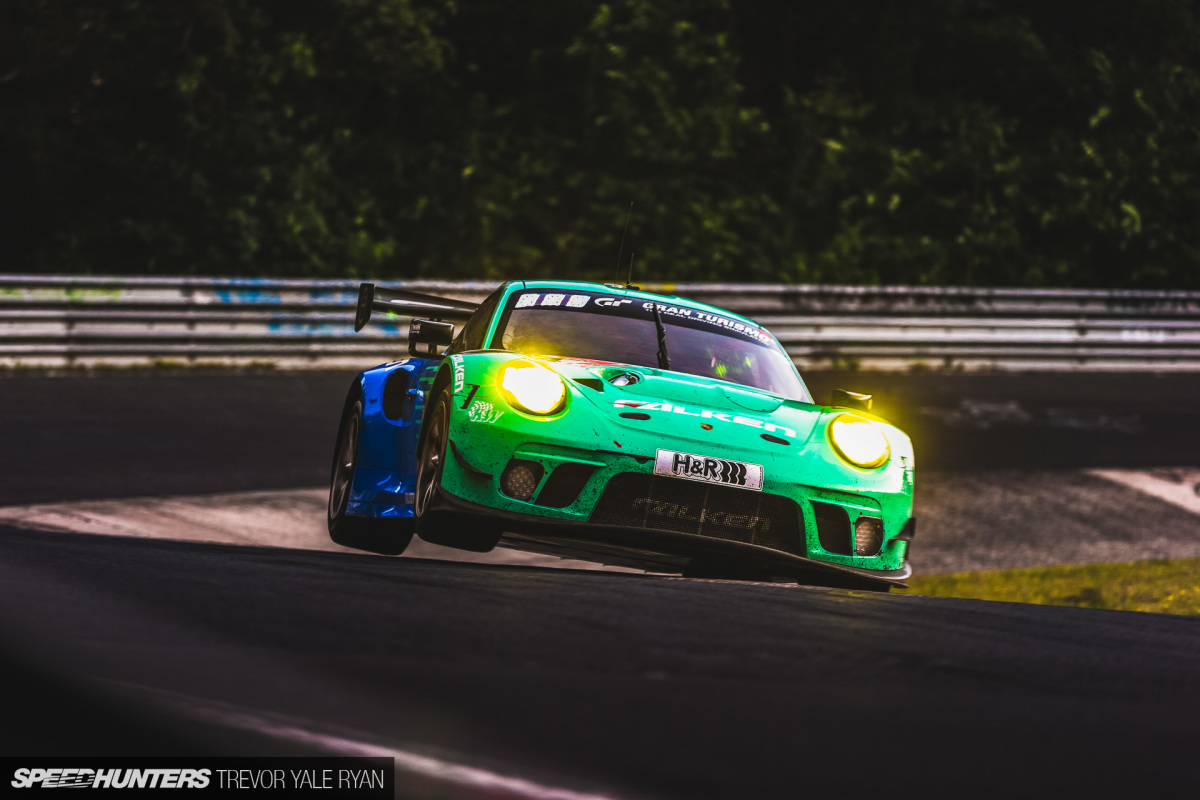
There are a few tricks I’ve learned though, and one is more of a rule: Your best shot will always come out blurry. Take this particular photo of this Porsche at maximum lift-off. I’ve actually stolen the face of the car from a shot I took fraction of a second earlier and photoshopped it onto this one (which was blurry) with the wheels off the ground.
It’s a bit of a pain to get right, and if you look really closely you’ll probably notice I did it, but without telling I’d get away with it 99% of the time.
But it’s always that 1% you need to look out for, isn’t it?
Location, Location, Location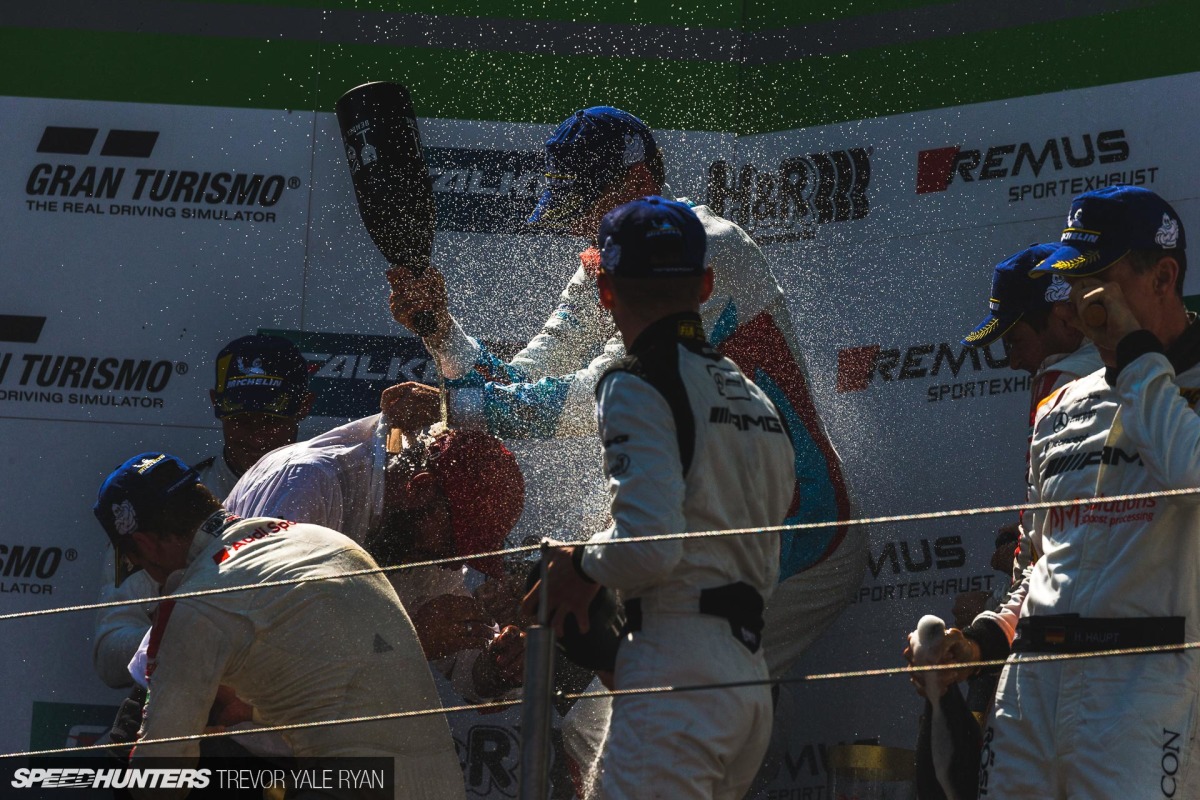
When it comes to getting the shot right in the first place perhaps the single most important aspect is your positioning. Location can make or break a feature shoot, and being able to anticipate the action at an event will enable you to take the best photos.
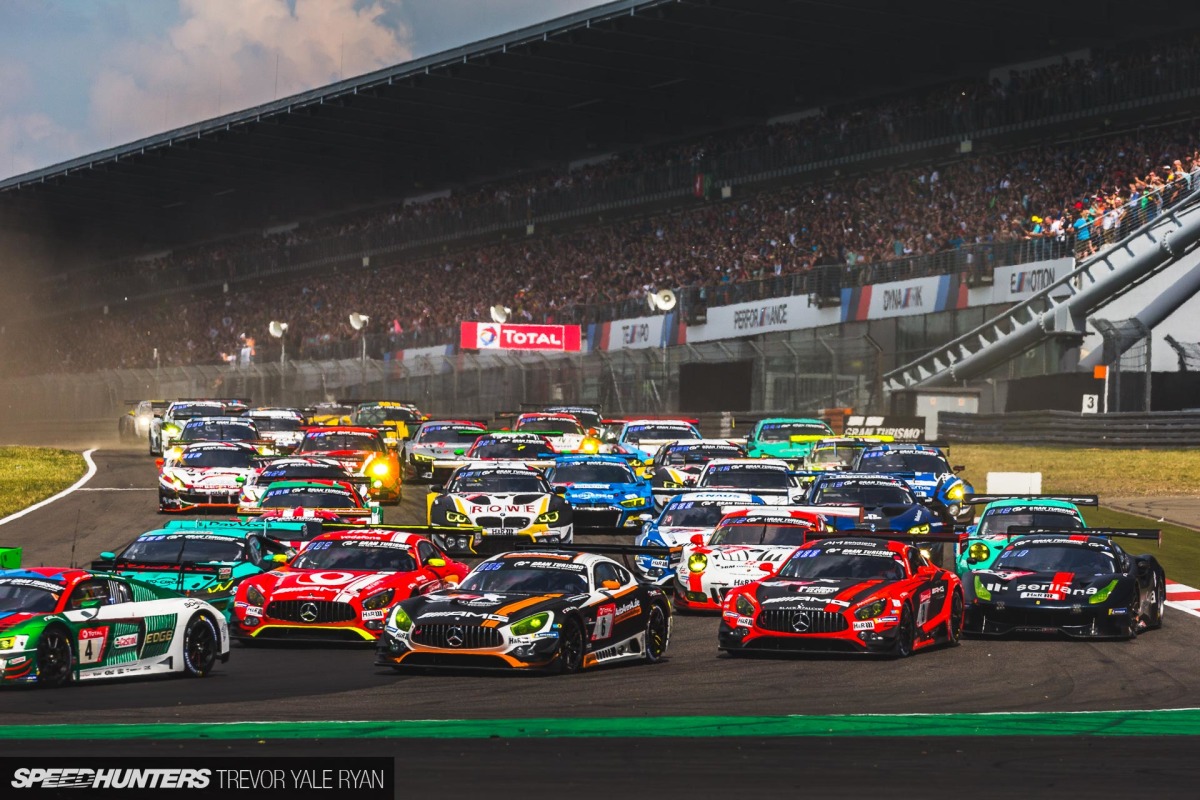
One piece of advice — which I completely ignored at the start of the race — is to not spend much time where everyone is gathered. I’m sure a million other photographers got a shot like this one, although I’m curious if their photos were all as destroyed by heat waves as mine is.
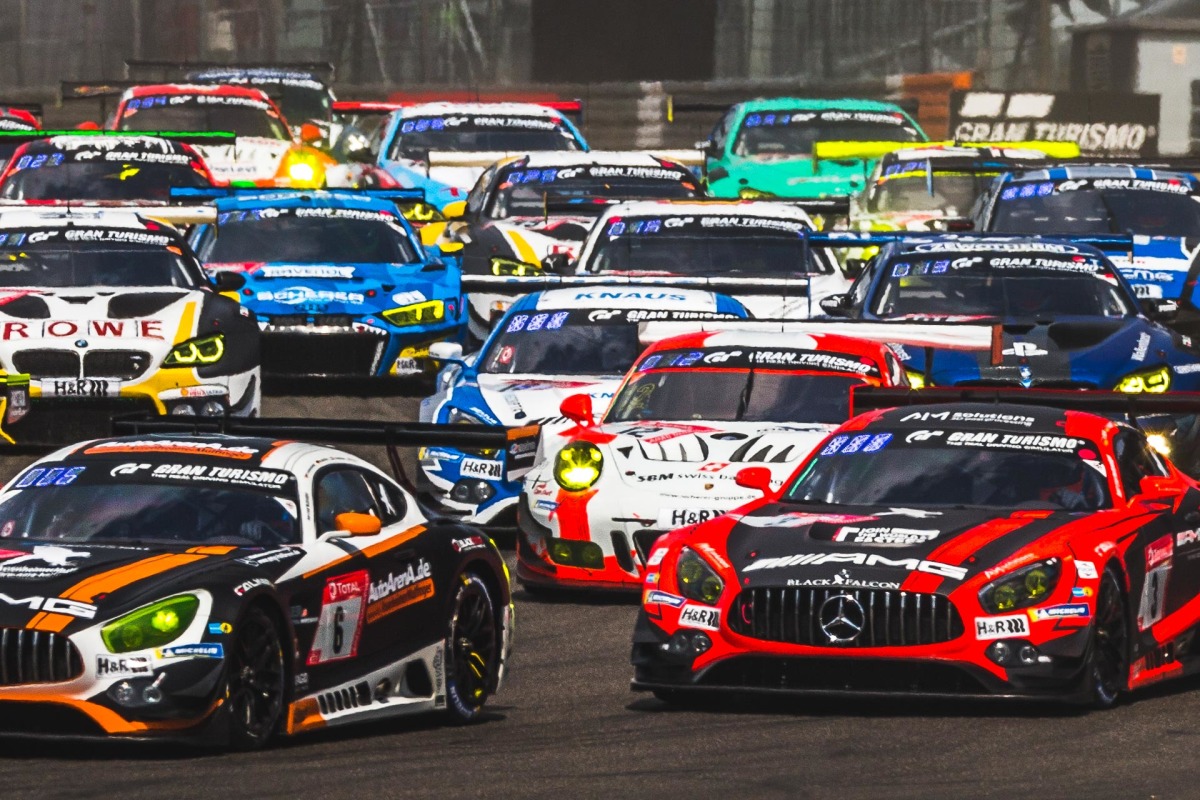
It’s passable for web and fine for Instagram, but if I was to make a large print I’d be sorely disappointed.
Essentially, the sharpness of any image taken with longer lens like a 400mm will suffer when shooting over asphalt on a hot day. You can minimize this by shooting over grassy run-off or similar as much as possible and higher-end gear will do better at focusing through the blurriness, but ultimately there’s no way around it entirely.
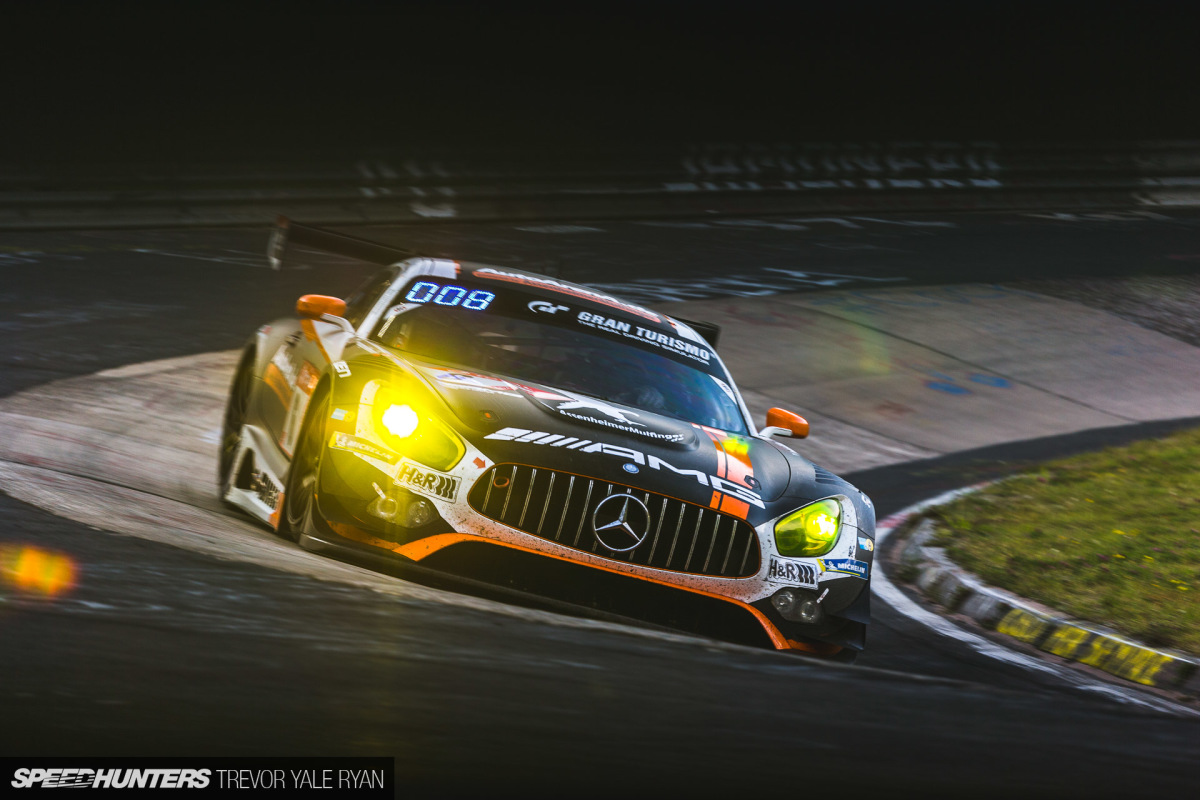
As for location, you’ll often find that crouching or laying down (if it’s safe to do so) will yield far better results no matter where you are. At the Karussell I tried – with varying success – to shoot between the gap in the barriers around the outer edge of the track.
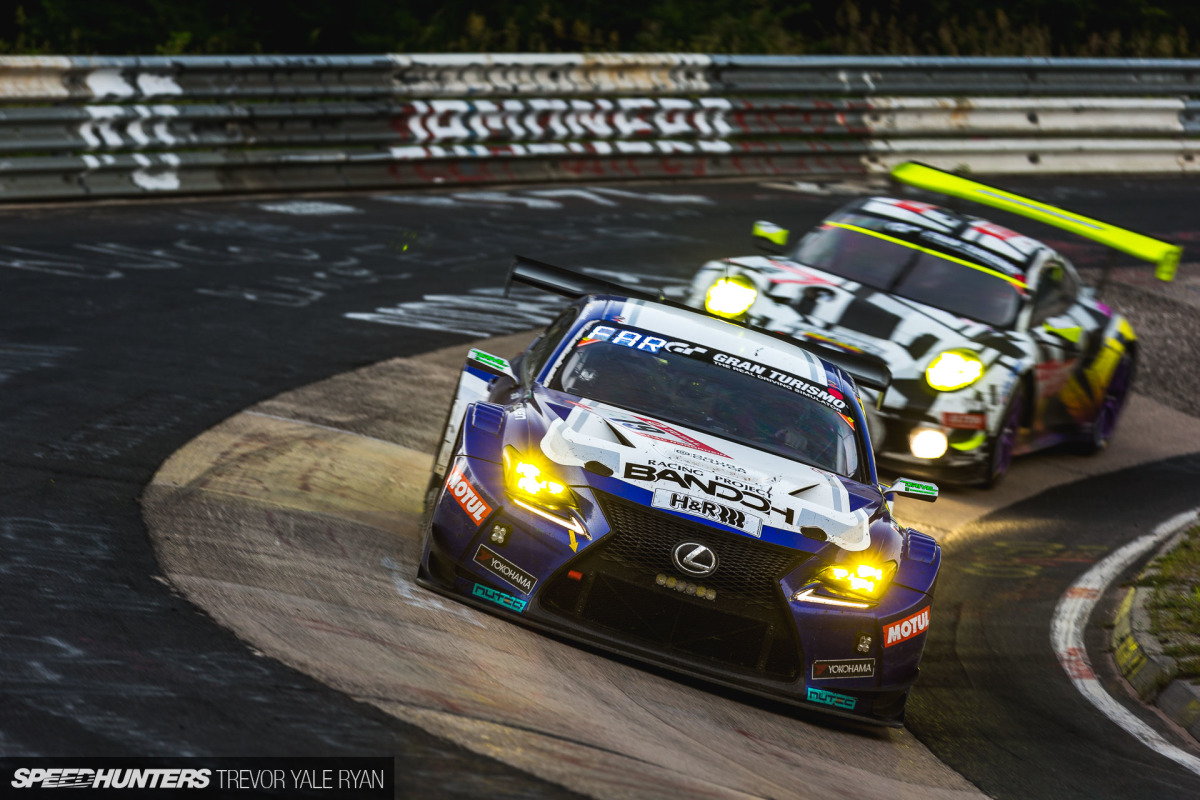
While it’s arguably a more unique shot than the standard shot I’ve seen a million times from here taken standing up, my keep rate was poor and I wasn’t a fan of how my shots with the 35mm were coming out using this technique.
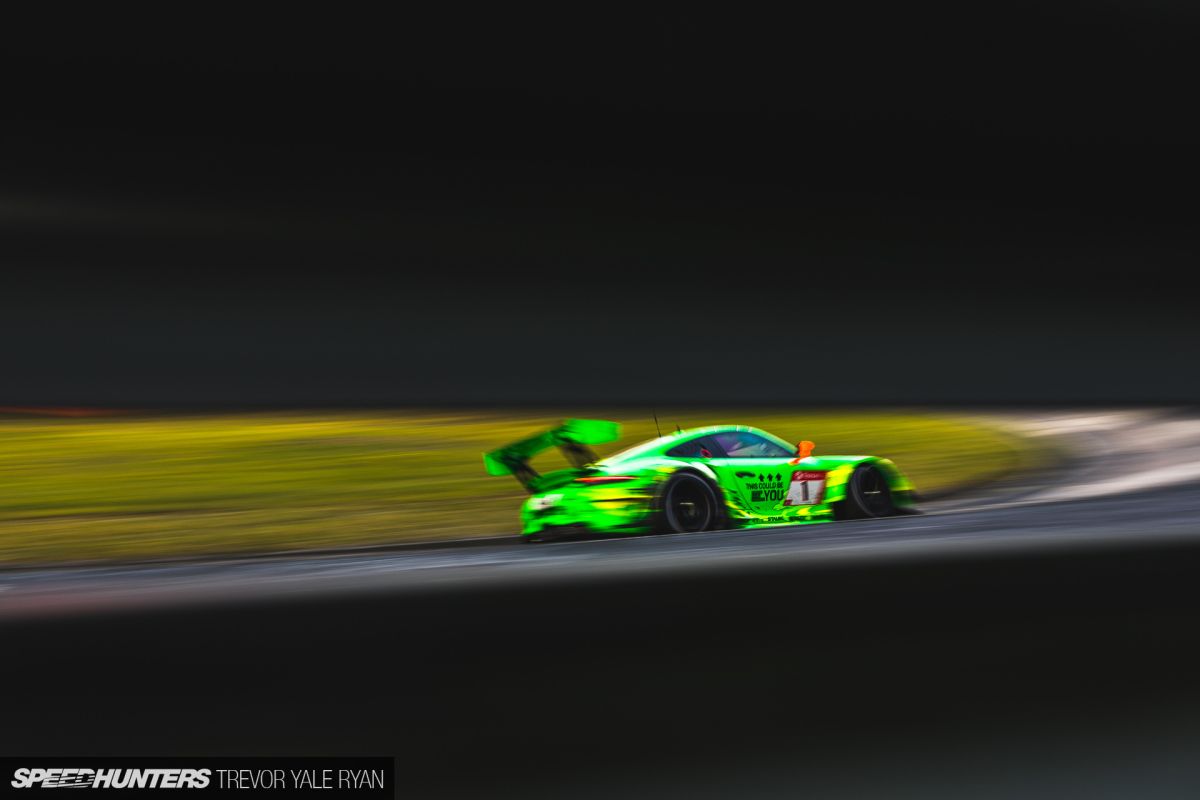
With the wide angle they just sort of looked like my shutter was broken and obscuring half the photo and didn’t really provide any extra context.
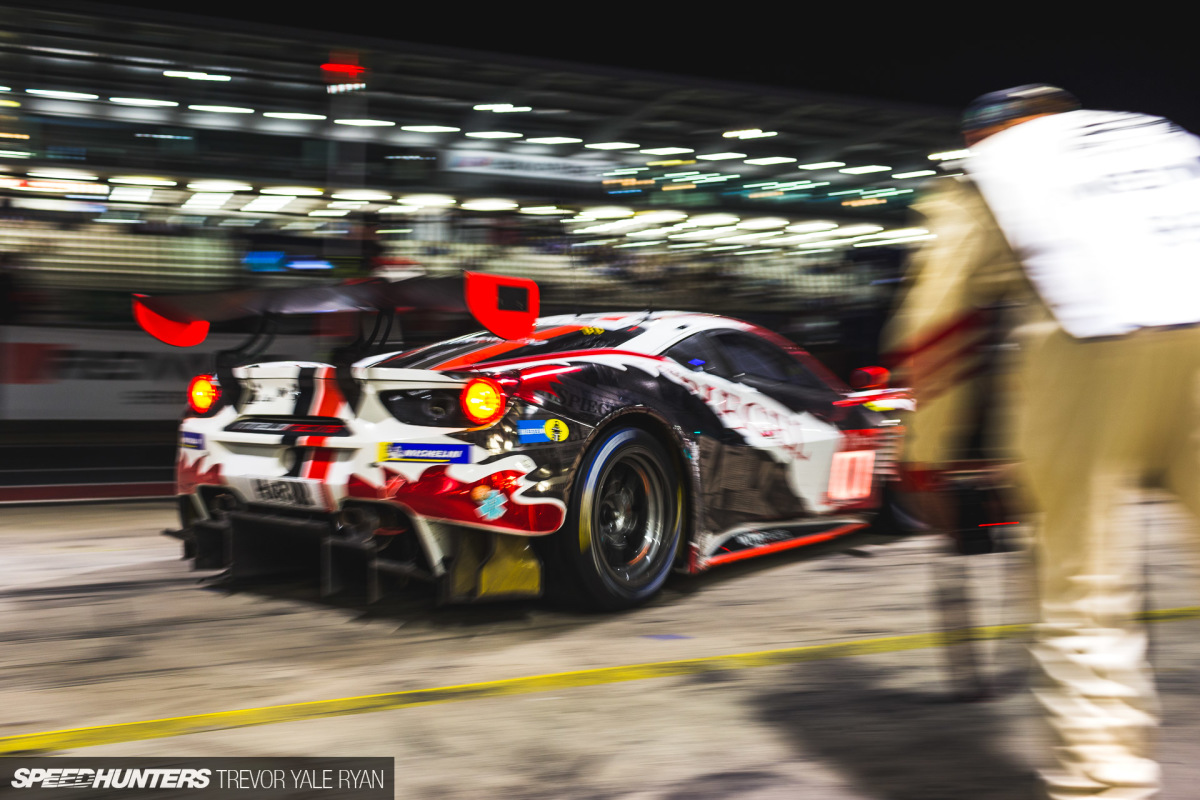
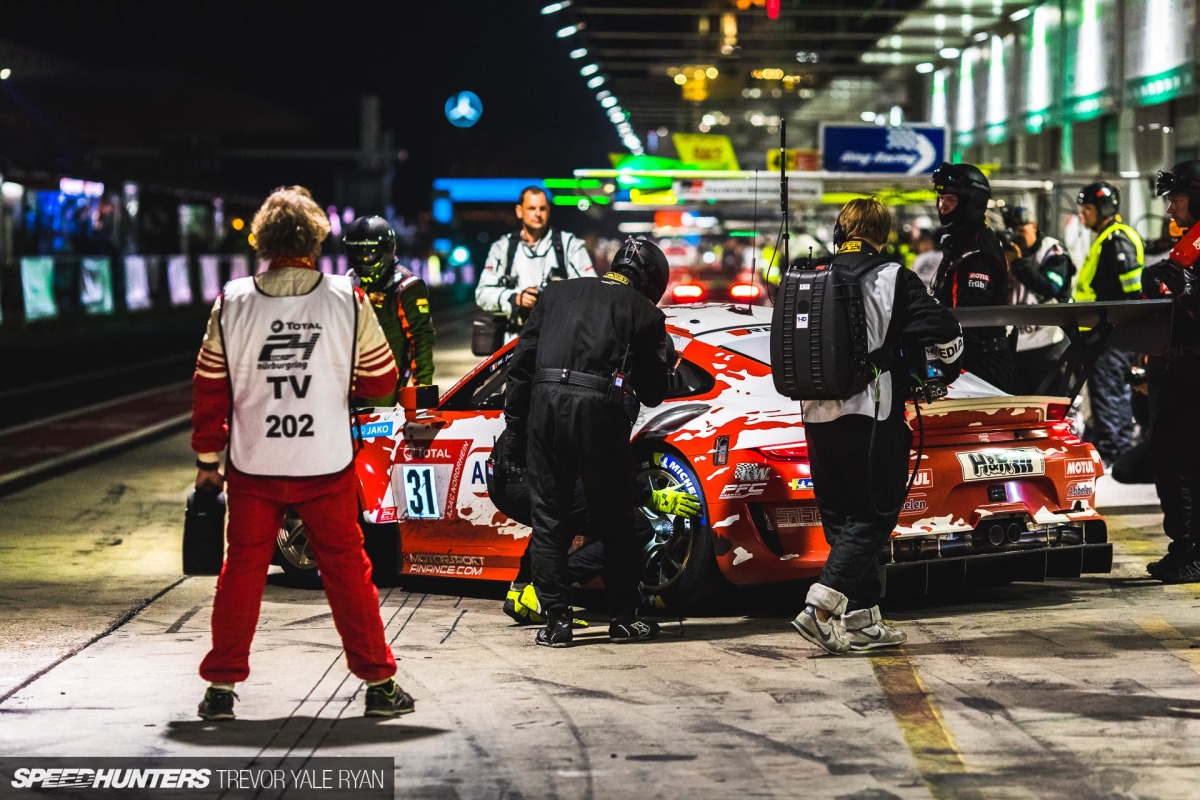
When night fell, I headed into the pits as they’re very well lit. This also tends to be when the most action is with drivers making mistakes.
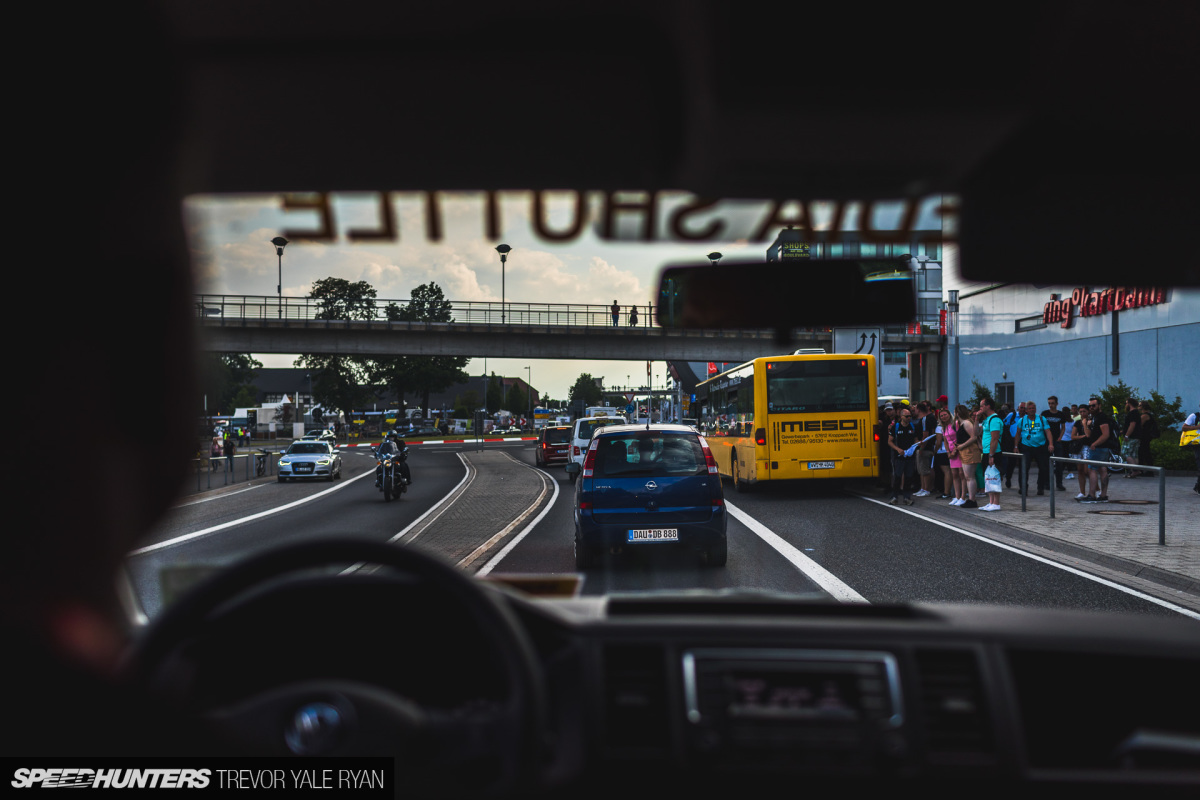
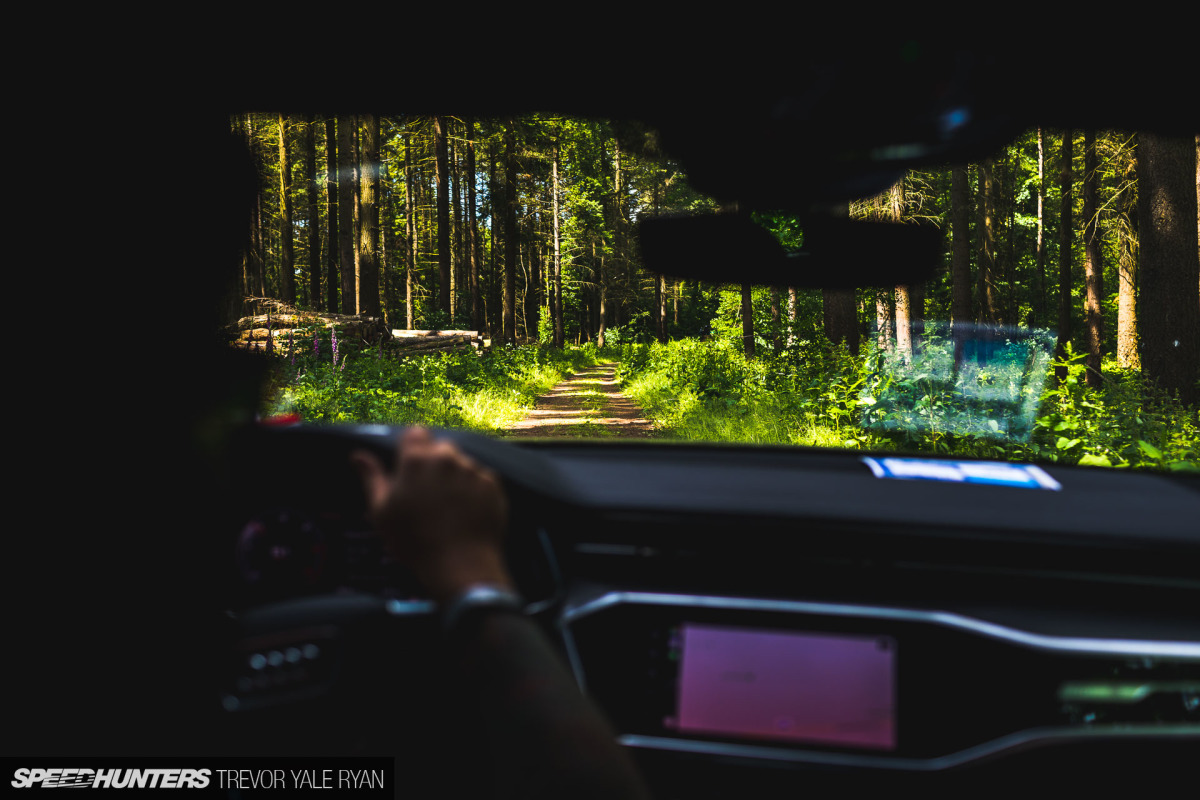
Besides your specific positioning, getting around the track is critically important when it comes to covering a race like the Nürburgring 24. The media shuttles are great, but a few of you who paid close attention to my main story, and who have shot at the Nürburgring before, have asked how I managed to shoot the Karussell at sundown, Pflanzgarten at twilight, Kleins Karussell at nightfall, then the big Karussell again in the dark of night.
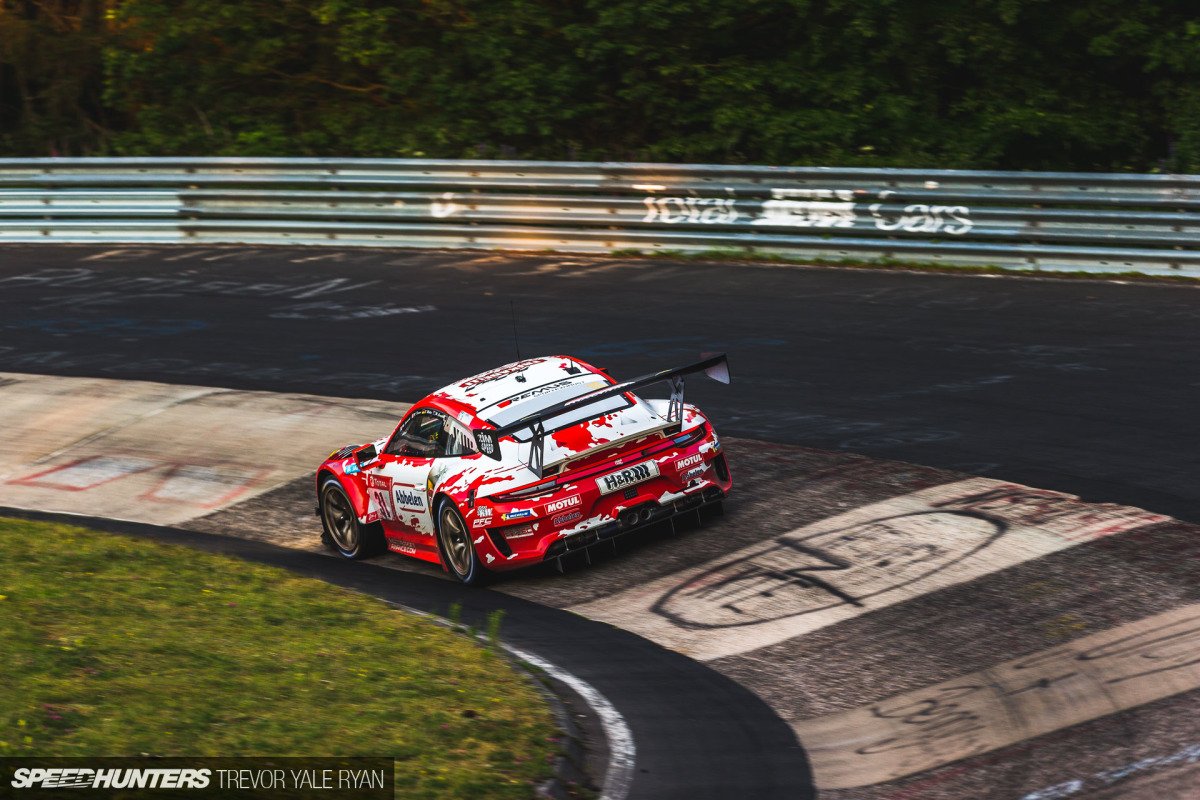
This question comes due to the fact that these corners are connected only via steep hiking trails which stretch about 4 miles (6.4km) between the aforementioned corners and back again.
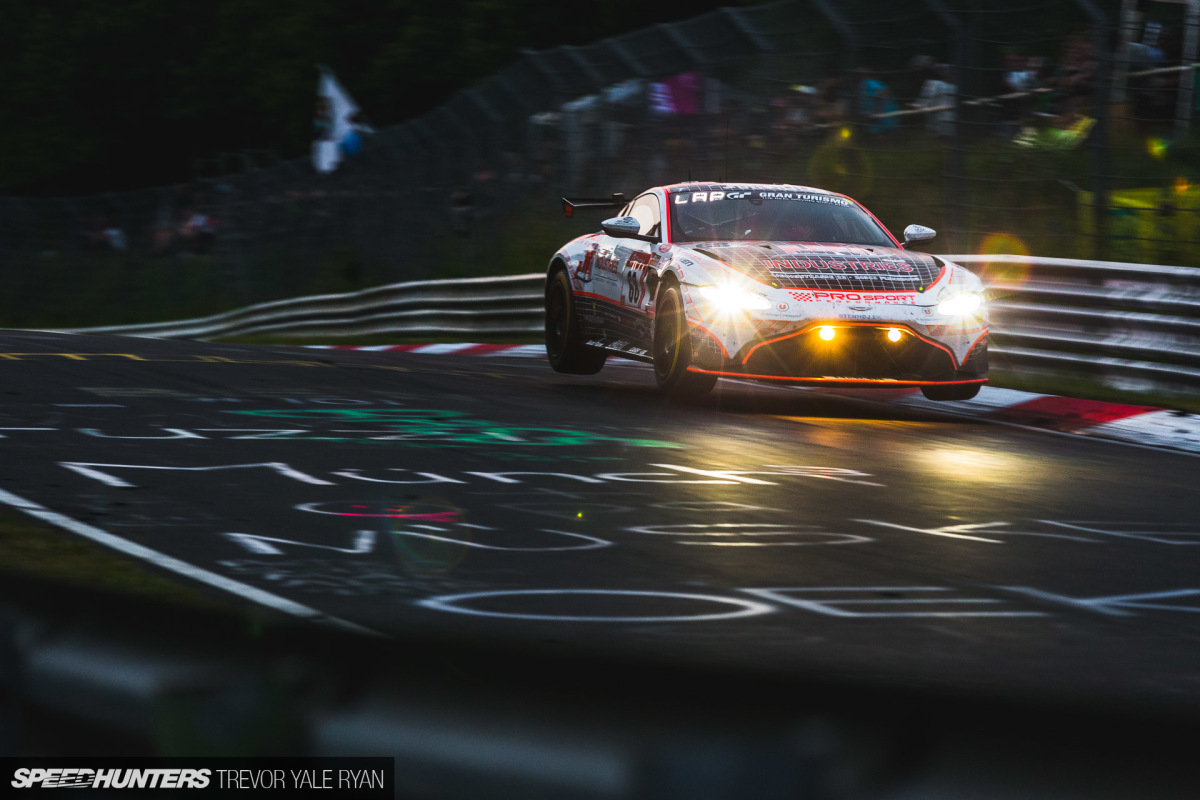
The answer comes down to dumb luck, a bit of ingenuity, and (maybe) a lot of stupidity.
As I was hiking around the inside of the circuit at dusk pair of (very questionable) gentlemen in a somewhat questionable vehicle asked if I could use a lift. Obviously, the answer was yes, but I had no idea what I was getting myself into.
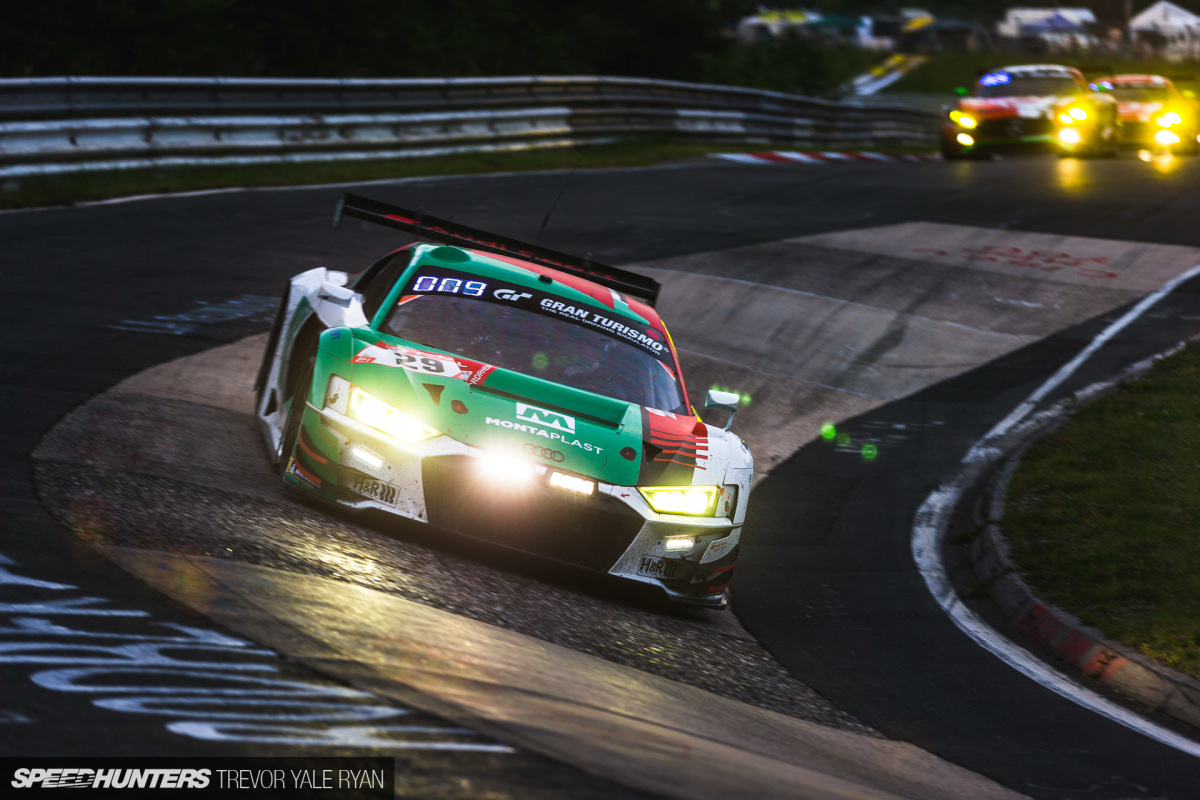
They were very British, so luckily for me they spoke English, or at least some version of it, but I still had no idea what they were talking about half the time. We bounced violently around the trails back and forth to different corners from around 10:00pm to 2:00am, at which point I turned down their offer to drive to who-knows-where, and counted myself lucky that I hadn’t been dismembered and left for dead in the forest.
The pair were quite pleased by their knowledge of the backroads, though, and feeding the driver my Red Bull helped fuel our trip around in the dark. Hopefully this strategy works out again for me; I don’t think I could have done the 8+ miles we covered on top of the 12 I had already actually walked earlier that day.
Final Thoughts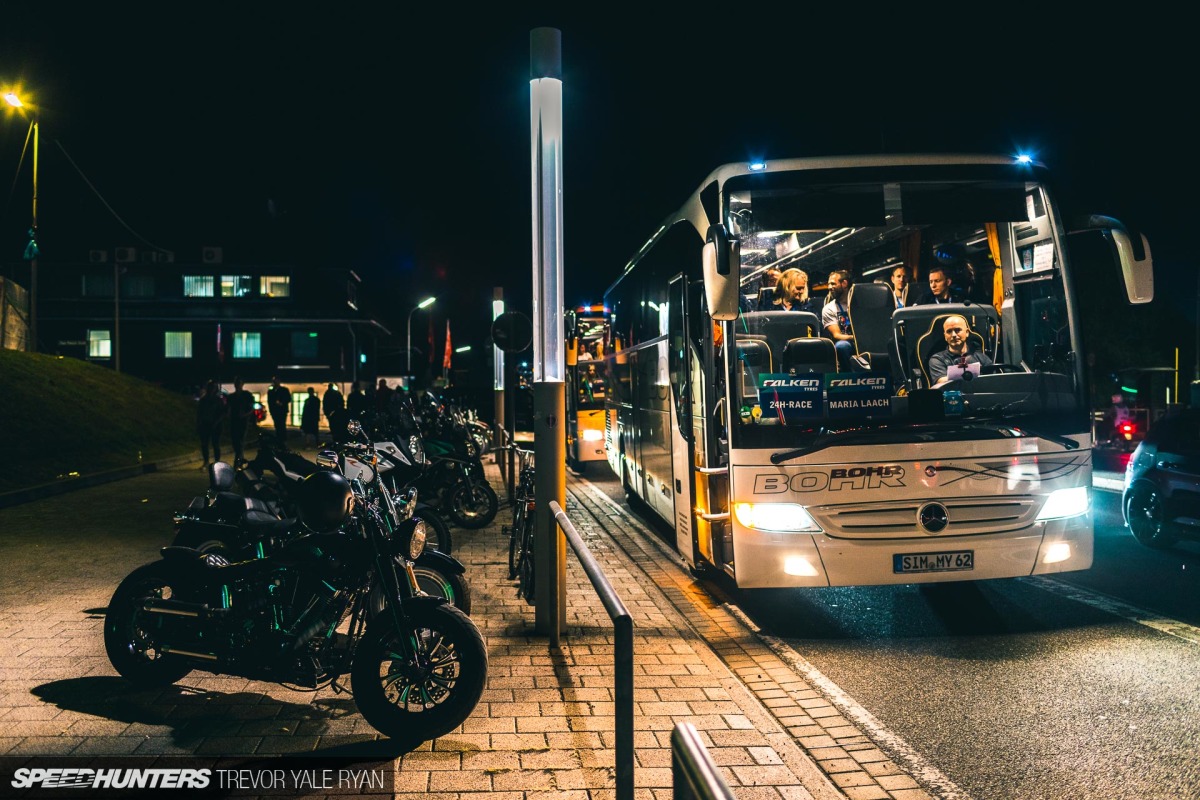
One of my major takeaways from shooting the Nürburgring 24 is that I absolutely have to put the telephoto away from time to time on the track. Shooting wide-angle shots to set your scene is really, really important, and I need to do more of this. The vast majority of my shots with my 35mm or similar were taken around town or the paddock.
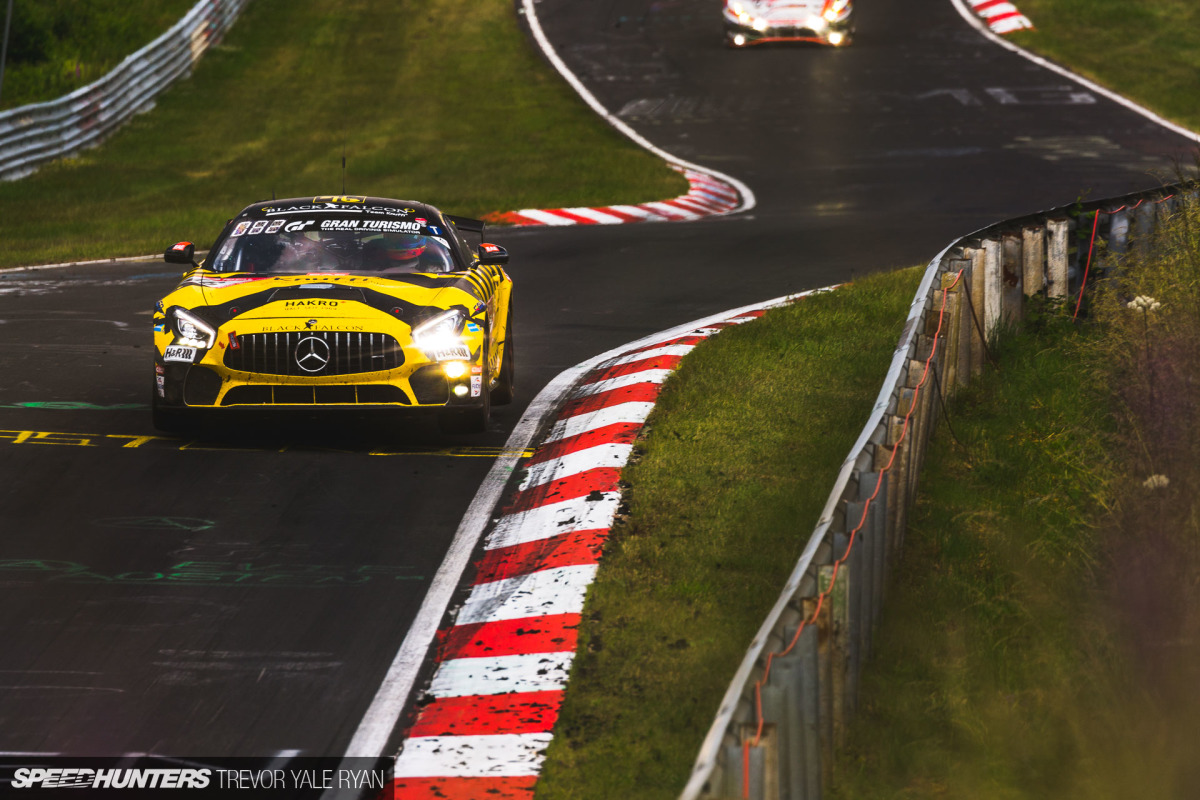
Even zooming out a bit here, for example, would have been nice as I would have captured the Ferrari barreling down the hill in the background as the Merc sailed through the air.
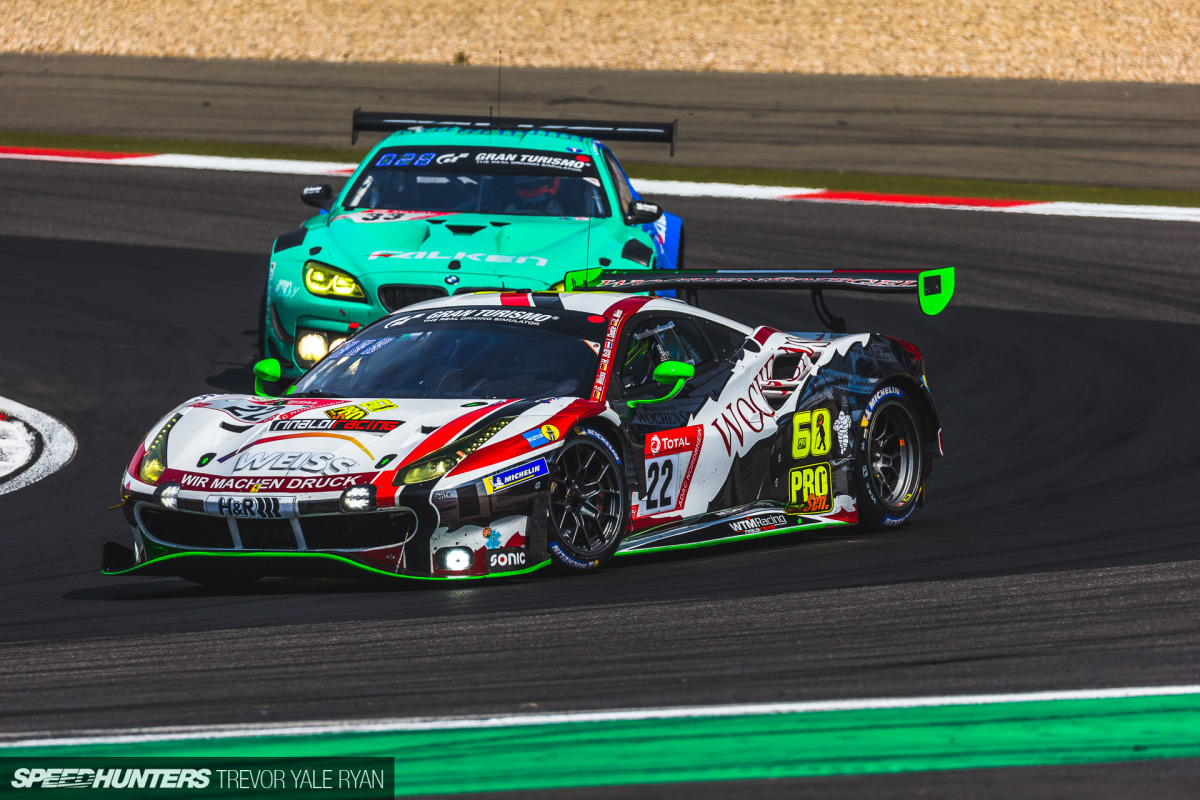
It’s easy to chase absolute sharpness of any image (wide or long), but spending too much time getting finicky about a bunch of shots at 400mm that basically all look the same means you’re just missing out on variety.
Shooting with a wide angle on the other hand means you need to take more care about your surroundings, so positioning comes into play again.
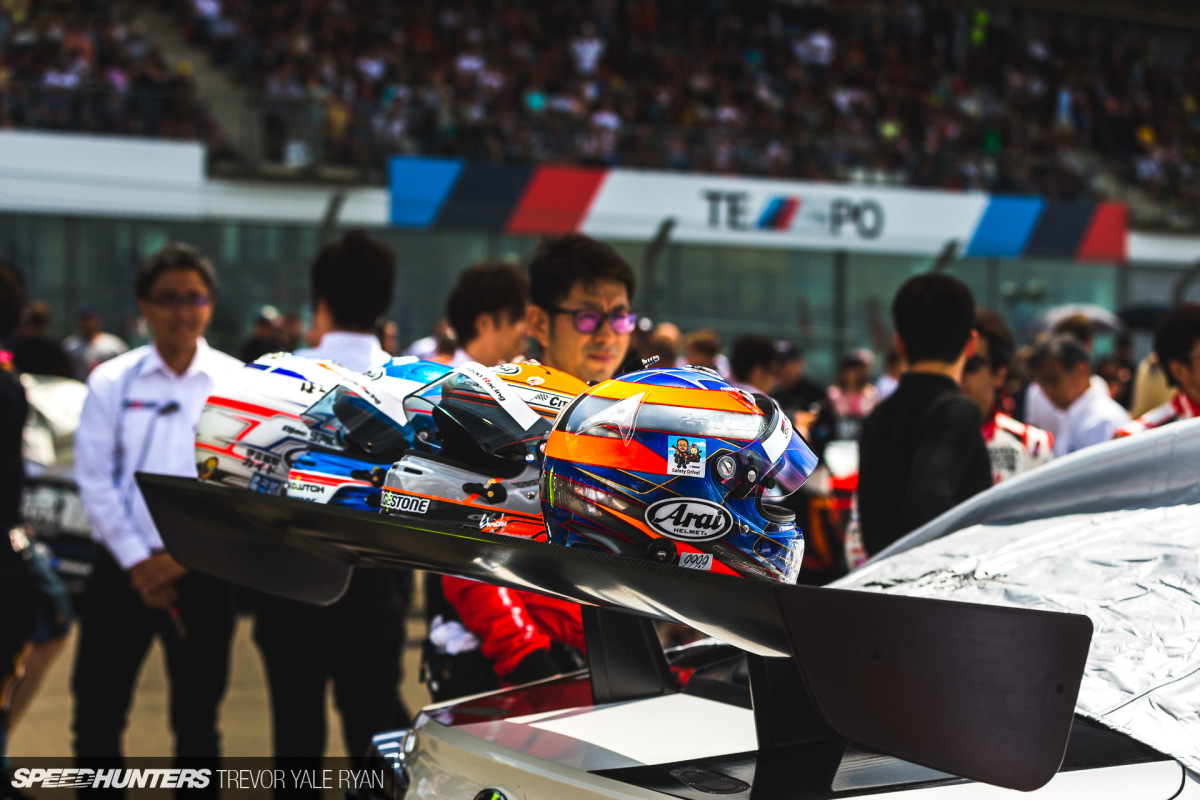
There are countless other details I took home with me, and there isn’t enough space on the internet for them. In the end, there’s no secret to taking photos.
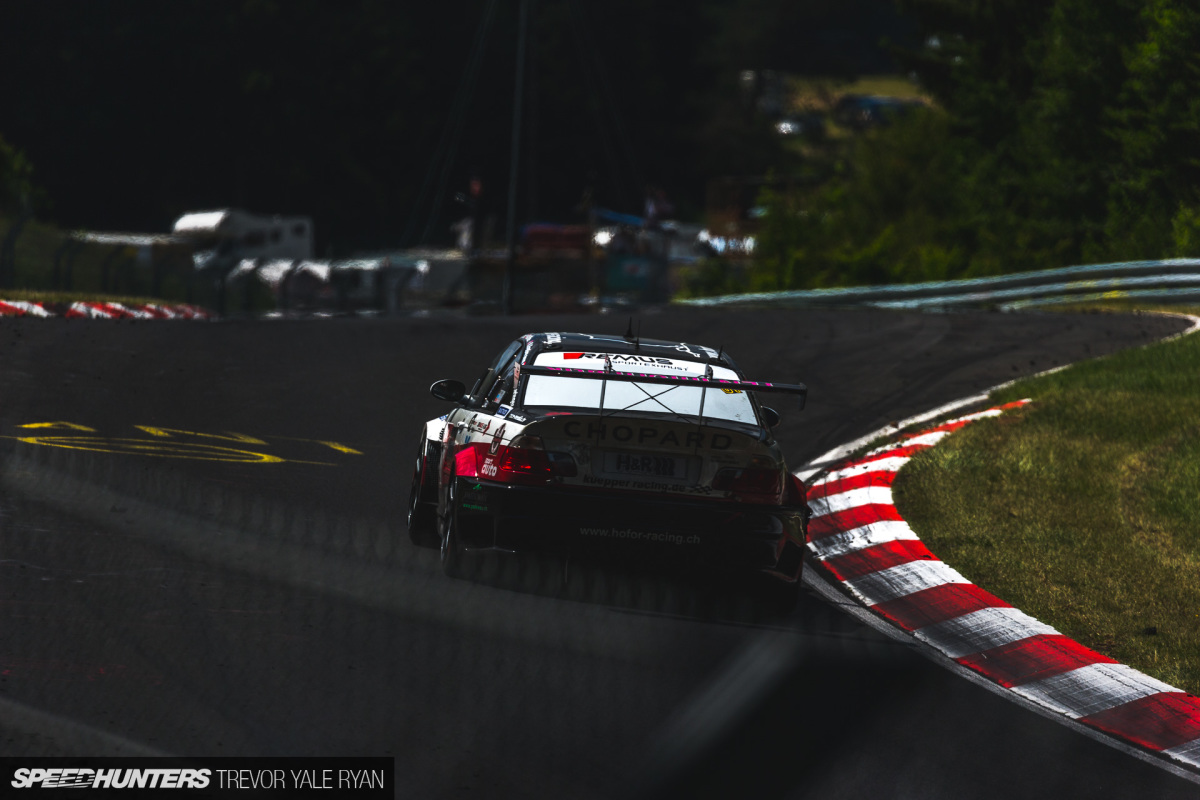
Ultimately, it comes down to trying your best for hours on end, time and time again. There’s just so much to learn, and even over a 24-hour race, it seems there’s just never enough time.
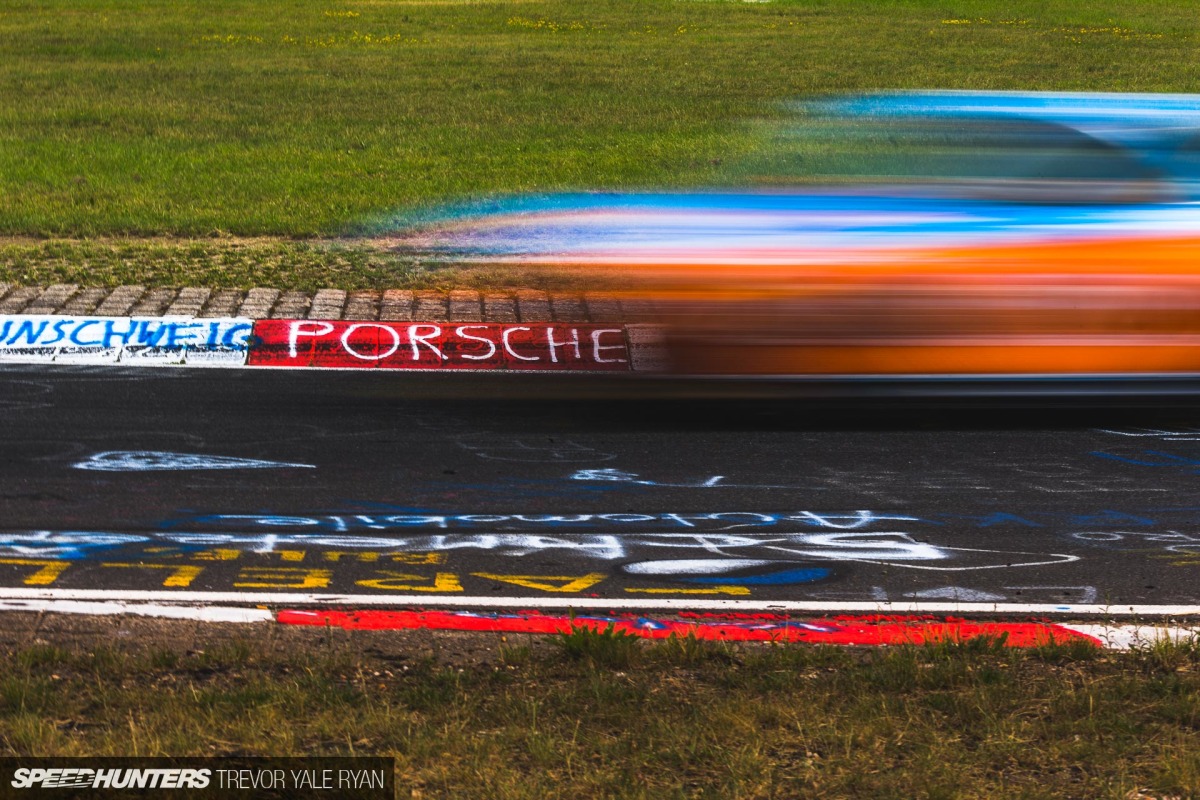
I’m afraid I don’t have any parting words of wisdom to leave you with, but the short of it is this: If you’re looking to improve your work just get out and shoot as often as you possibly can. Try new things and don’t worry if they don’t turn out the first time around. And if you aren’t a photographer, I’m fairly amazed you made it all the way to the end.
Except for you, mom. I knew I could count on you.
Trevor Yale Ryan
Instagram: tyrphoto

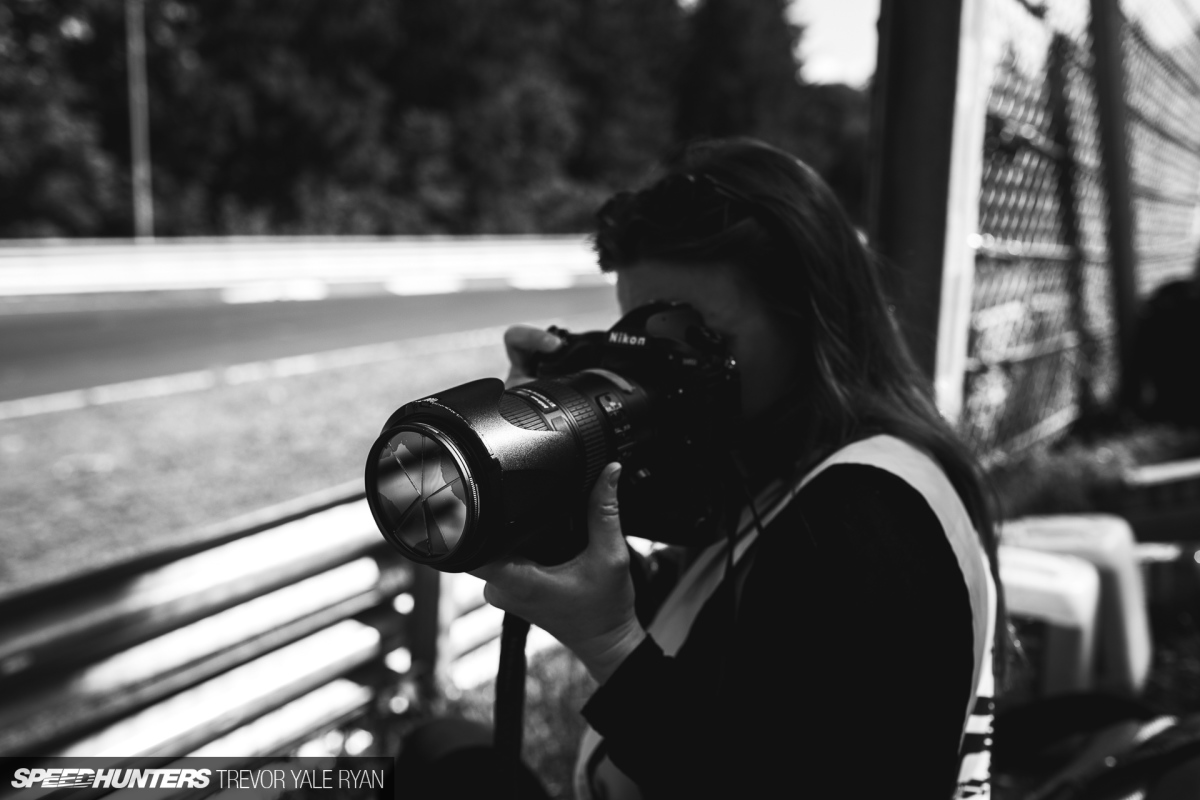
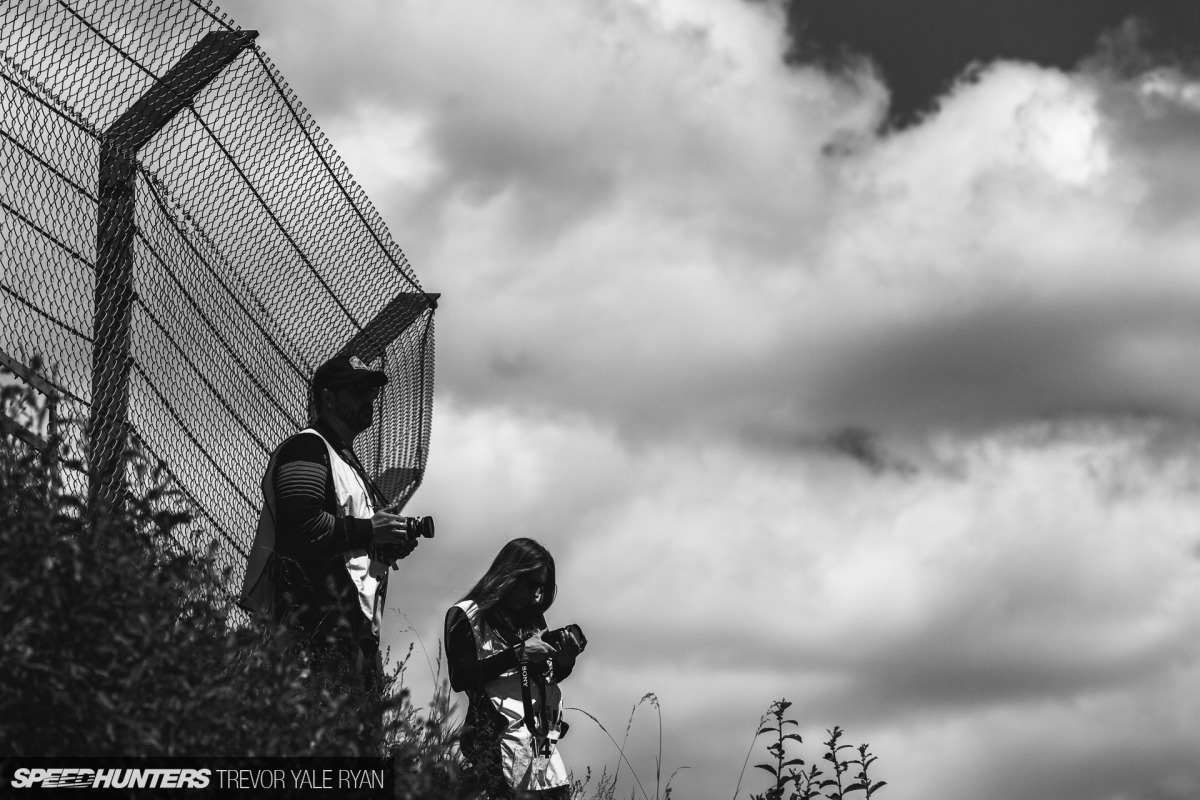
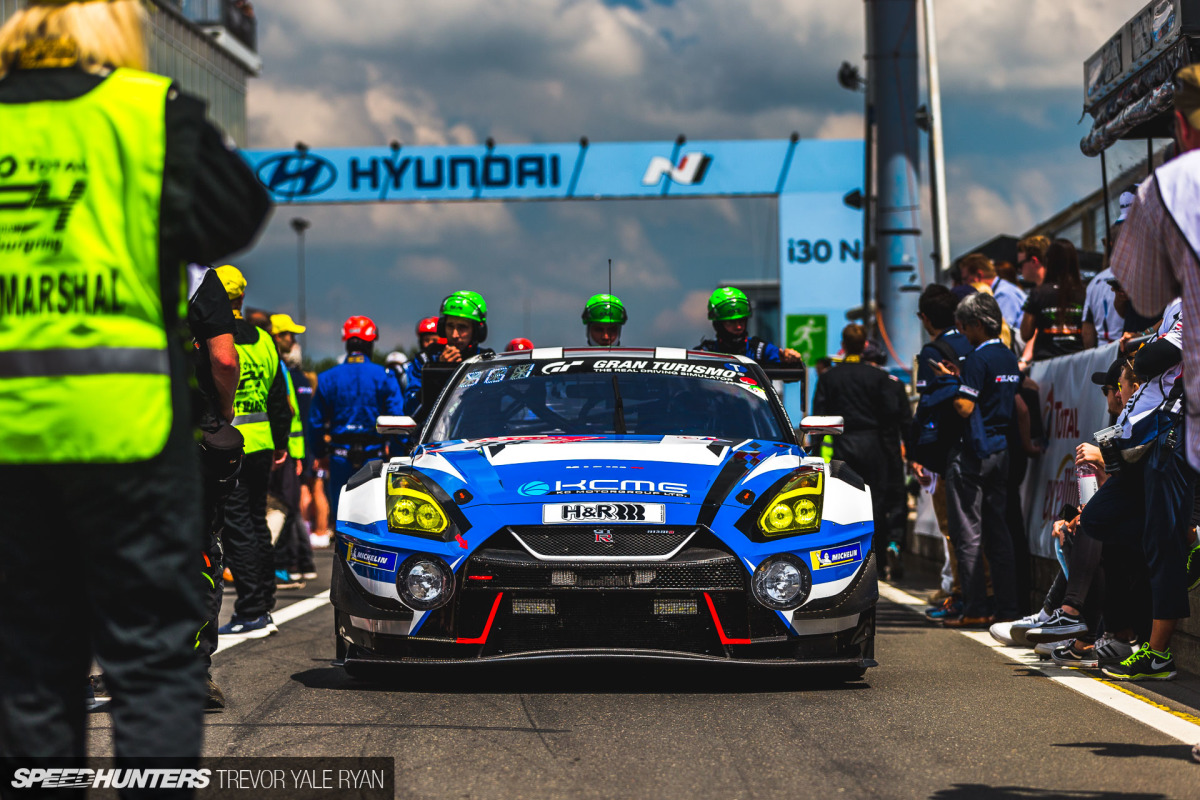
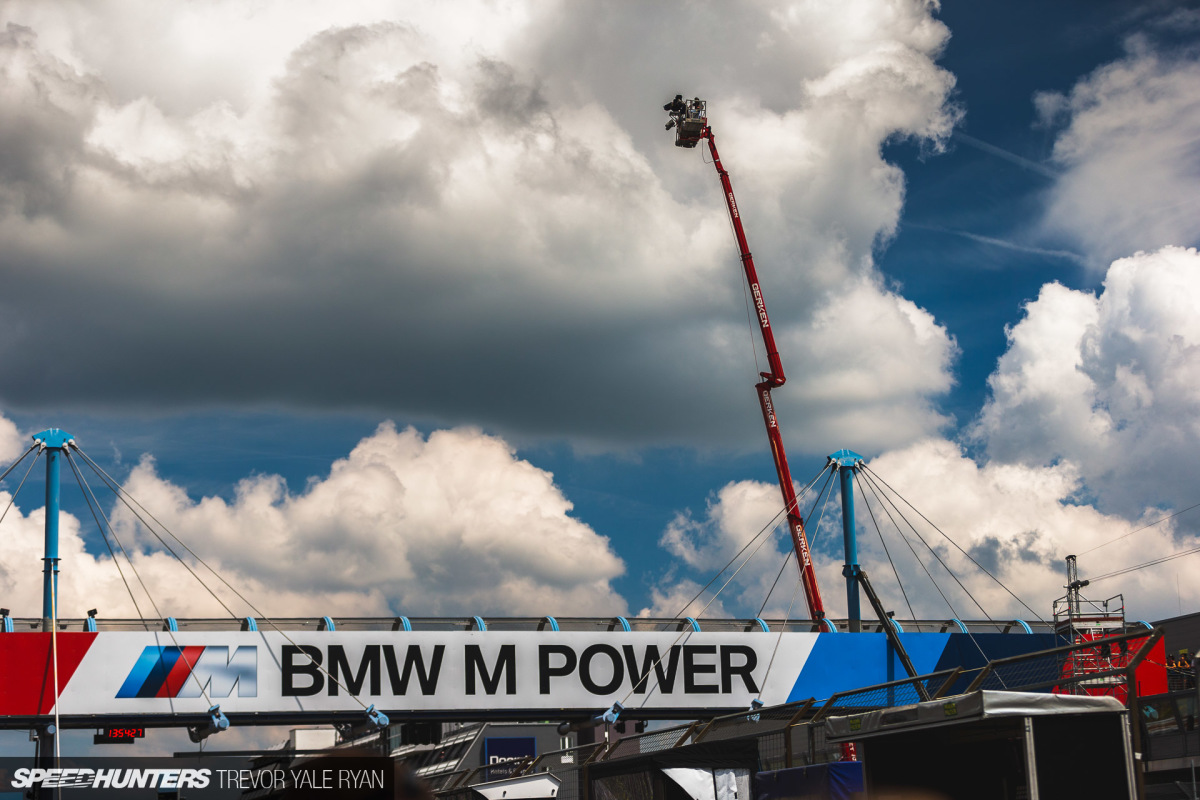
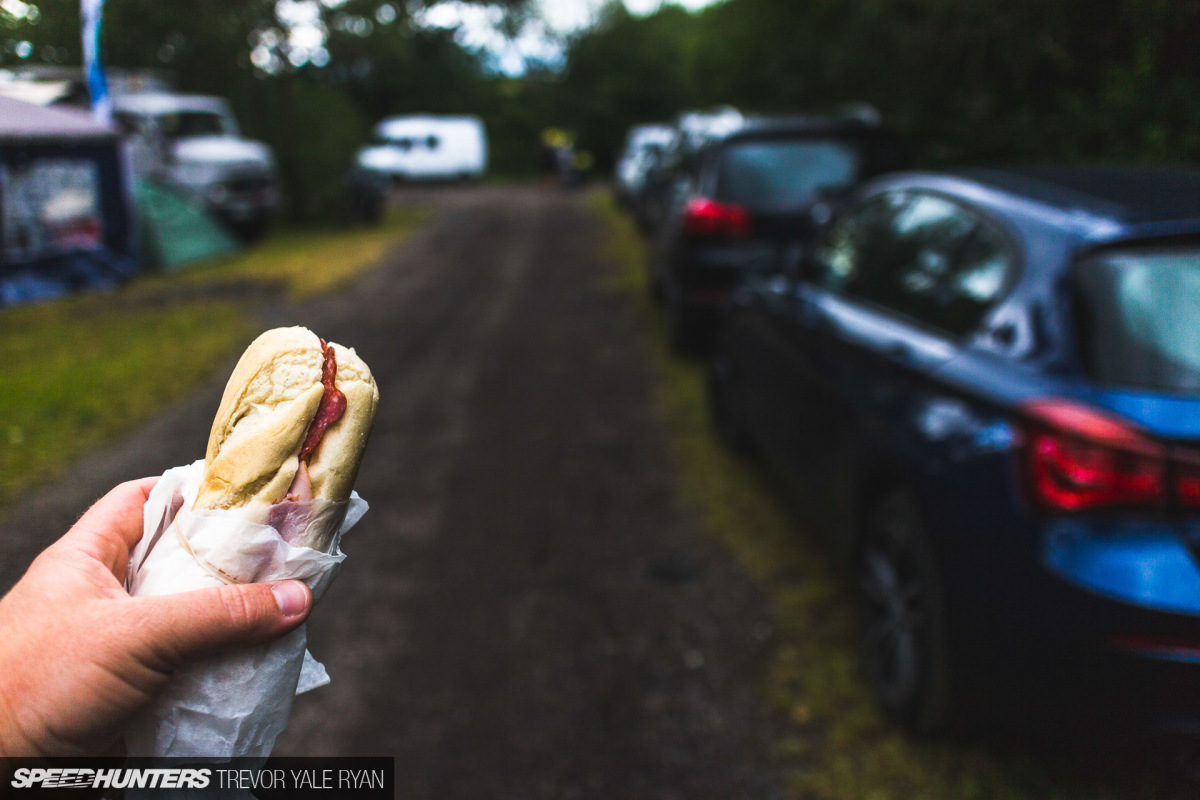

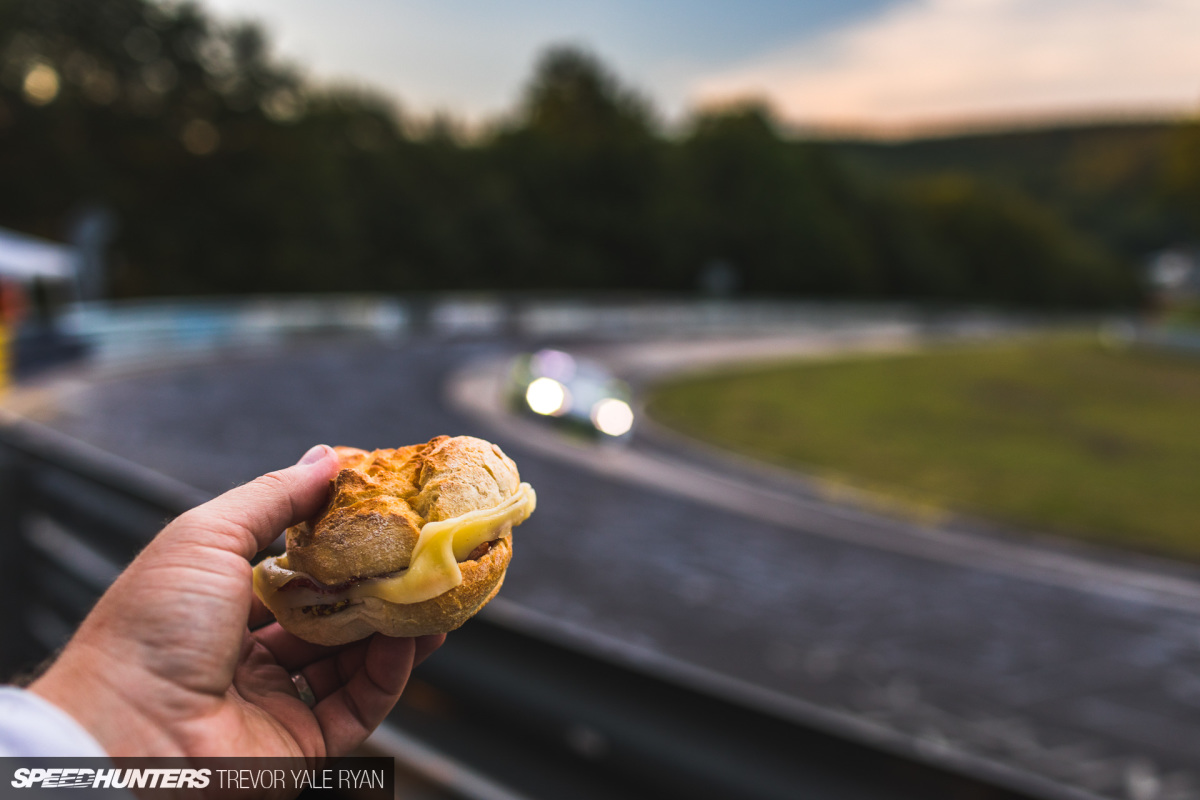
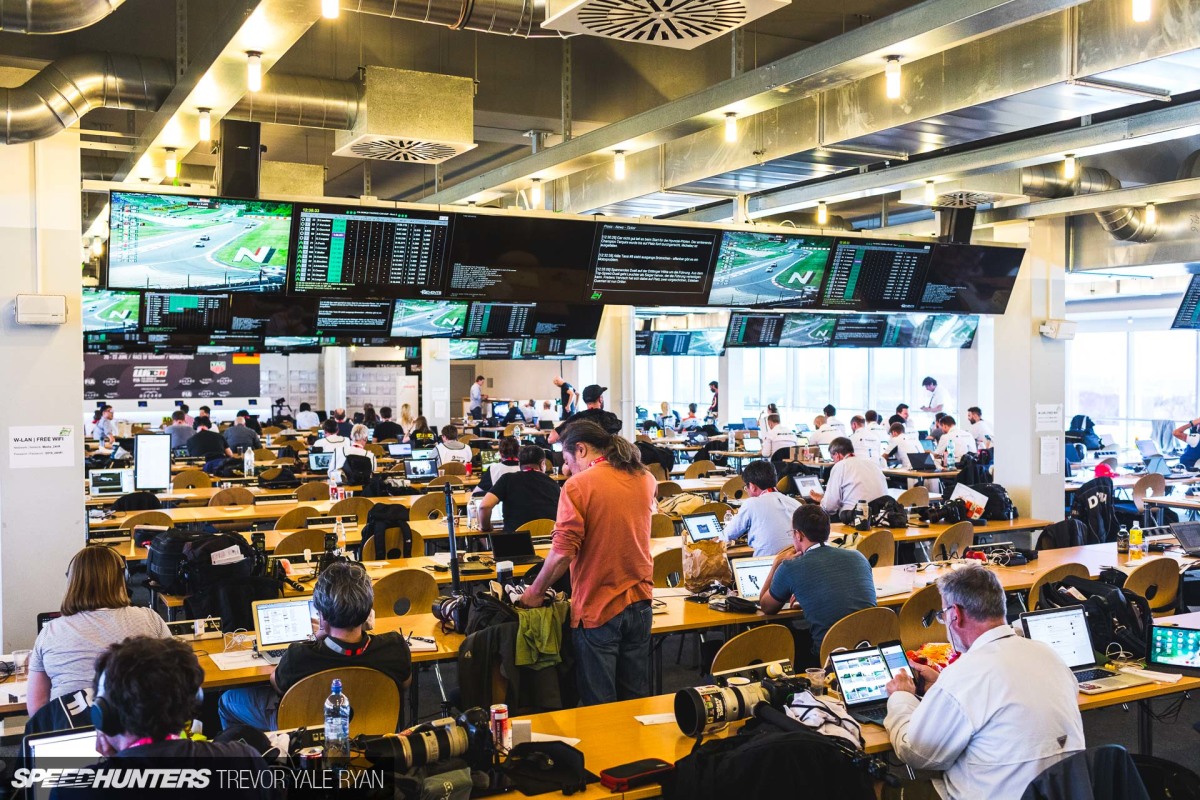
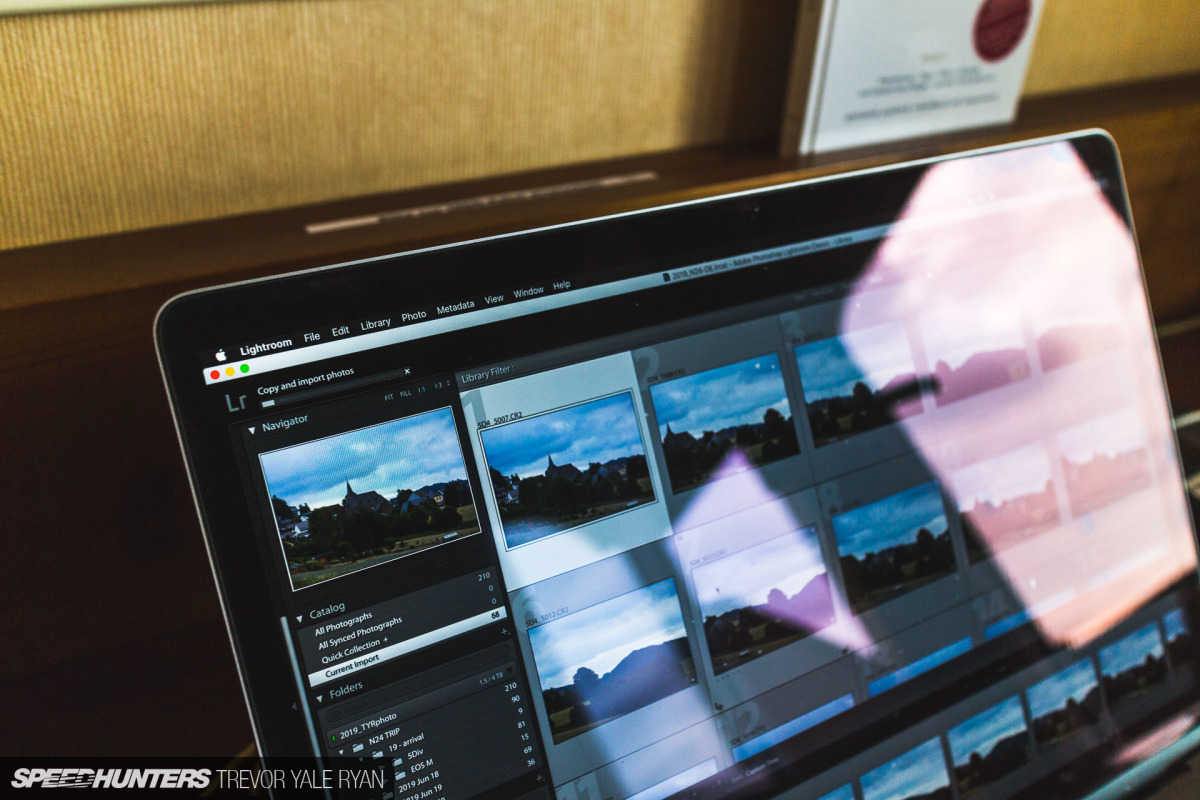
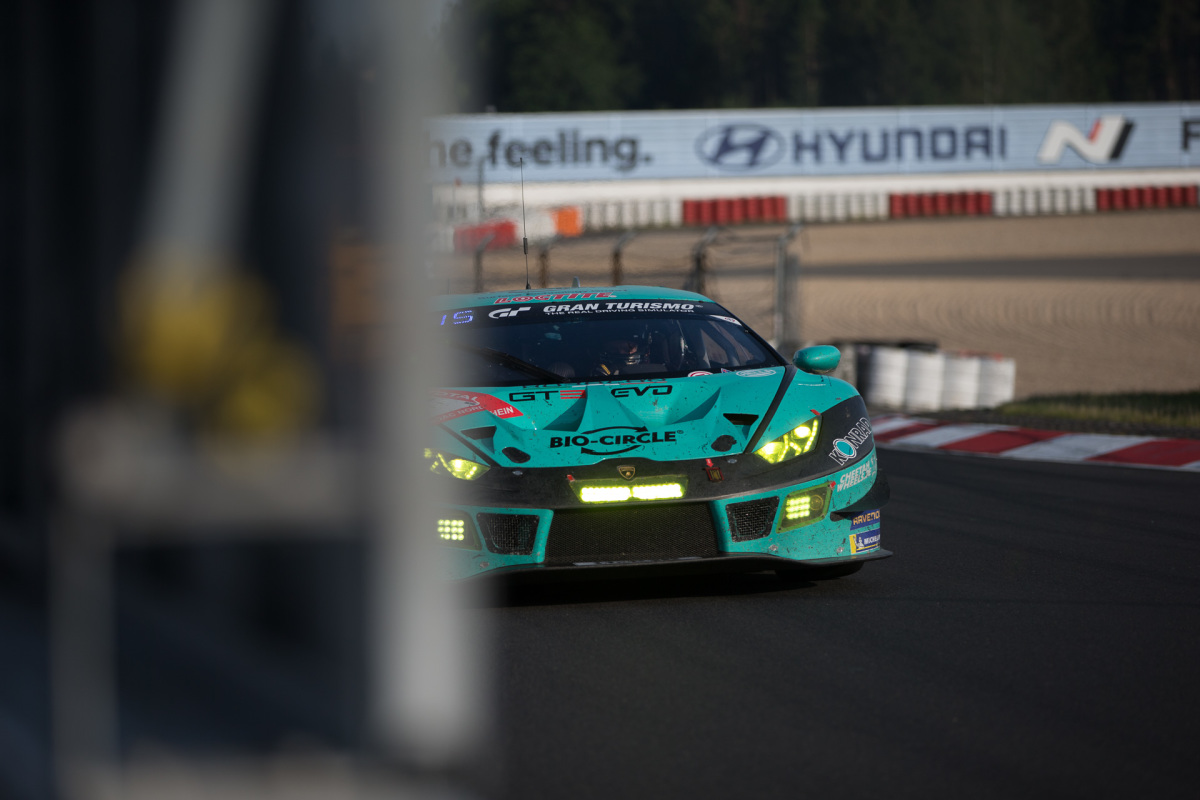
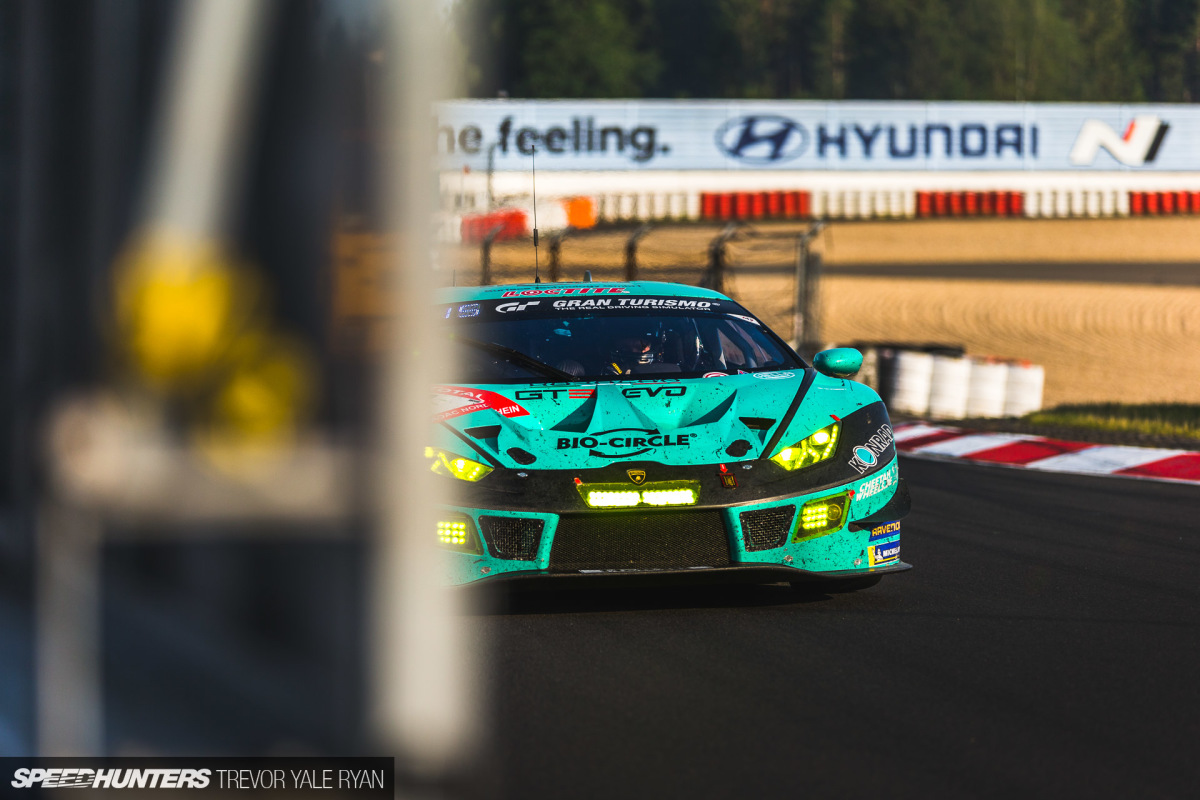
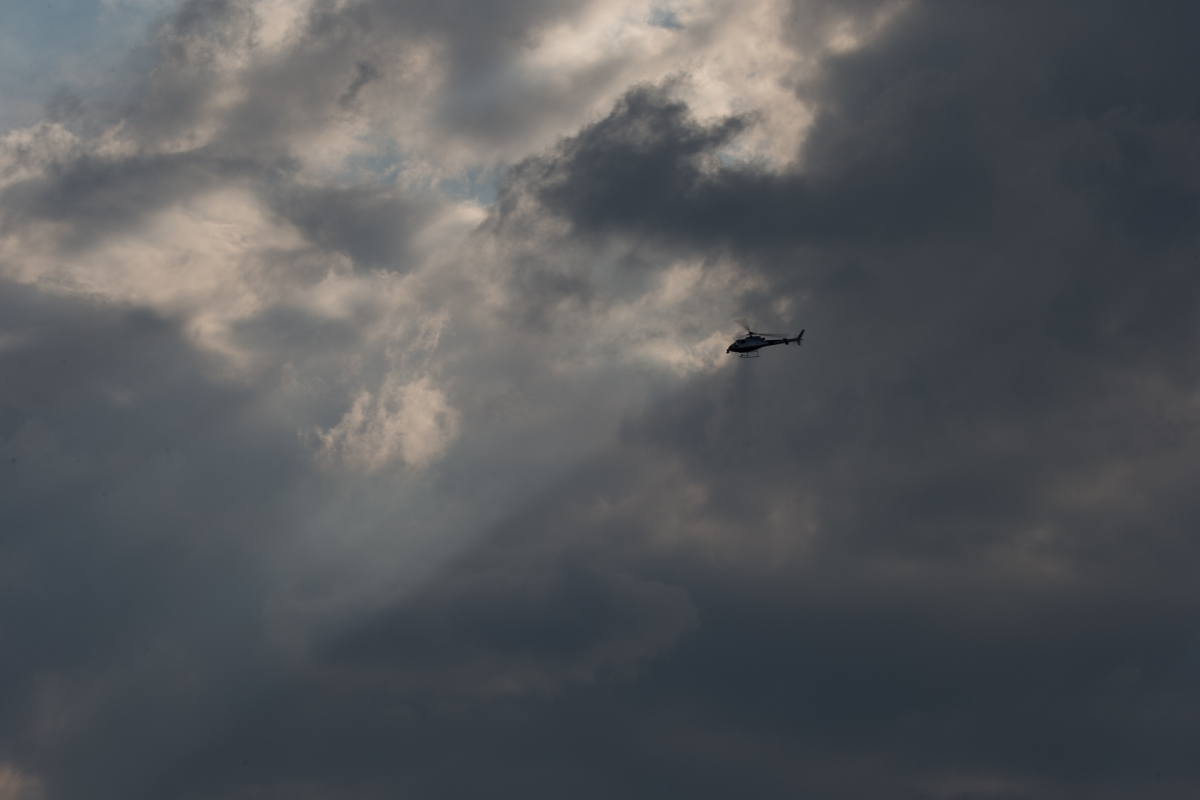
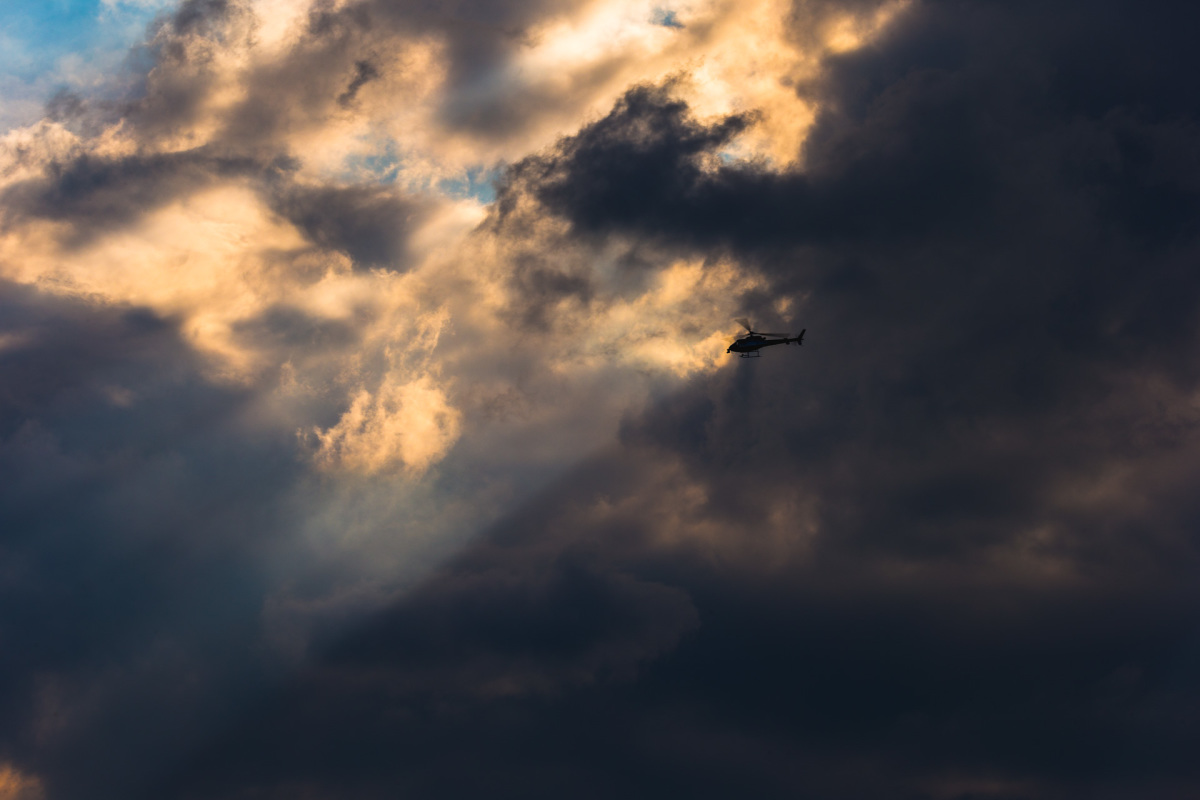
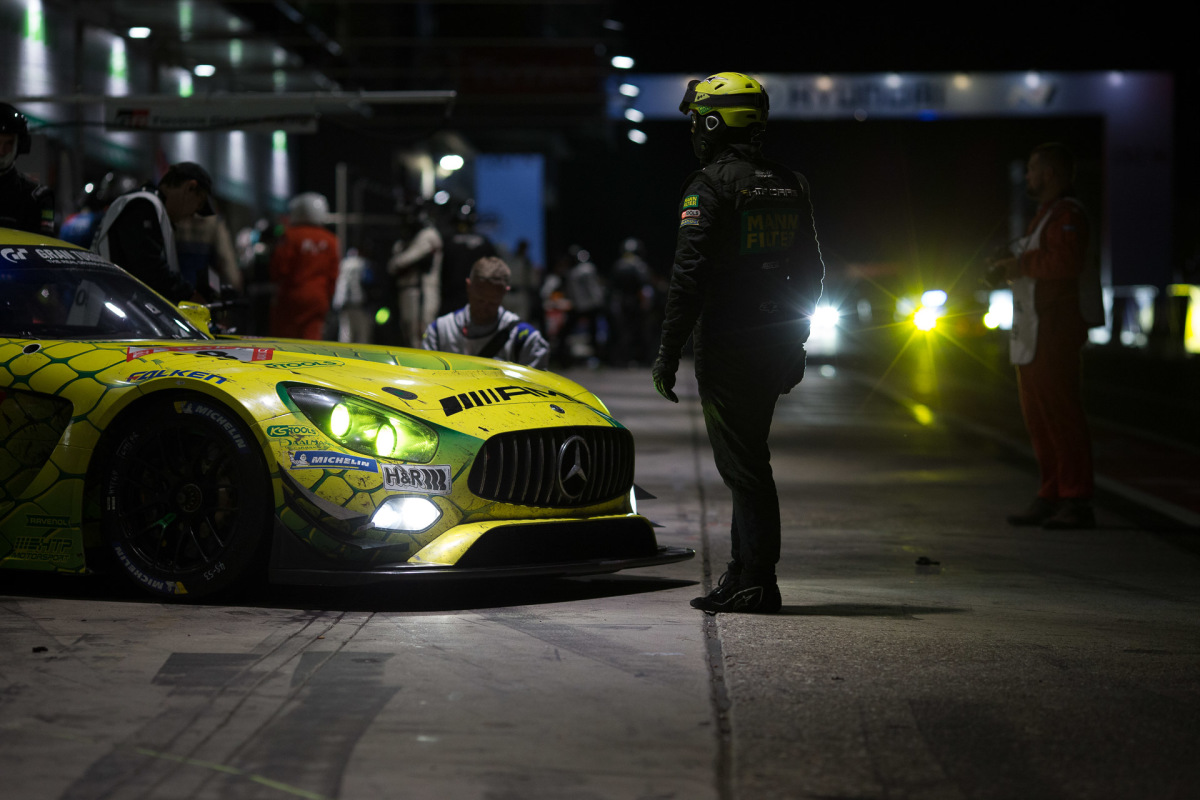
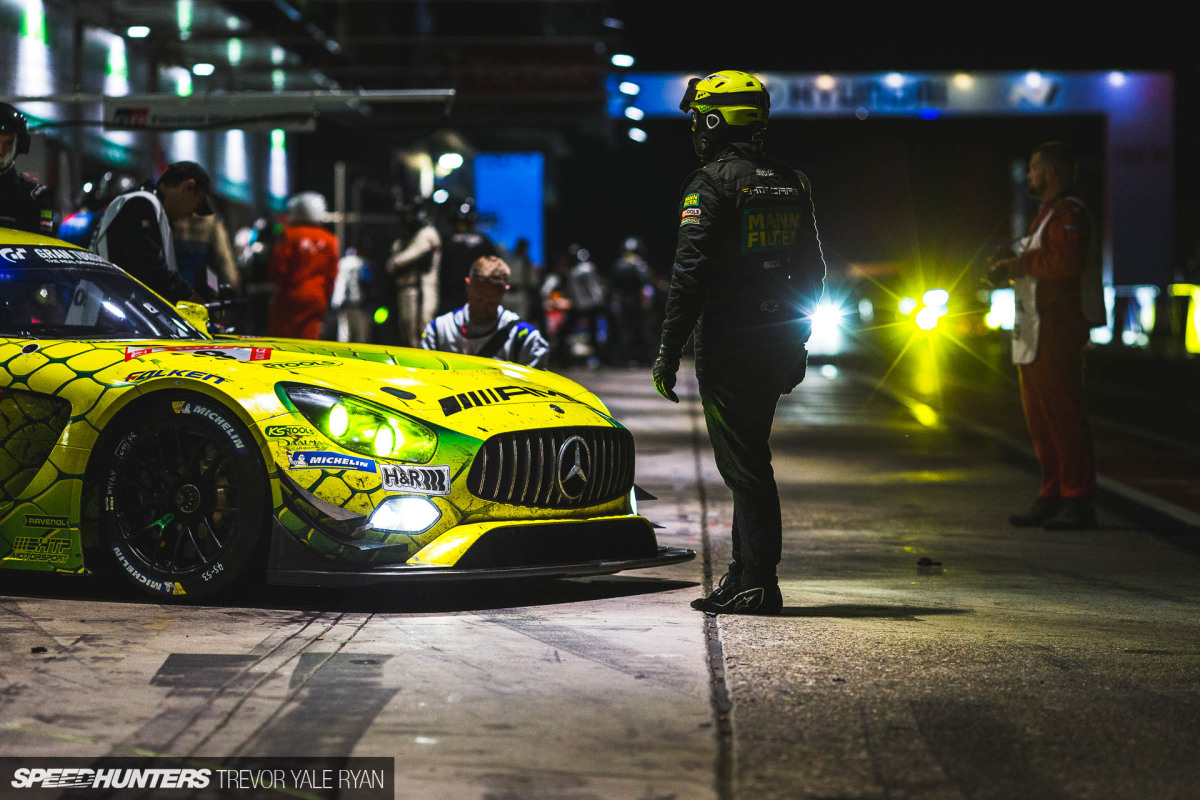
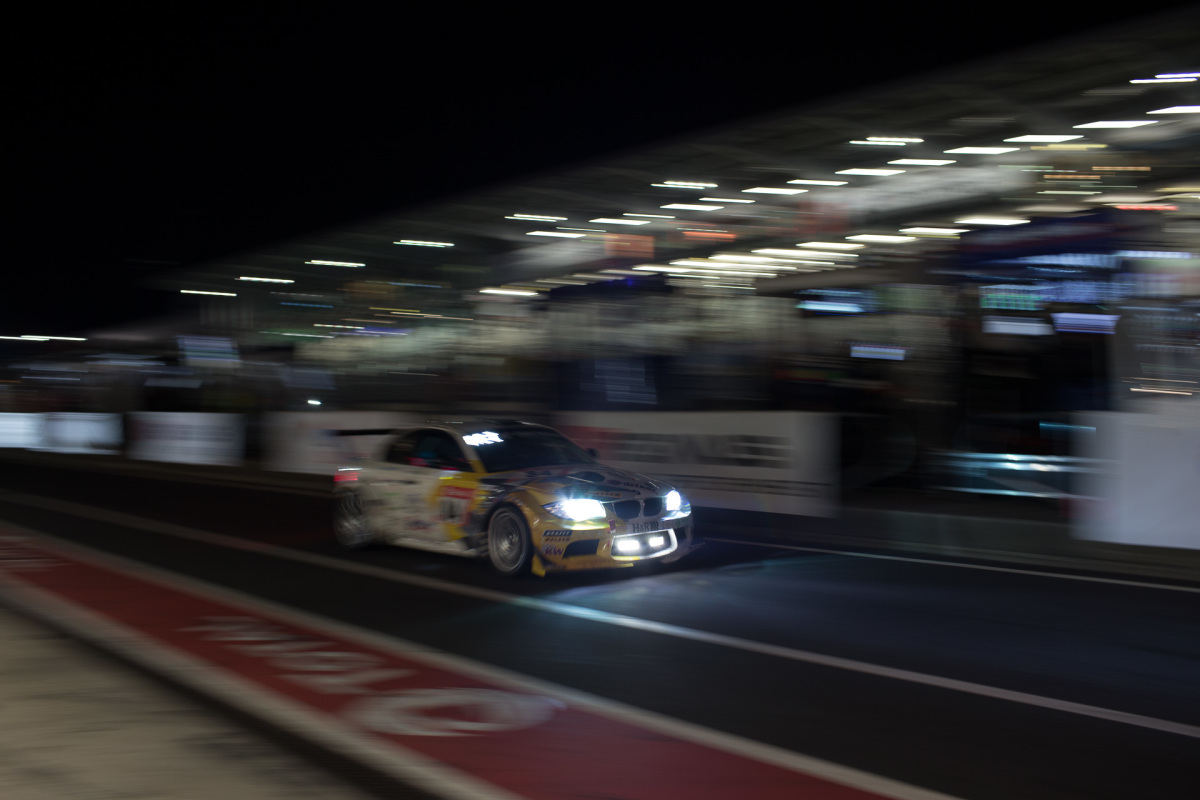
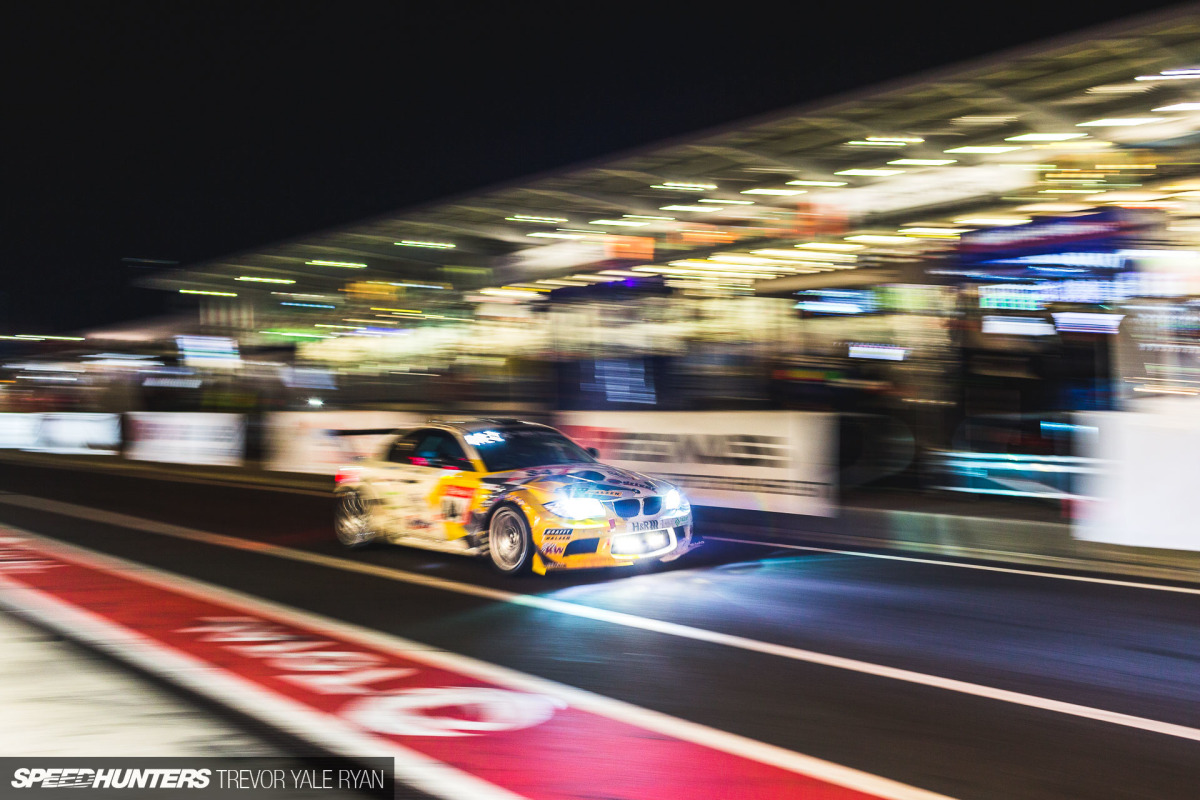
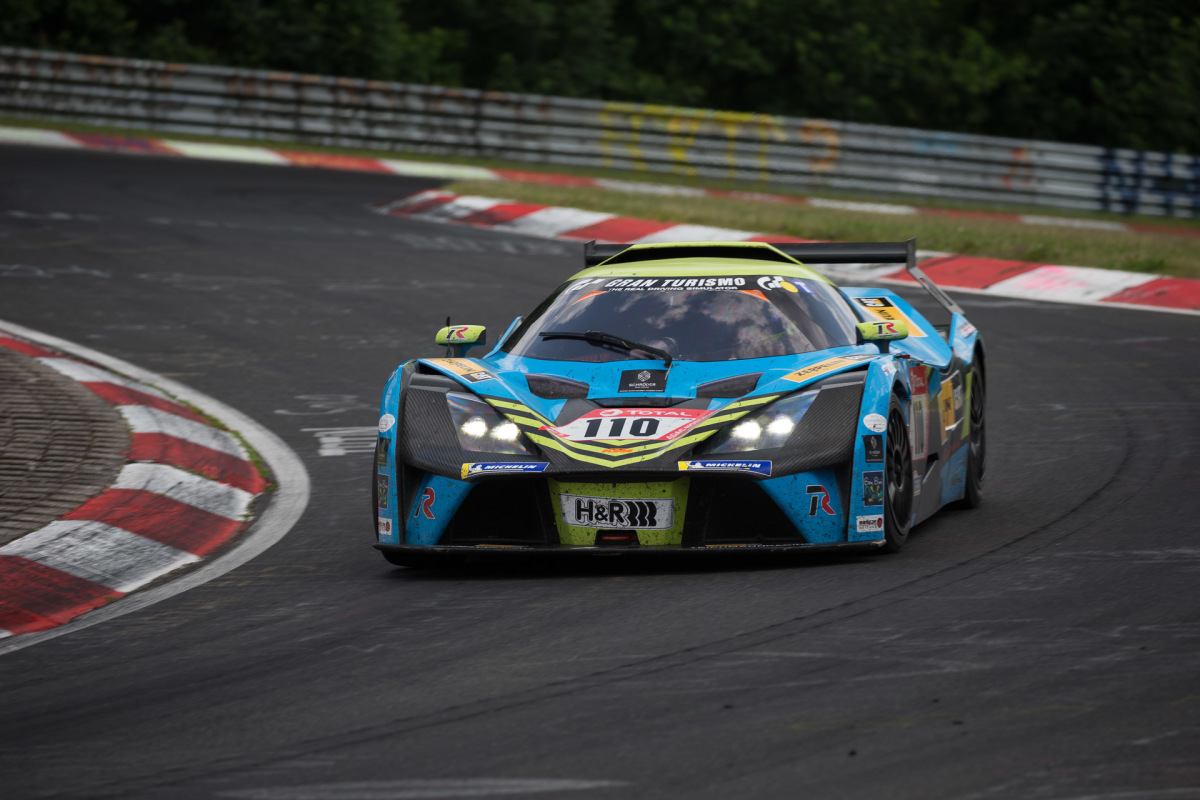
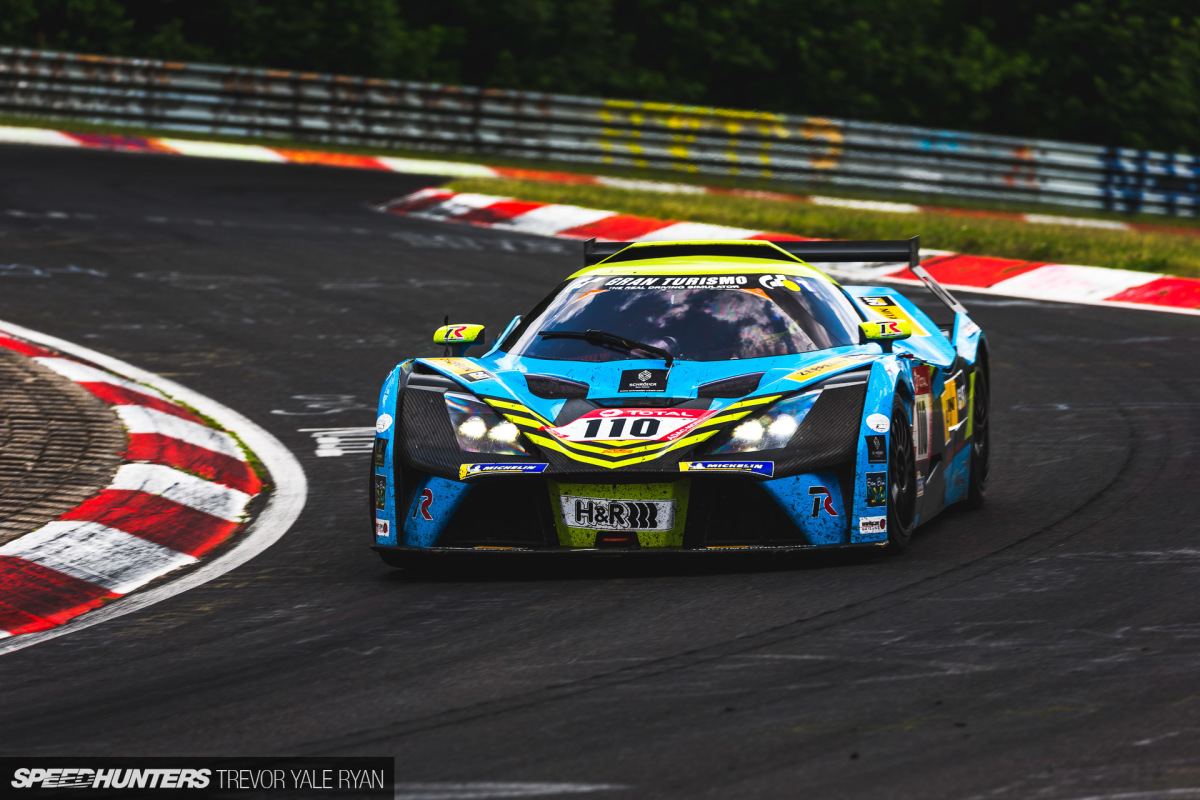
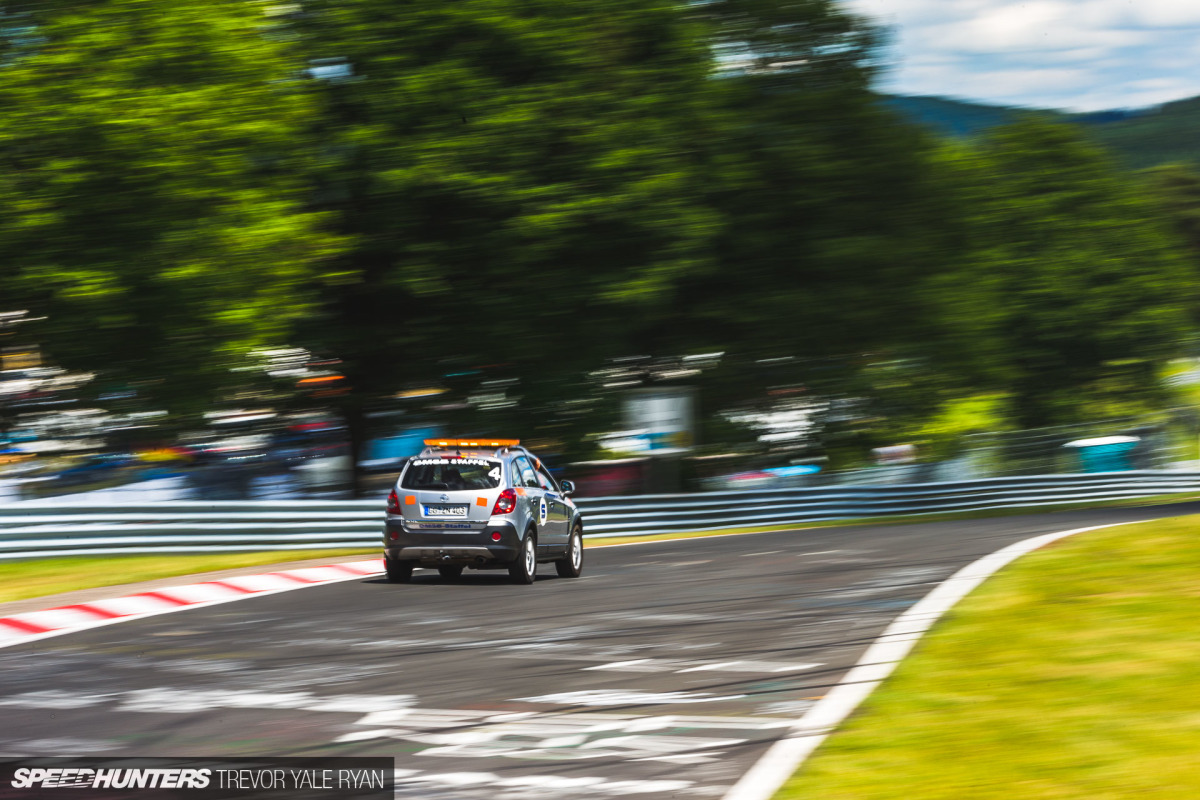
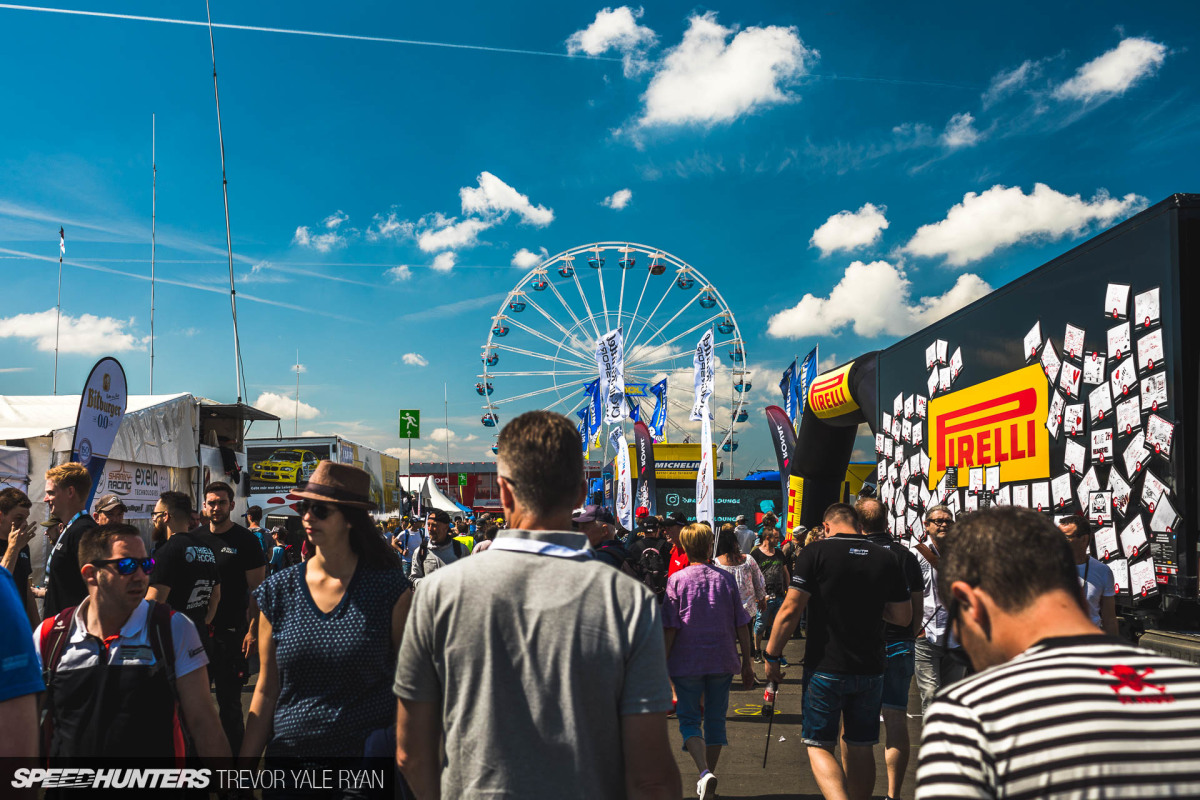
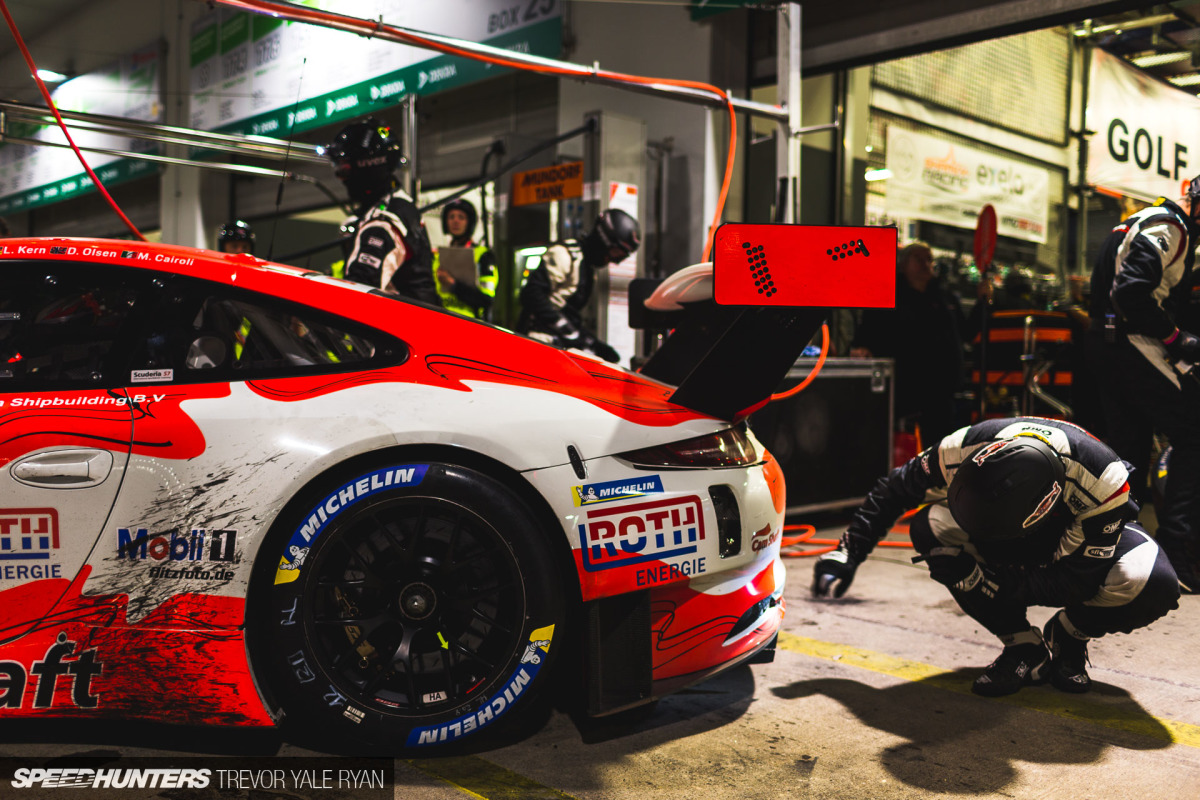
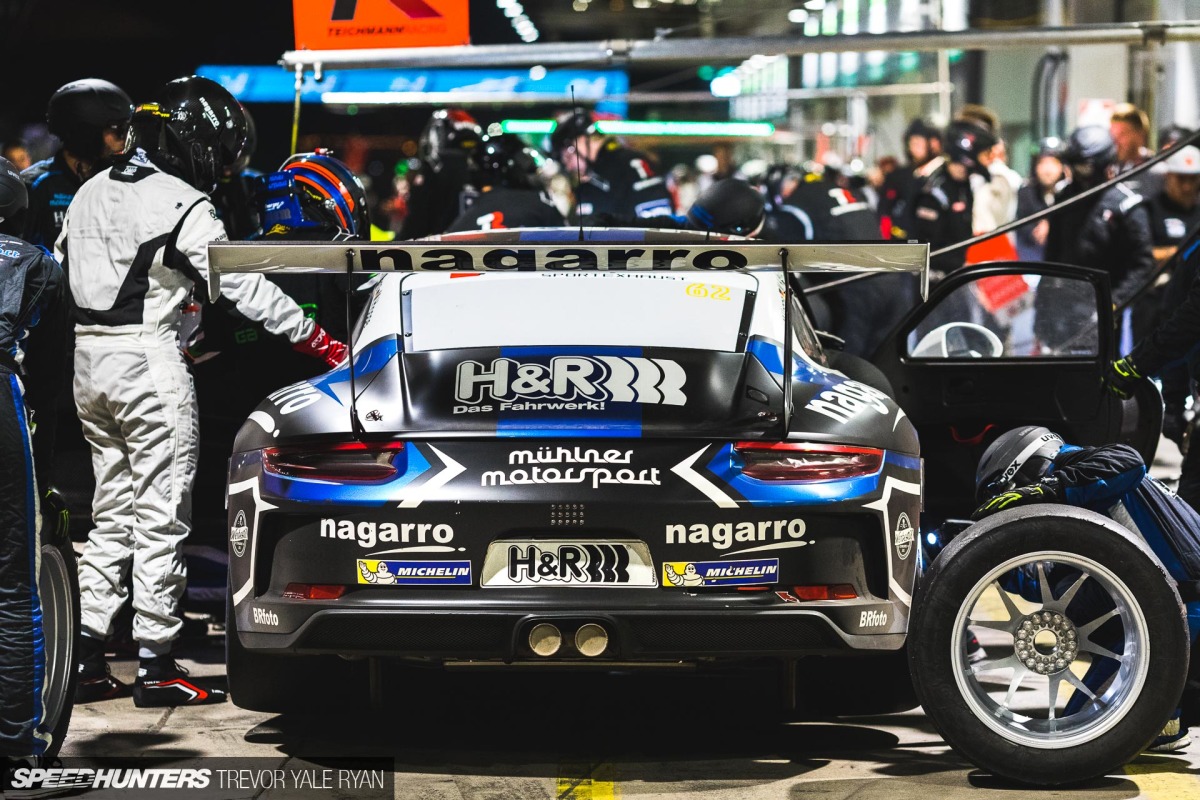
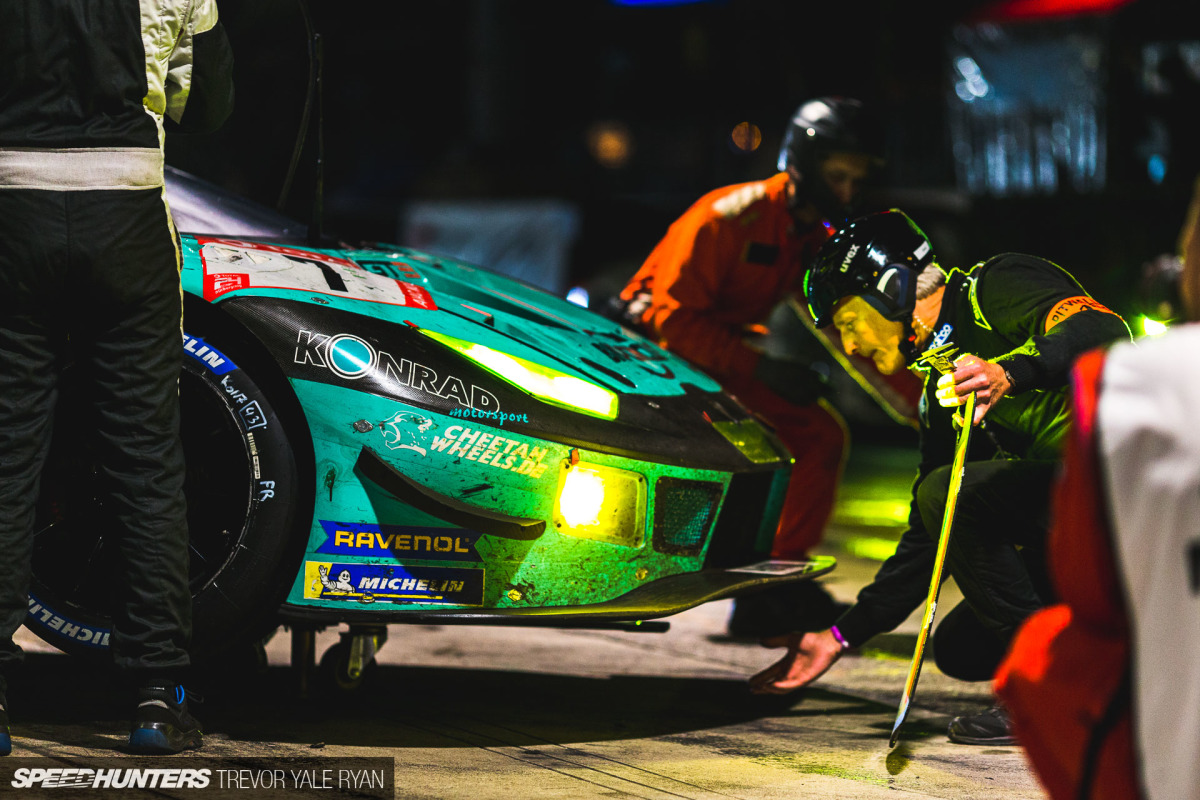
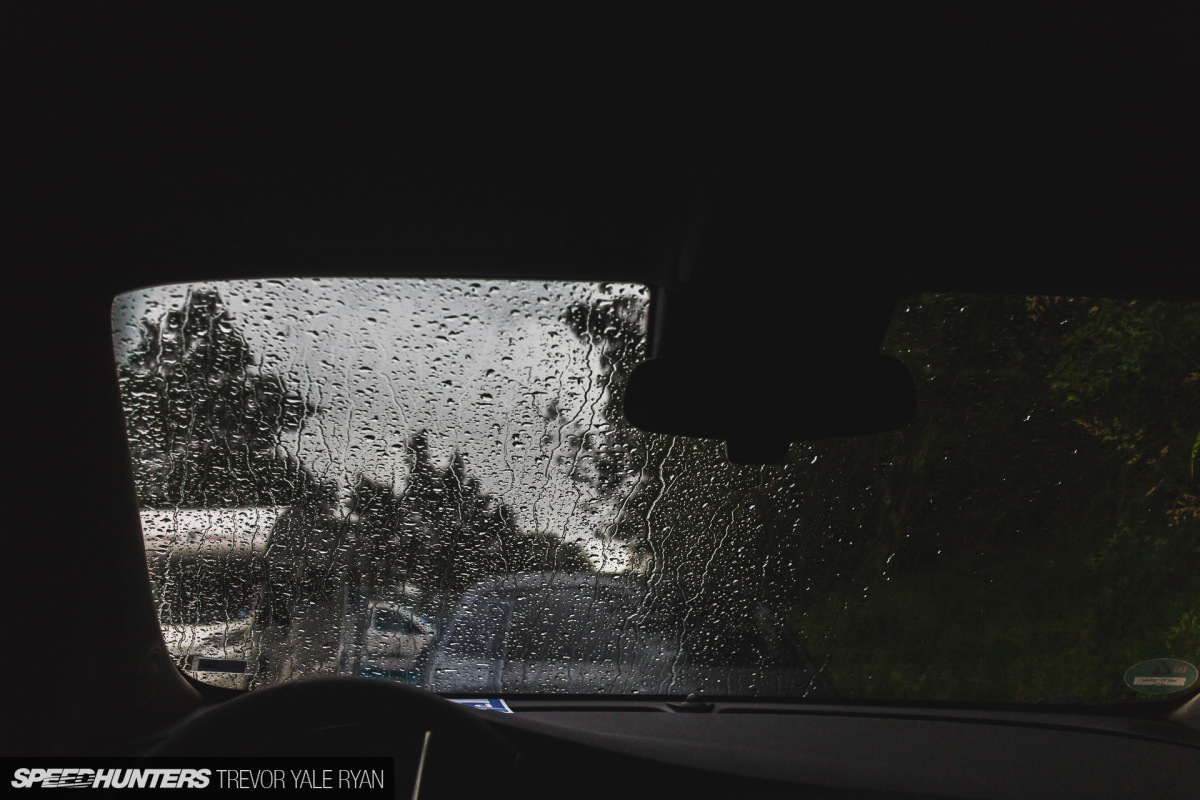
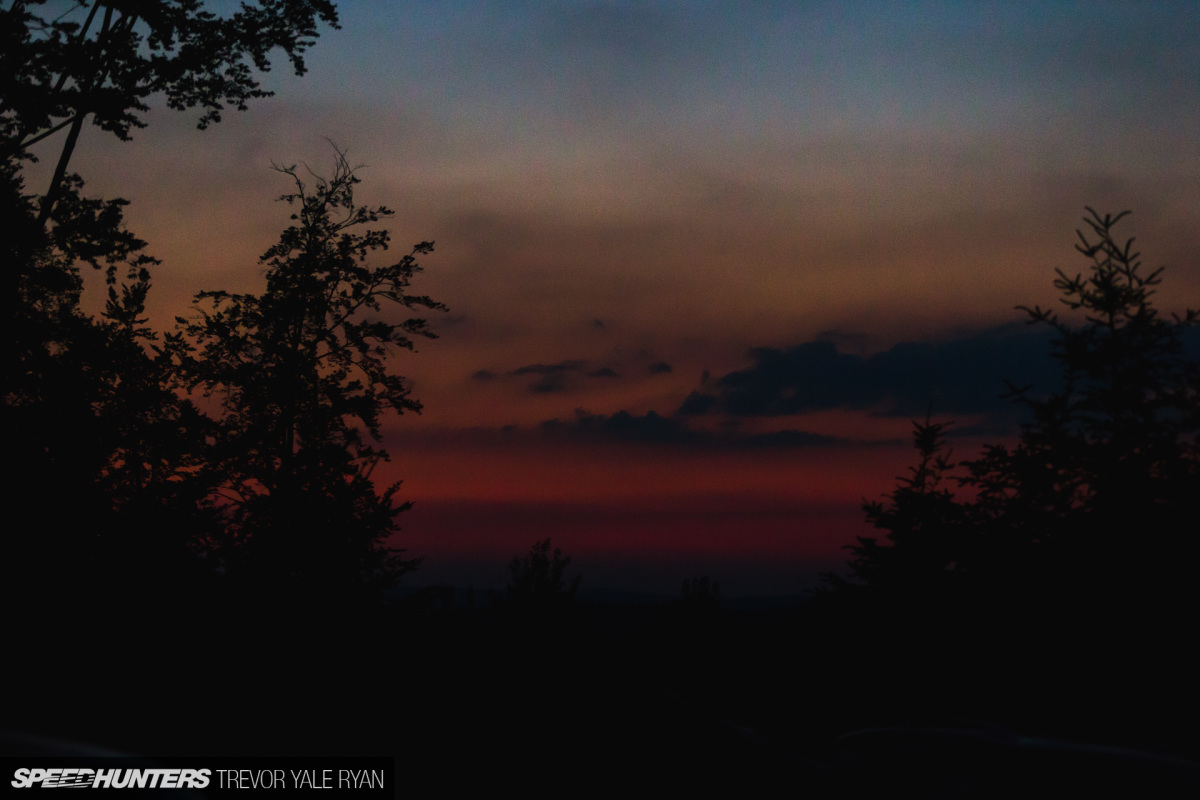
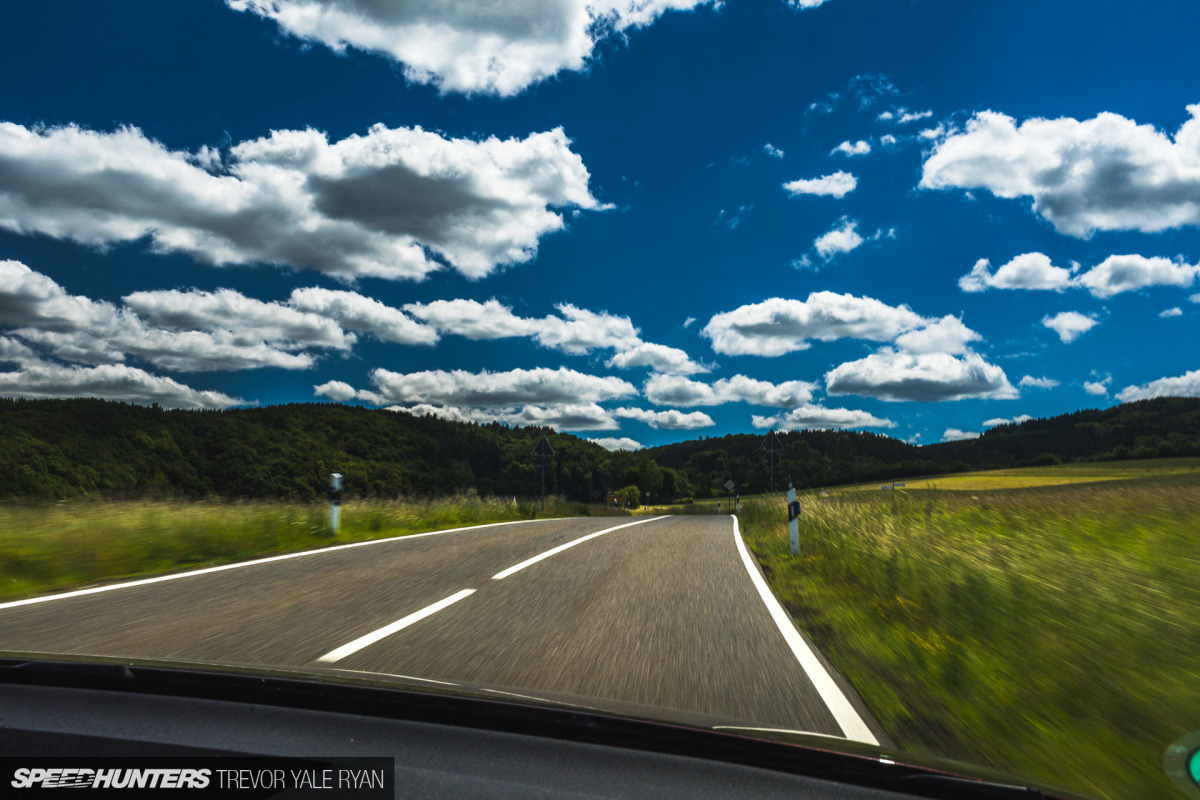





Great article, thanks!
One more question, if allowed: Did you have any special access like a press pass (I know you did for the media center, but I meant around the track), or could anyone with a ticket for the race get that close to the action?
Yeah, I had a media pass, no chance I would fly to Europe and spend four days at the ring without one.
The access is pretty fantastic without one though, but the angles aren't quite as good. I do have one last story coming regarding the fans which shows how close they are to the track.
There are some locations where media stands at the same spot as photographers or like 1 meter further. But usually, media is allowed to stand behind the guardrail, while visitors behind the fence.
Enjoyed reading this, especially remembering my own trip to N24 a few years back
Finally an article that shows the before and after post-processing of a few pics! Post-processing is certainly the part I find the most frustrating, and when I have a few good shots, I always struggle to make them "pop out" more, without looking unrealistic. So, being able to compare the before and after is certainly going to help.
Many thanks for that, and great article !
Yeah, post is a very necessary part of the process. I received this good advice when I got started: don't try to add something that isn't there. And stepping away from a shot for a few minutes and coming back with fresh eyes can help you realize if you've gone astray/overboard haha.
Going overboard is what I'm all about when post-processing, haha!
That's a good advice indeed!
In my personal experience, post-processing is the hardest thing to master. It's a bit like composition, it's all about sensibility, more than pure technique. Iso, shutter speed, aperture, are in the end fairly "easy" to grasp as concepts, so once you understand what they are, and with a bit of logical thinking, I believe you can quickly learn how to use them.
But post-processing... Damn, that's like learning chinese to me. It's easy to notice that your shot is bland, but why? and how do I arrange that, with what tools? Again, there's only hard work and dedication.
Regarding post processing, as a beginner, I think the most valuable lesson I learned so far is that less is more.
I really need contact on that guz with modifed instax ! those photos looks epic !!
His Instagram is linked below that photo
Awesome article Trevor! This year has been my first year really taking my photography seriously, and I've found many of the things you've said to be true (especially about practice and that every time spent behind the camera should be educational, regardless of how good the photos turn out). One thing I will try though is messing with the tone curve and adding some saturation. Thanks!
I love articles like this, I have a fairly basic DSLR set-up and shoot when I get a chance, certainly nothing serious, but am always keen to learn more about technique.
I really appreciate the before and after pictures, for me, I always feel like I'm struggling to get good shots when I see my raw images on the pc screen, but knowing that most peoples shots don't turn out the way they're published makes me that little bit happier with my own shots!
Thanks for taking the time to write a post like this
Trevor,
Nice article and this gives some insight to others about the amount of post processing work that no one sees. The countless hours on the computer picking through photos and editing. I started shooting automotive photography 6-7 years ago and fell in love with it. I was shooting with a 7D MKIII at the Cars & Coffee in Irvine, California. I have been building cars for 10 years at this point but had never taken the photography seriously. My wife and I are wedding photographers and use our 5D MKIV and have learned over the years that any chance to shoot something I take it because you are right in the fact that you learn something new every time you shoot. It doesn't matter if it's landscape, portraits, or action. You can take something you learned there and apply it to another.
Something that was a game changer was shooting for your final shot. Basically shoot to not edit. This involves making sure all your settings are spot on, exposure is correct, keeping ISO down as much as possible, adjust white balance, and framing in-camera(no cropping). Before we would spend 5-6 hours editing and now we are done within 1.
The other thing is that we shoot with prime lenses as much as possible as the final result will be better. It makes you work harder to move around and you end up with better shots in the end. Sometimes you have to have the zoom but if you challenge yourself with primes you end up shooting from angles you would otherwise ignore.
It's sad that social media is a place where the first option is to bash on someone that is clearly dedicated and is living their passion. How about we come into your workplace and scrutinize everything you do? The loudest in the room is also the weakest and never forget that. True enthusiasts understand that everyone is here for the same reason. We love cars and everything about them. Cheers to you for the hard work and the images look awesome.
Yeah I've noticed over the last couple years my editing time has gone from approaching infinity to a few minutes per photo. Varies set to set.
And yeah, you couldn't be more spot on about social media and criticism and all that. It comes with the territory, and feedback is nice when it comes from a good place.
I agree with this wholeheartedly. Although, there is something to be said about criticism that comes from, "not the internet comment section." I see way too many creatives getting so bent out of shape and butt-hurt because the viewer or audience "doesn't understand my vision" or "you're just a hater". If you find yourself impervious to criticism and think everything you do is great, that isn't healthy either. It's a give and take. And you have to fail a lot to get somewhere to a place of merit. Criticism is good thing.
First of all, your mom should be proud of you. Second, this was a great article. I'm at this turning point right now. My day job is a graphic designer, but with the workload and stress, I've deeply enjoyed getting behind the camera more. And like you said, I'm just trying to get out there and shoot everything. I had a poor mans setup, 1 body, 1 lens (18-200) so I have to make due with that. I was recently at a track day and I wanted to capture the essence of speed. So I dropped my ISO as low as possible (which is apparently 100 on a Cannon 7D) and maxed out my aperture and went to town.
This article made me feel good because it's basically where I'm at. I'm not really sure what I'm doing, I'm getting decent results, also taking a lot of shit pictures in the process. My track day was 5,300 photos and my final edit was about 250. While I know I shouldn't compare myself to Speedhunters greatness, or others for that matter, it's hard not to. You are living my dream. Would I love to be exhausted and sore and tired from shooting races, hell ya I would. I just don't know how to get there. That's the question...how do you get from guy who doesn't know what he's doing and doing it for fun...to guy who doesn't know what he's doing but gets paid for it and works for Speedhunters.
Also, I loved the side-by-side of camera JPEG to final export. I actually really like looking at the before and after. I think the most important part of the post-processing is remembering what those colours really looked like and trying your best to get those back in post. I tend to keep things as true to life as possible. I find myself afraid to get crazy with edits as I don't want it to look like it's been overdone. And doing some photoshop Frankenstein works fun. I do it at work alllll the time.
Keep up the great work, and stay true. I appreciate the honesty and humbleness. You are a great photographer. Like I said, your mom should be proud of you.
Thanks for that, I appreciate it. I just worked really hard when I was in school shooting as much as I possibly could. Good luck and a series of circumstances saw me getting in here with the iamthespeedhunter program, which is still very much alive.
I took over 10,000 shots at the N24, only will publish a couple hundred probably. Track days I do between 2,000-4,000 and edit what sells, typically 400-600 images, but I'm using pretty safe settings there.
I don't want to be a downer, or throw you off shooting professionally, but every profession comes with workload and stress. Doing what you love is what makes it worth it. It is a battle to become a professional, but once you do, it will be worth the hard work. Keep shooting as much as possible, always experiment, develop your own "style", never stop being a student - soak up every bit of information you can and get your face out there and your work in front of as many people as possible. Being a graphic designer gives you an artistic edge over most people, but I would suggest not quitting your day job until the photography work can give you a income you can live off. Just some lessons I have learned along the way....
Oh I know evey profession comes with its headaches but I've found the photography aspect of being creative is my happy place. Sure I still get stressed and tired, but there is a lot more heart in passion in my images. And I shoot anything and everything, not just cars. I would only quit my day job to get another day job until I'm Speedhunters worthy or getting paid worthy.
Definitely being a designer aids in my photography, but I've been shooting a hell of a lot longer than designing. I really love design just not where I'm doing it. I'm just happy to be creative. And I'm not confident enough in my photography to go in head first as a professional photographer. People have referred to me as one, but I don't consider myself to be one. I know I still have a lot to learn, to improve on, and to invest in more gear. At least have 2 lenses haha.
Jay_Bee - I'm in a similar boat to you. I studied design in school and graduated to an office job. I work the office job, but also started really pursuing photography. I learned a ton online and keep learning now 10 years later. I wanted to shoot cars and motorsports, so I started by going to car shows and would ask people to do free shoots.
After showing those on FB, I started getting more requests for shoots and also to do weddings. Portrait work and wedding work are what pays most in photography in general, so I started to learn more about portrait work and how to shoot weddings. As I got paid for events and portrait work, I invested in my gear to help give myself more options to shoot different things. I have done a variety of work from architecture to food, newborn sessions, weddings, a million family sessions, etc. I still have my day job, but photography gives me and my wife more money to spend how we want and allows me to reinvest in my photography business.
If you want to get into this field, you have to treat it seriously and continue to pursue it and post up online even if you think no one is looking at your shots. Post on FB, call out to friends in posts asking to set up shoots soon and work your way up from there. Even if you don't make a ton of money, you will likely get to know some really cool people.
Oh I'm right on track then haha. I shot my first engagement photos this year, shooting a wedding later this year, hitting up as many car shows and track days as possible. I post to Instagram constantly. Not gonna lie, the interaction and engagement is lower than I'd like but at the end of the day I'm doing it for myself. I'll keep the daytime design job but I'm always working towards that goal of being a successful professional photographer. Glad to know I'm doing the right thing.
Yep, we sound very similar, but I may be just a little further down that road. My social media engagement is low too, but I have a steady stream of people wanting sessions and lots of repeat customers. So I take those last two points as all the affirmation I need. Think about posting in local groups like neighborhood groups, local areal groups, and car groups in your area.
If you shoot Canon, check out the original 5D bodies (look up 5D 12.8 on ebay) and the original 35 f2 plus the 85 f1.8 lens. Buy 2 5D's, put the 35 on one and the 85 on the other and you are all set for weddings as long as the lighting isn't terrible.
My setup is 2 6D's, 35 f1.4L, 50 f1.8 STM, 85 f 1.8, 135 f2L. I also have the EOS M and EOS M5 for personal shooting and I use the EF-M 11-22 lens on the M5 for wide reception shots. 2 Godox V860ii flashes. Mostly shoot with the 35L and 135L on two bodies for almost every paid gig whether cars, portraits, weddings, etc. This is a pretty well rounded budget friendly setup for pro work. This has taken me a ton of time to earn up to and I've sold lenses to buy better lenses, etc. Sometimes selling everything to start from scratch and get a step up.
Also still shooting cars, bikes, and some motorsports despite being mostly a portrait photographer now.
Thank you for this! Your shots are literally my favorite action shots I see here and on IG. I have been feeling stale for quite some time now after having my 40D for 10 years or so. I just felt like I lost the fire and didn't even want to upgrade for the risk of spending the money while not yielding and better results. I was approached by a friend who sold me their 6D Mk I and I have renewed enthusiasm/passion and now find myself wanting to shoot everything. The difference between the 40D and the 6D is ridiculous. I also got my first circular polarizer filters and have no idea how I have taken as many photos prior without having one!
I like learning more about your photos especially with the settings. We both seem to almost exclusively prefer low down shots with low f stops. I wish I had the patience and know how to edit but I tend to leave my shots as straight out of the camera. I should make editing software the next purchase...
Thanks for continuing to provide us with amazing captures and this great feature with insights into your process etc.
Brandon
Thanks Brandon! I started with the 40D myself. As for post, look into Lightroom, or Capture One if you want to go against the grain. I haven't made the switch over myself as I'm too reliant on my experience in Lightroom to get work out the door, but if you're learning new software anyway you might find Capture One to be more powerful (I find it overwhelming). I think both have a trial.
Hold up, This is the one of the few posts where a piece of gear caught my eye more then the cars, was that a instax with a Medium format (maybe 4x5?) lens attached?!
I thought I was immune to GAS but hot damn, I have a softspot for those instax and the it would be great for meets and shows
Ps. great article, wouldn't be shooting today if it wasnt for you guys, and these guides helped alot when I was cutting my teeth